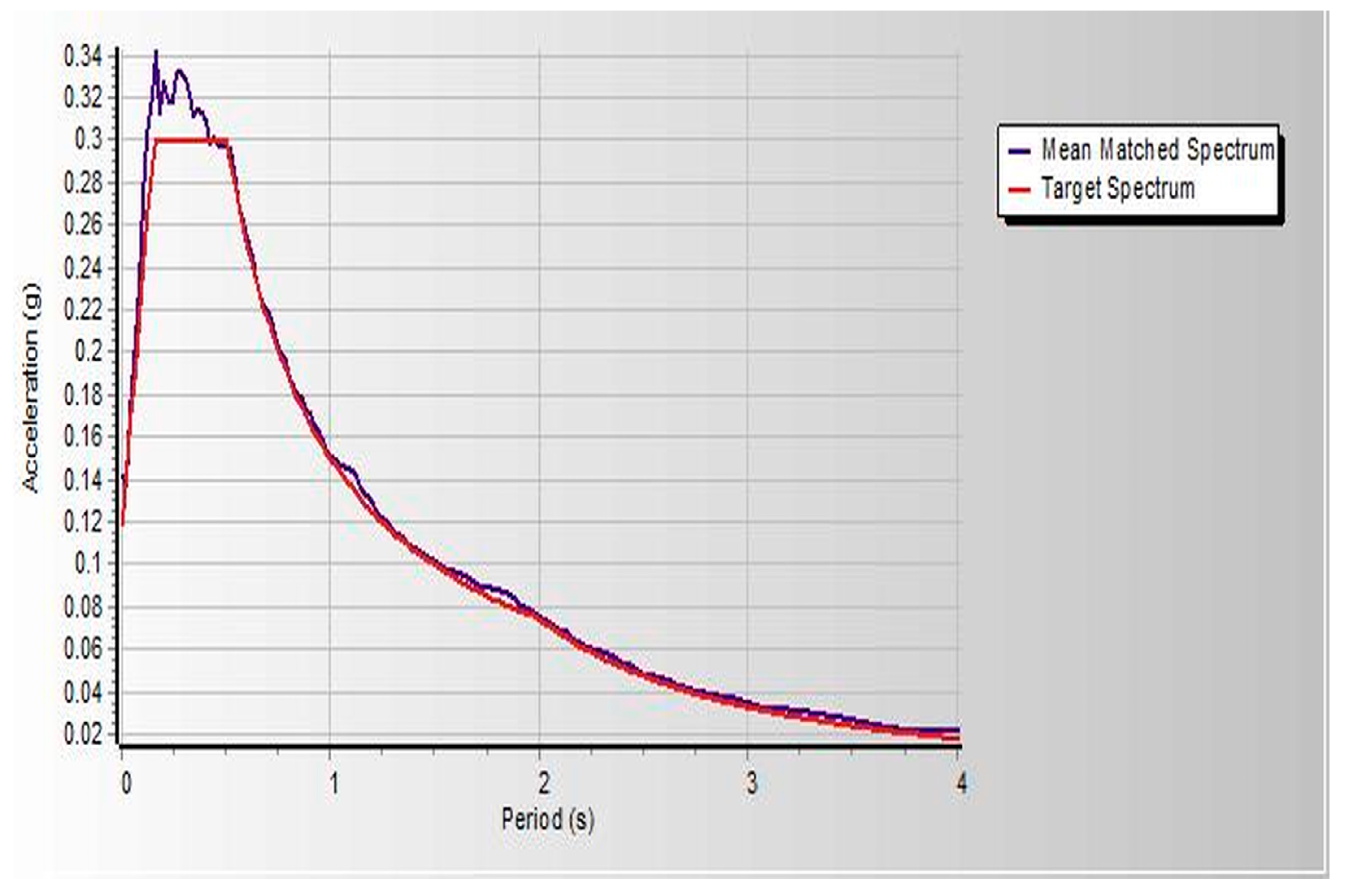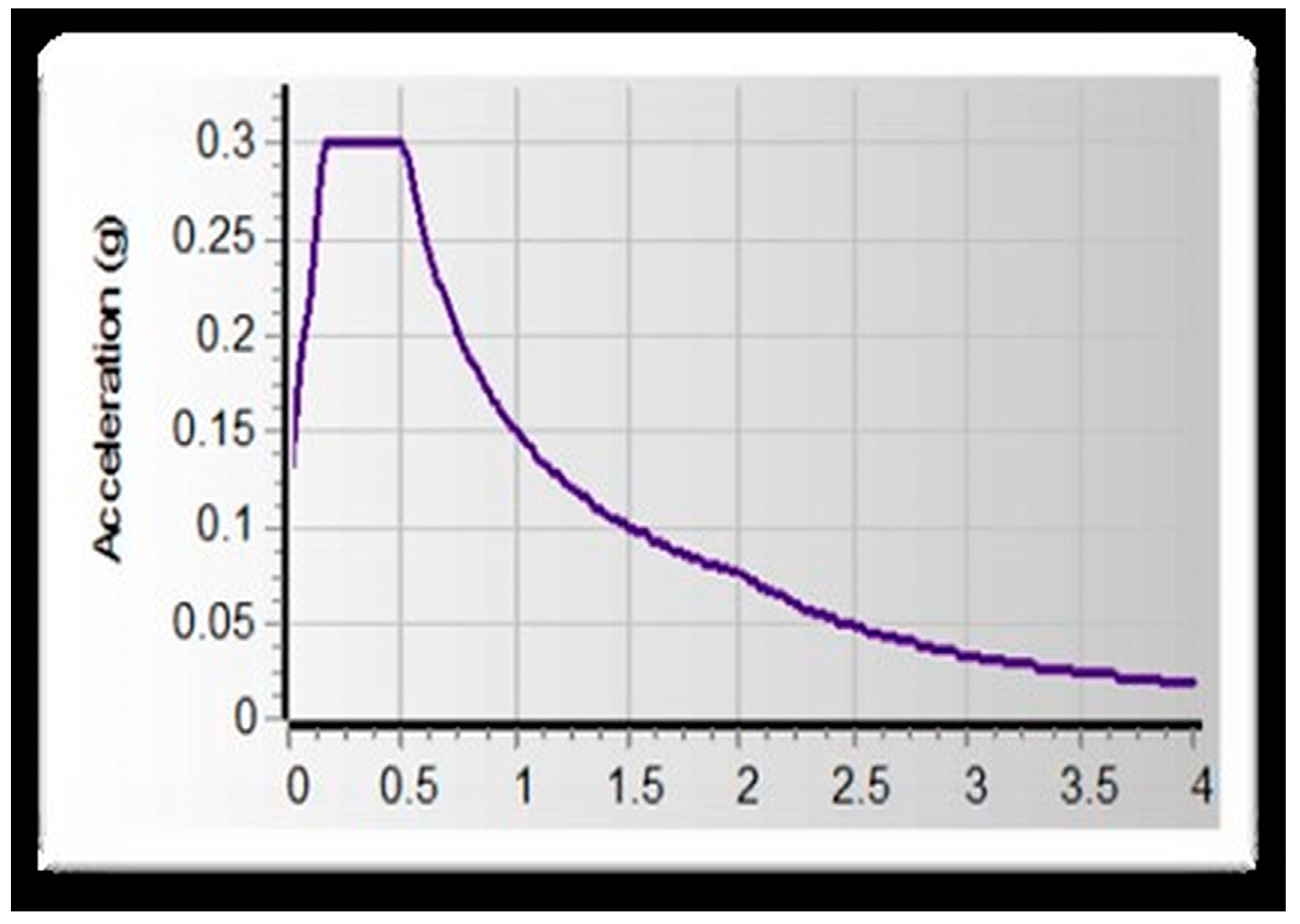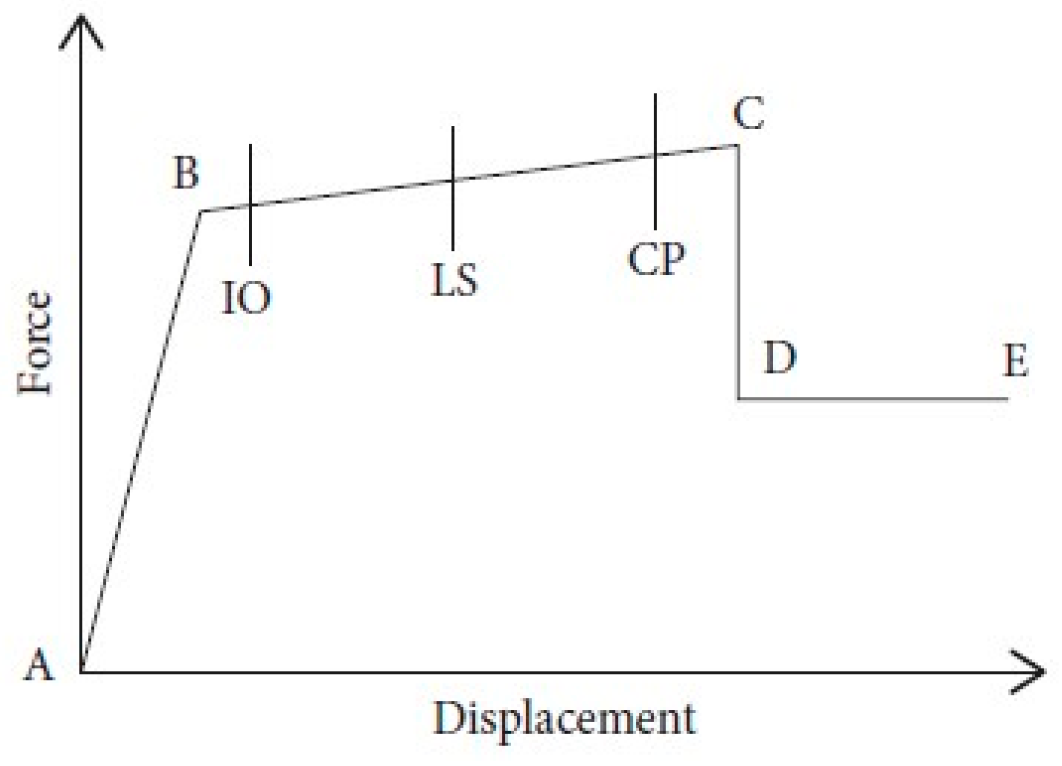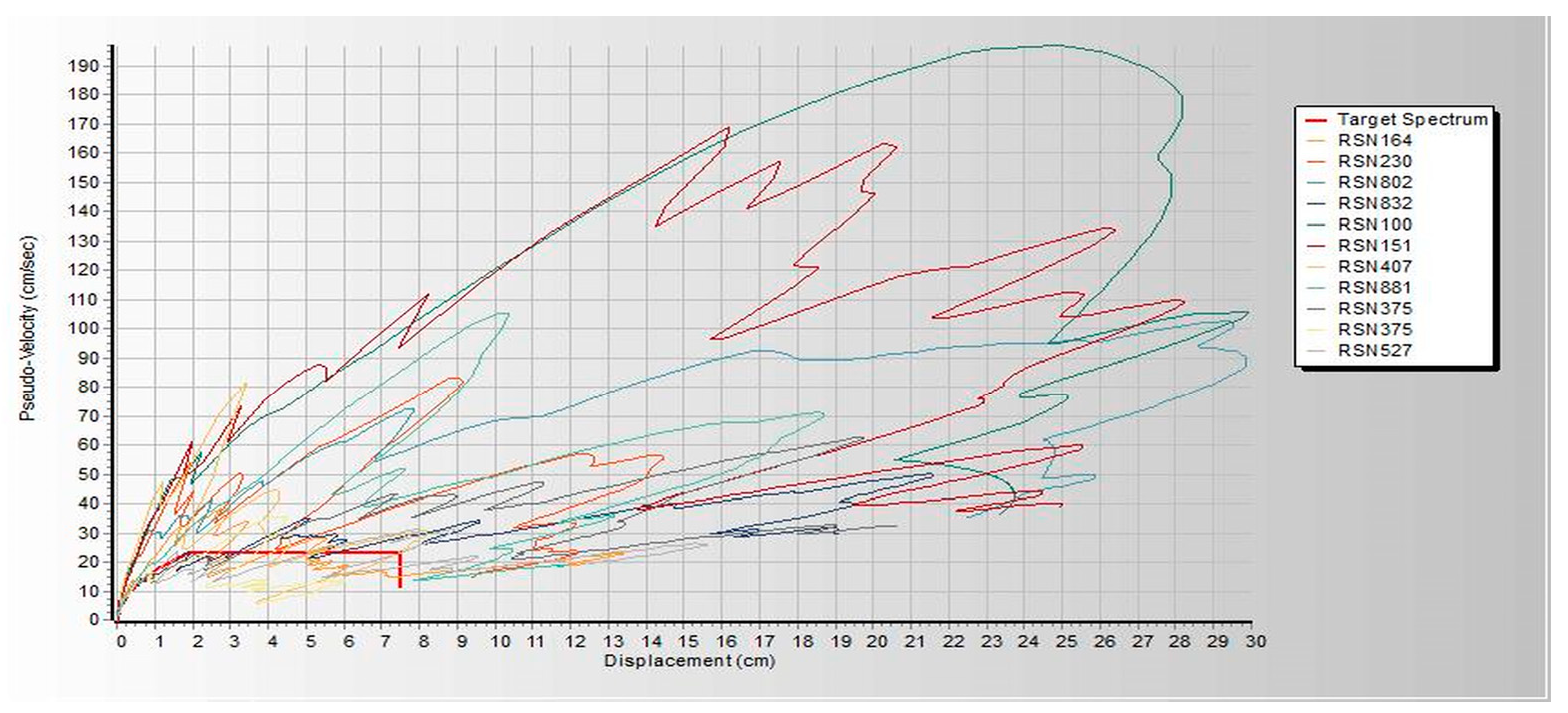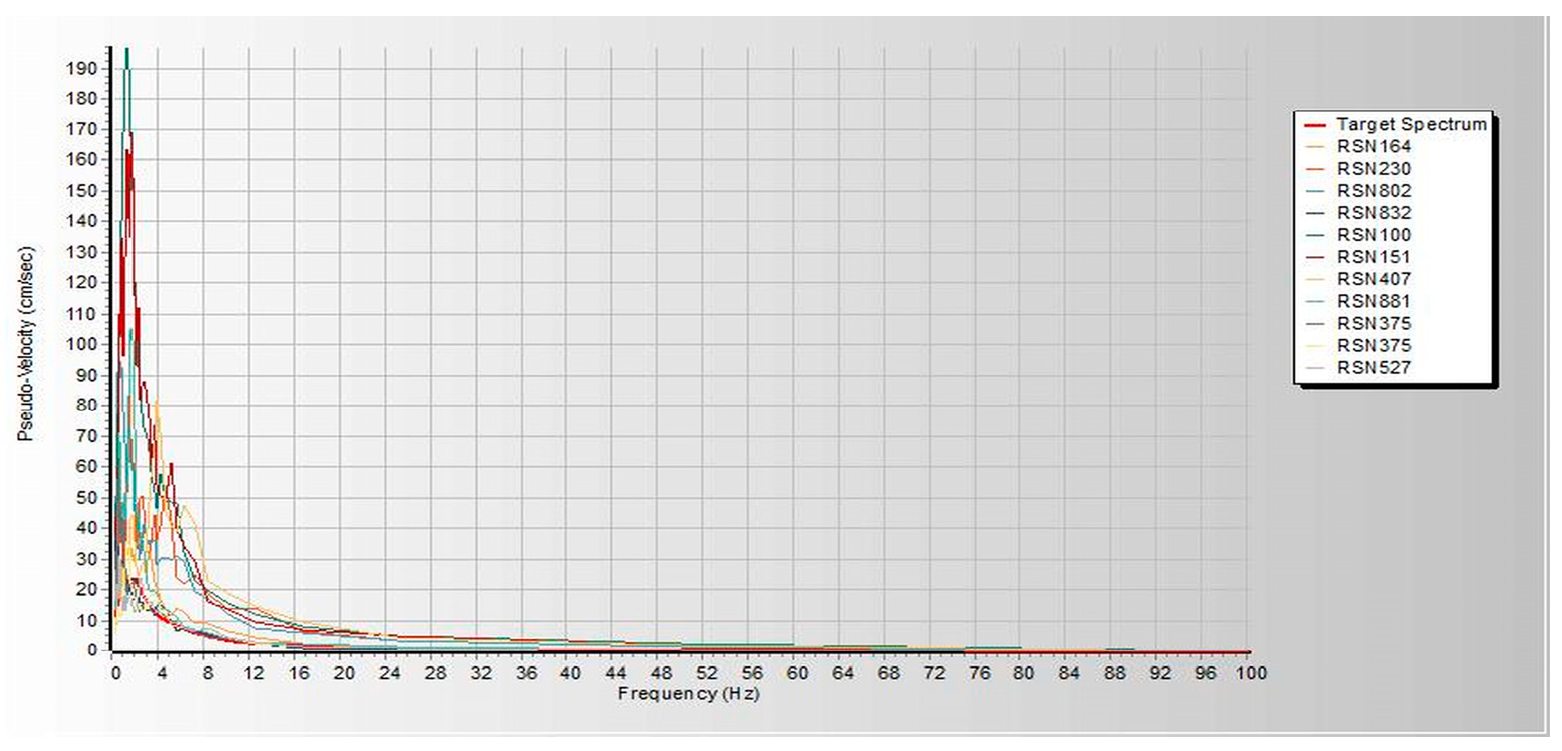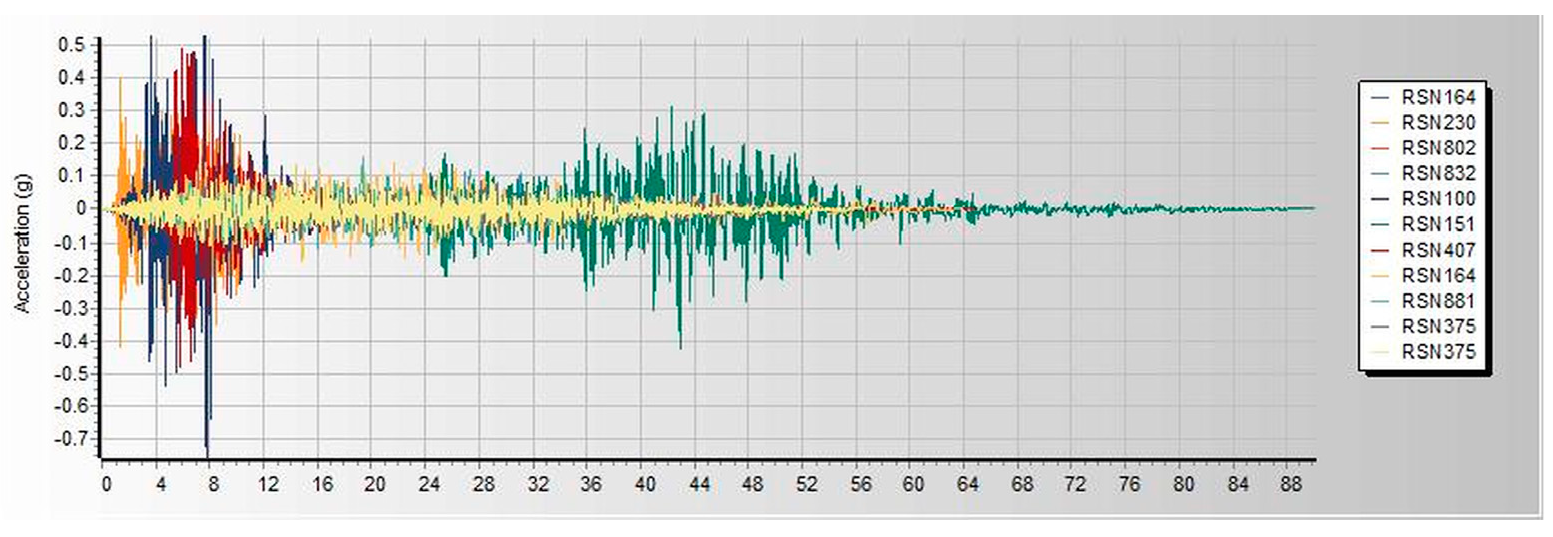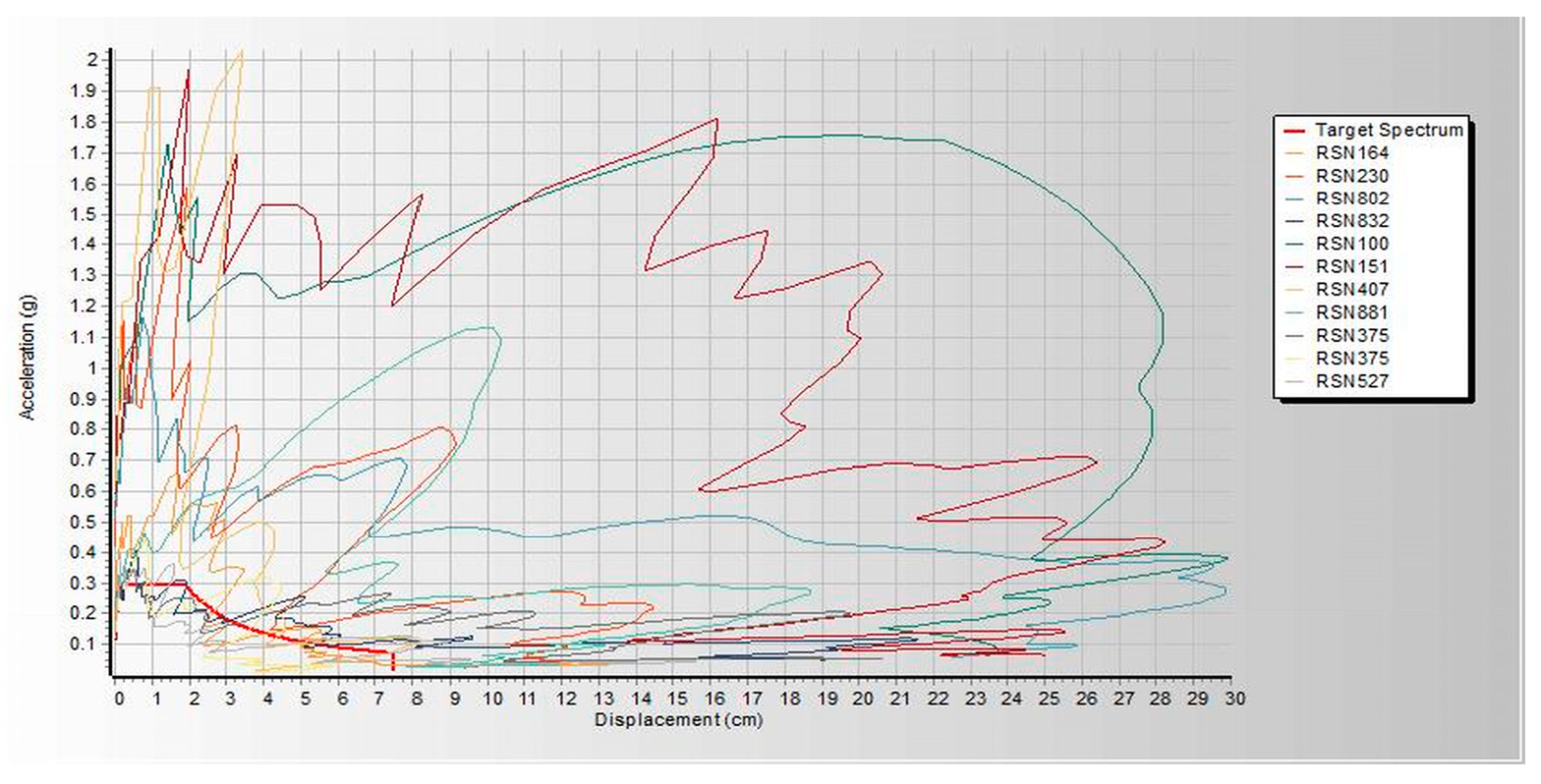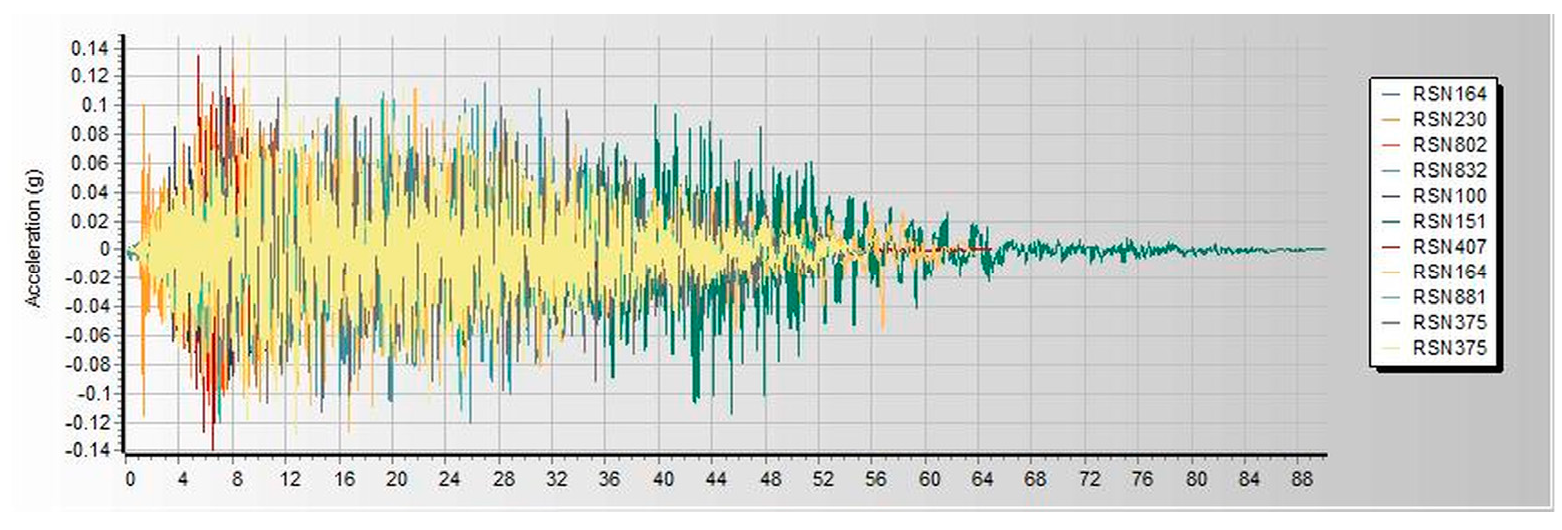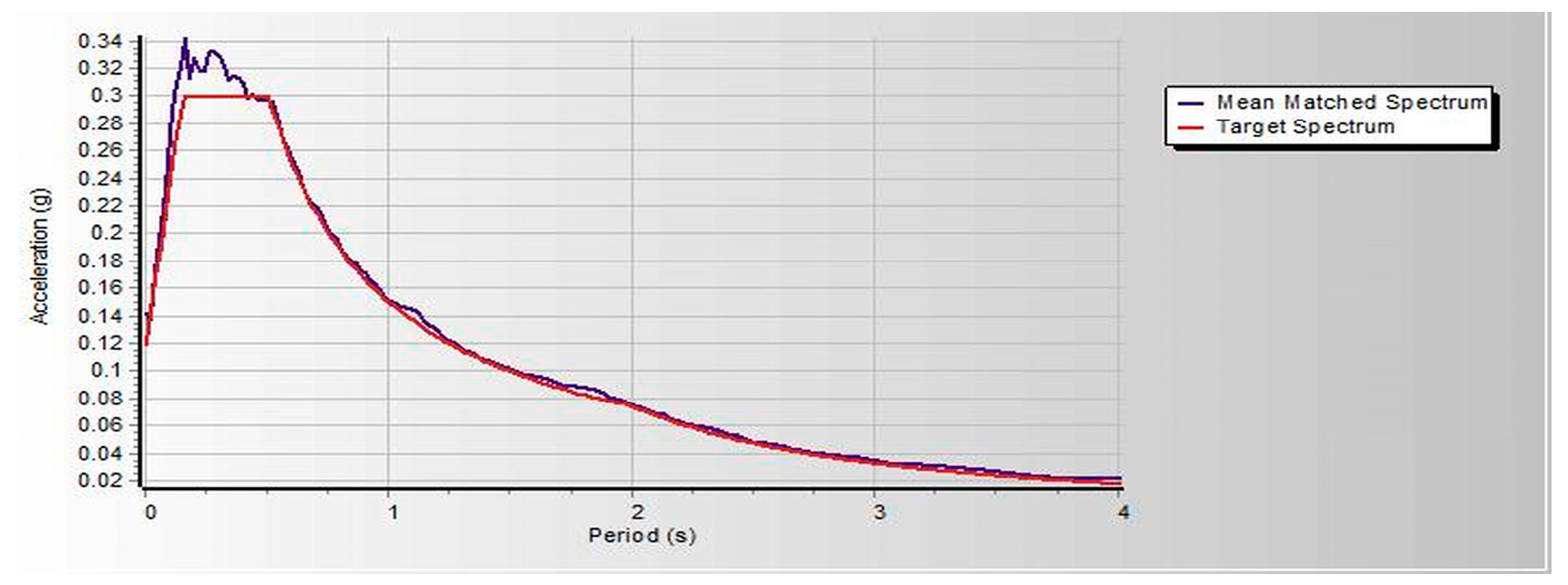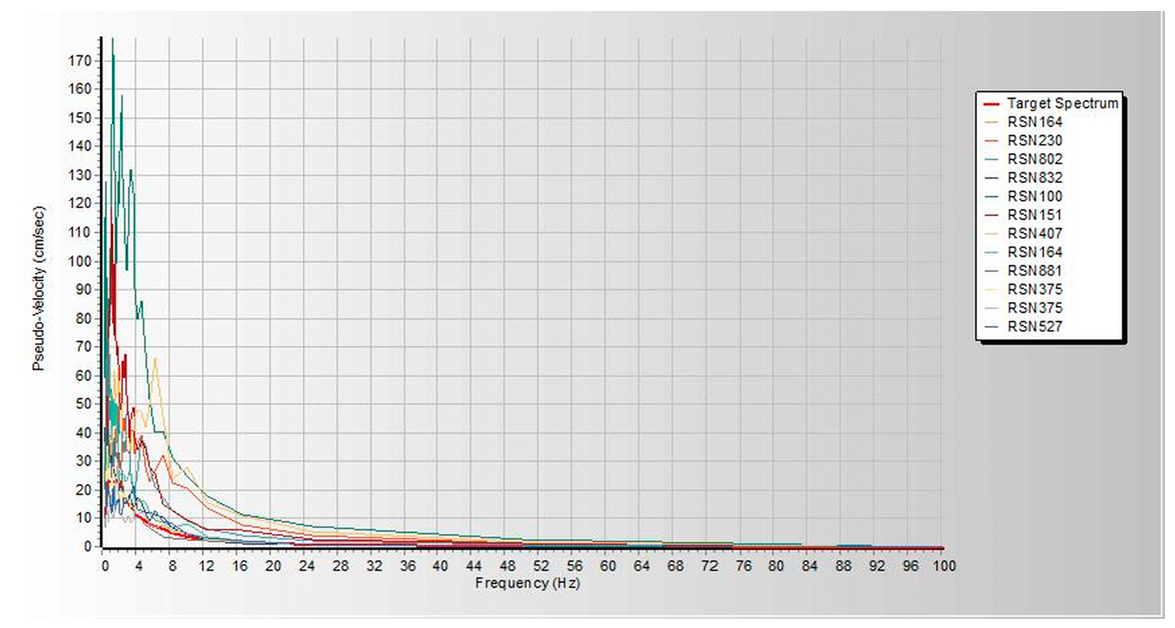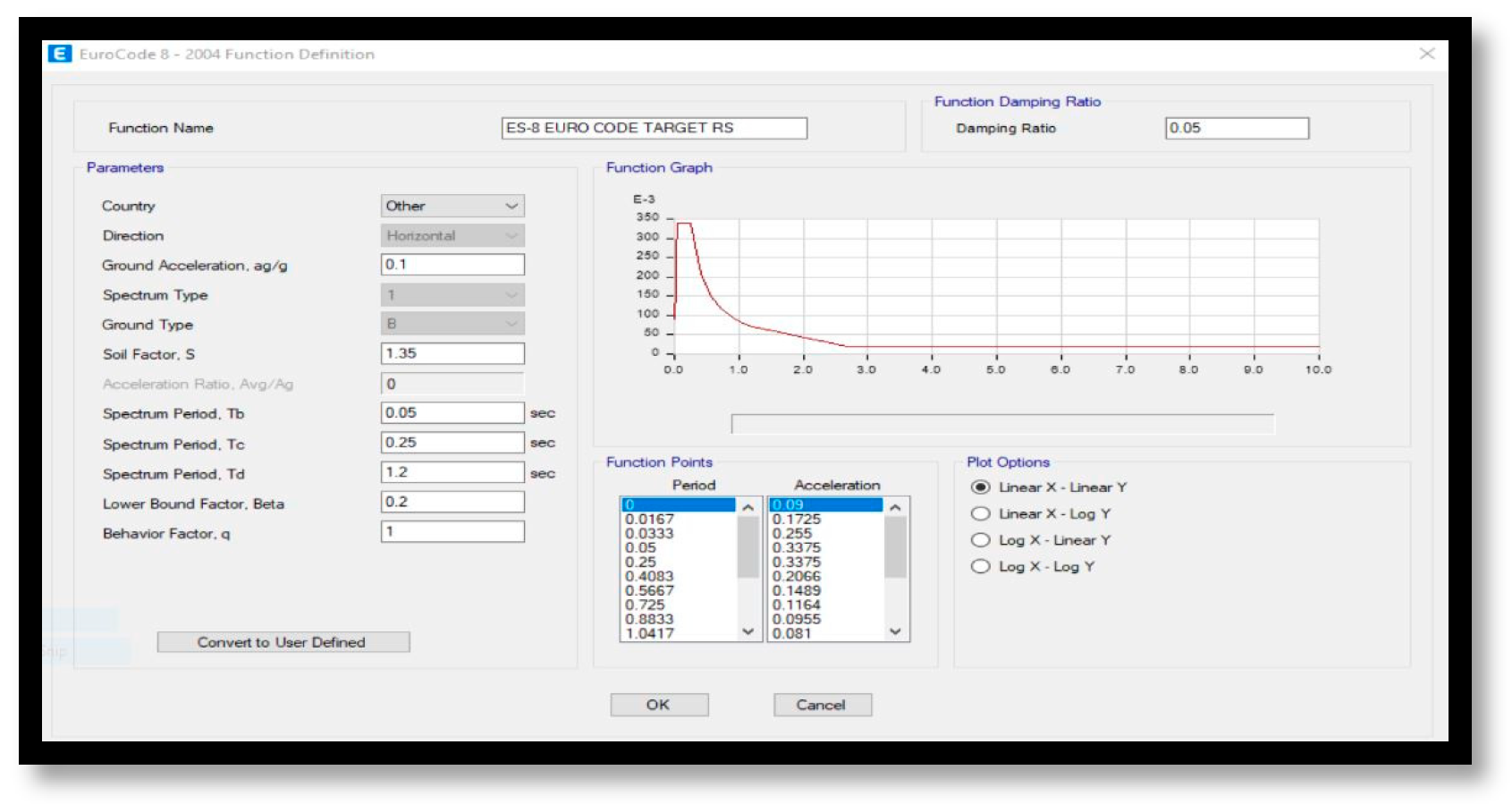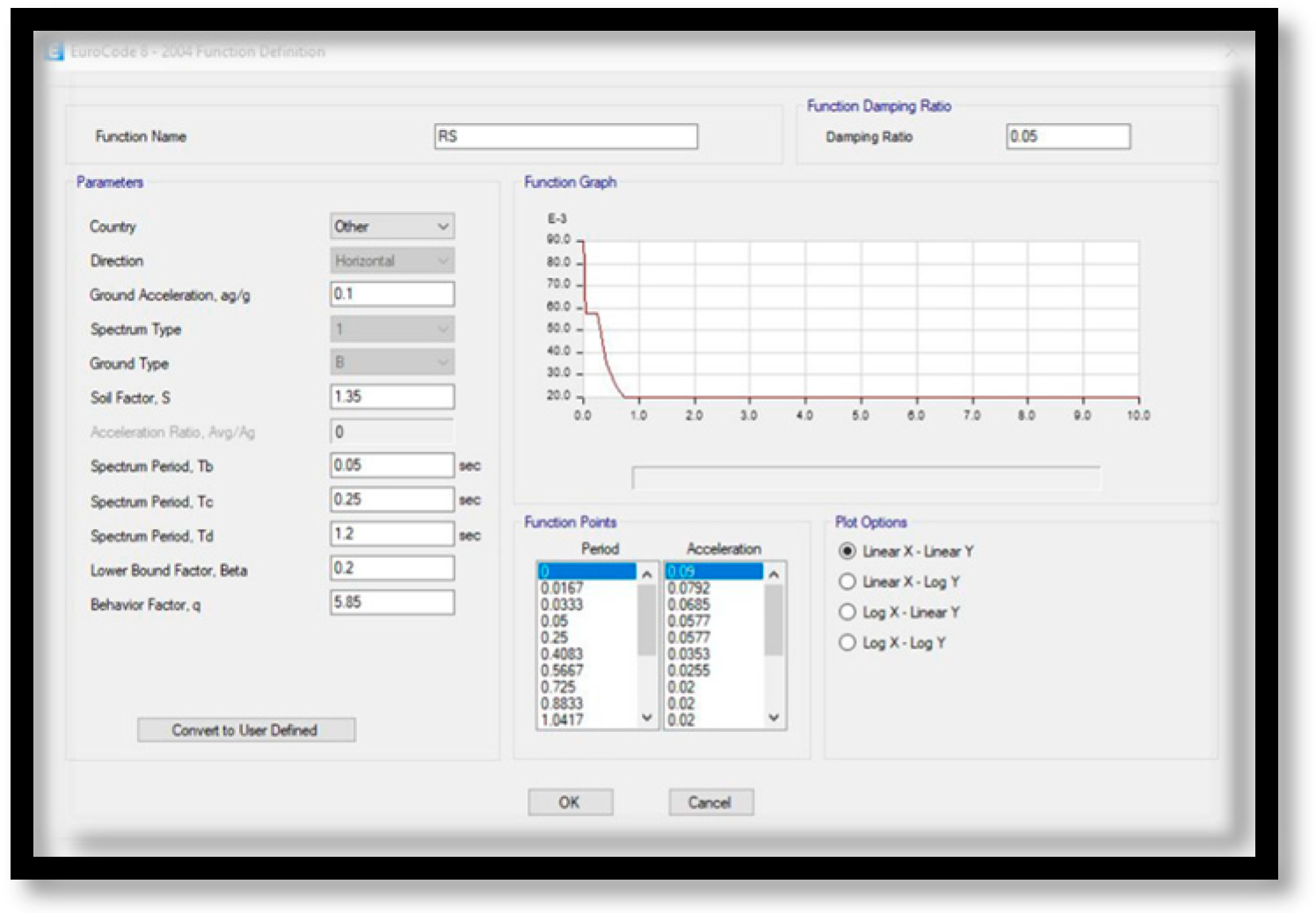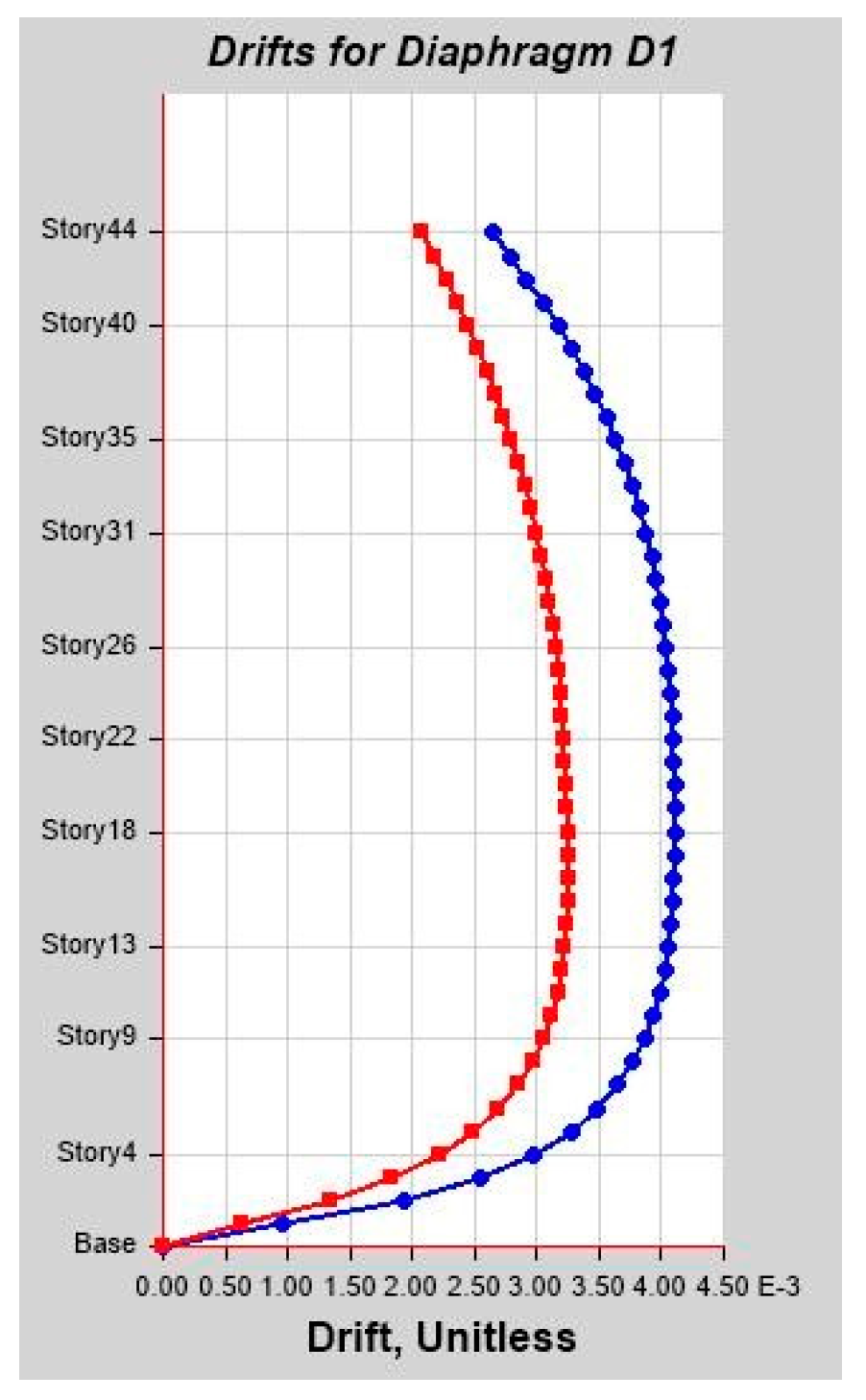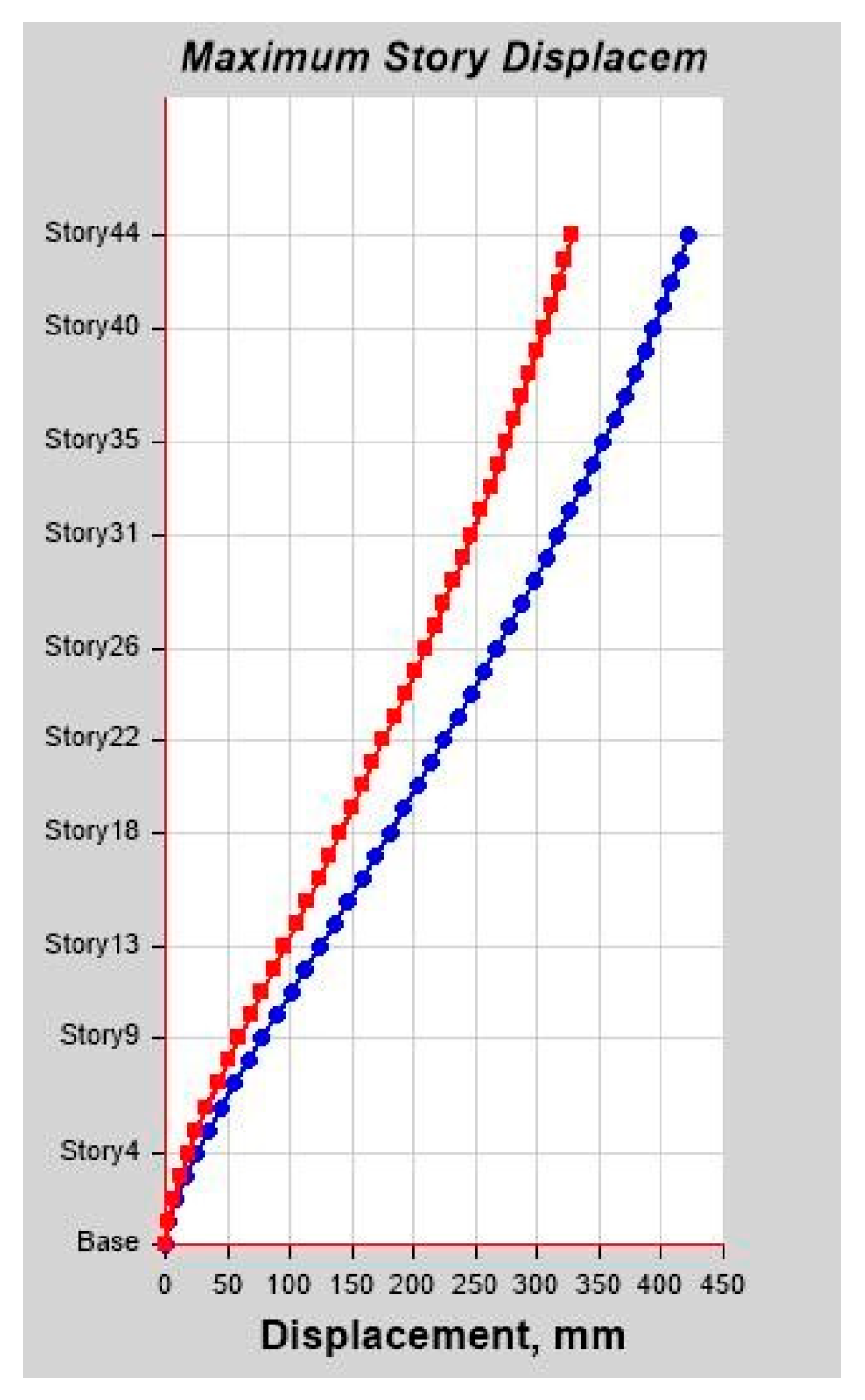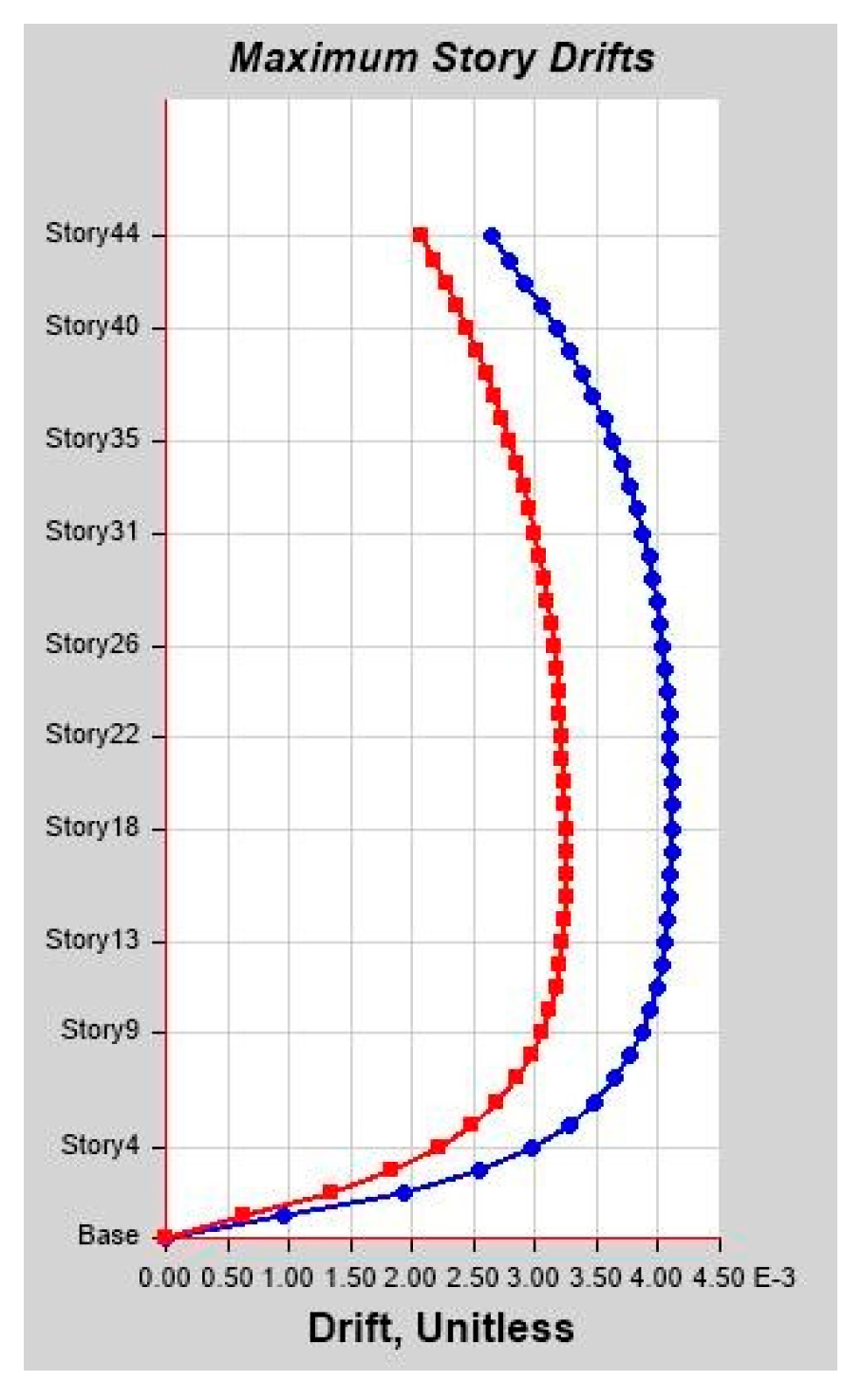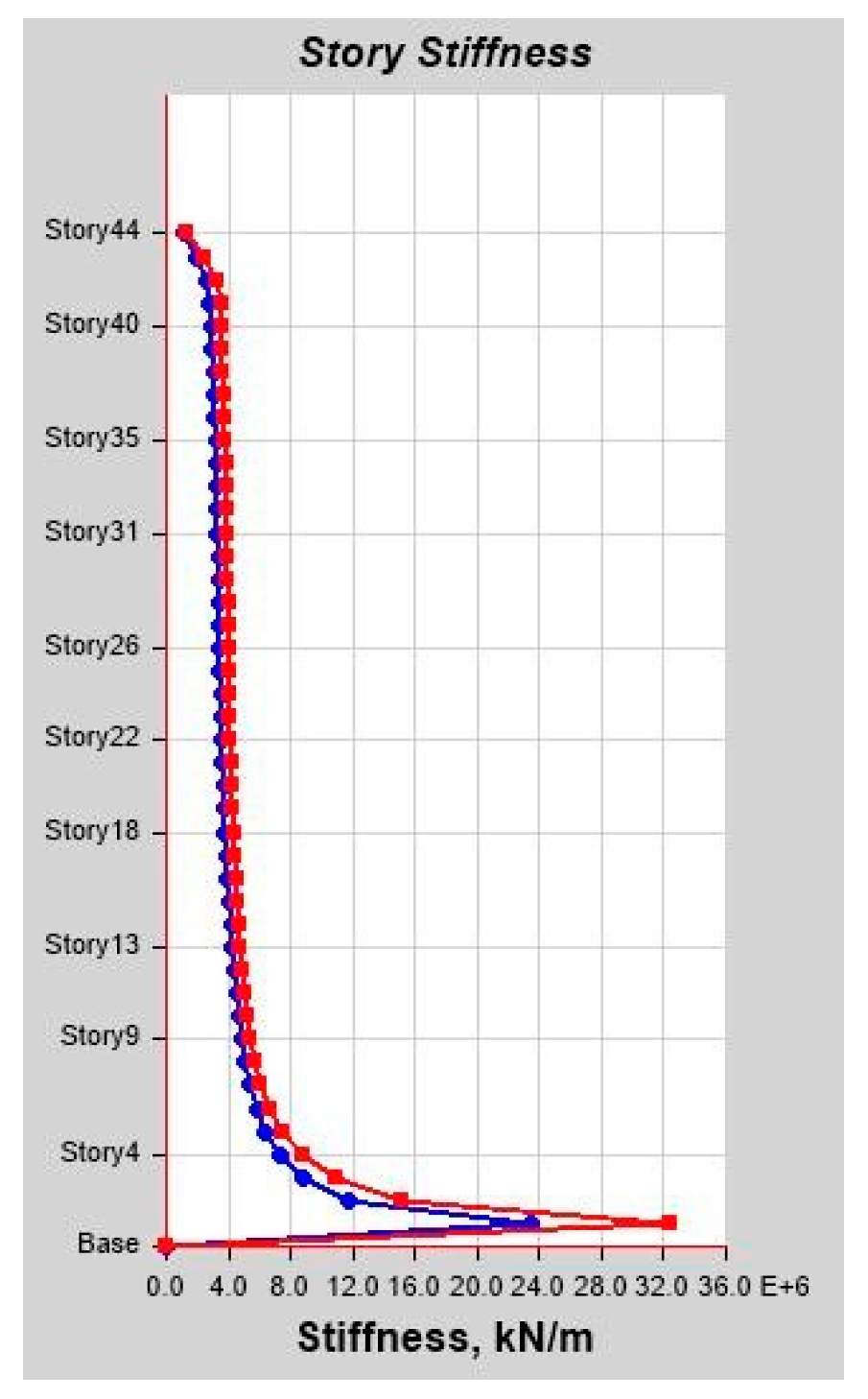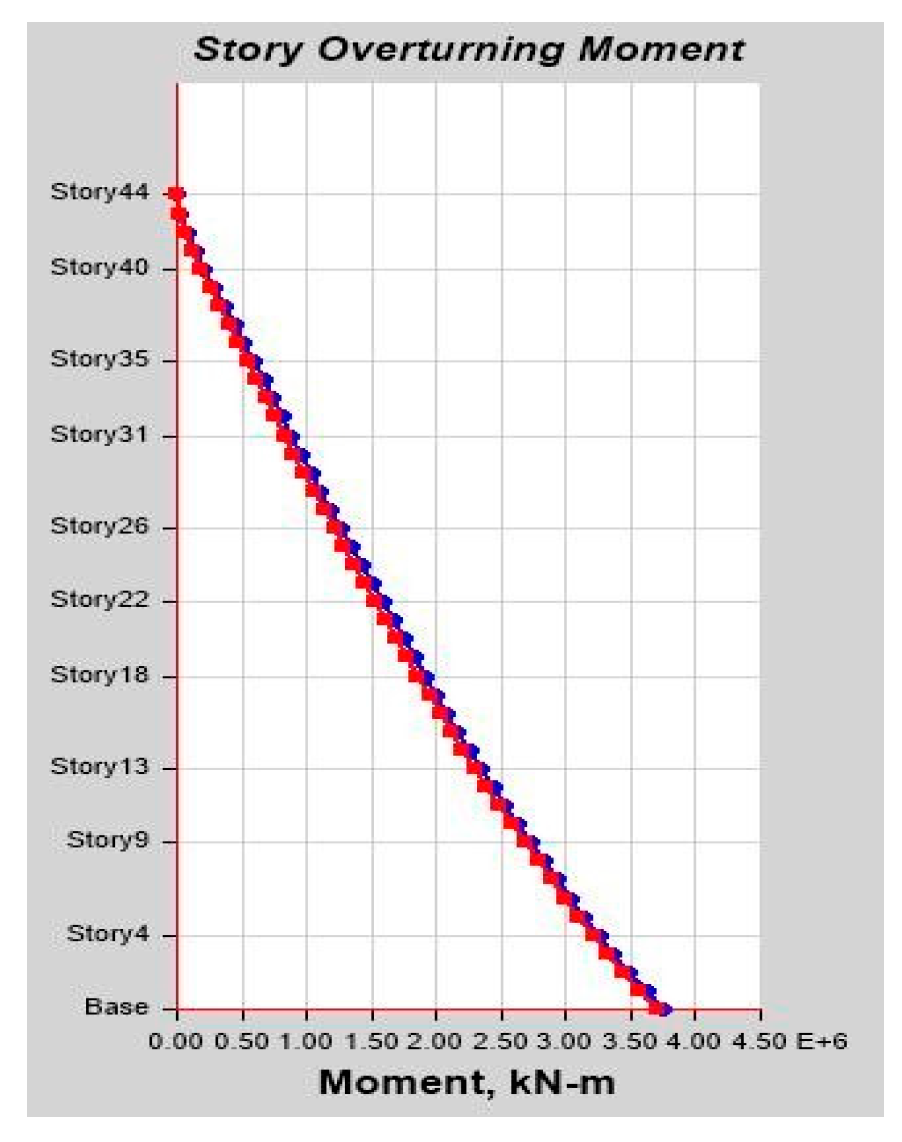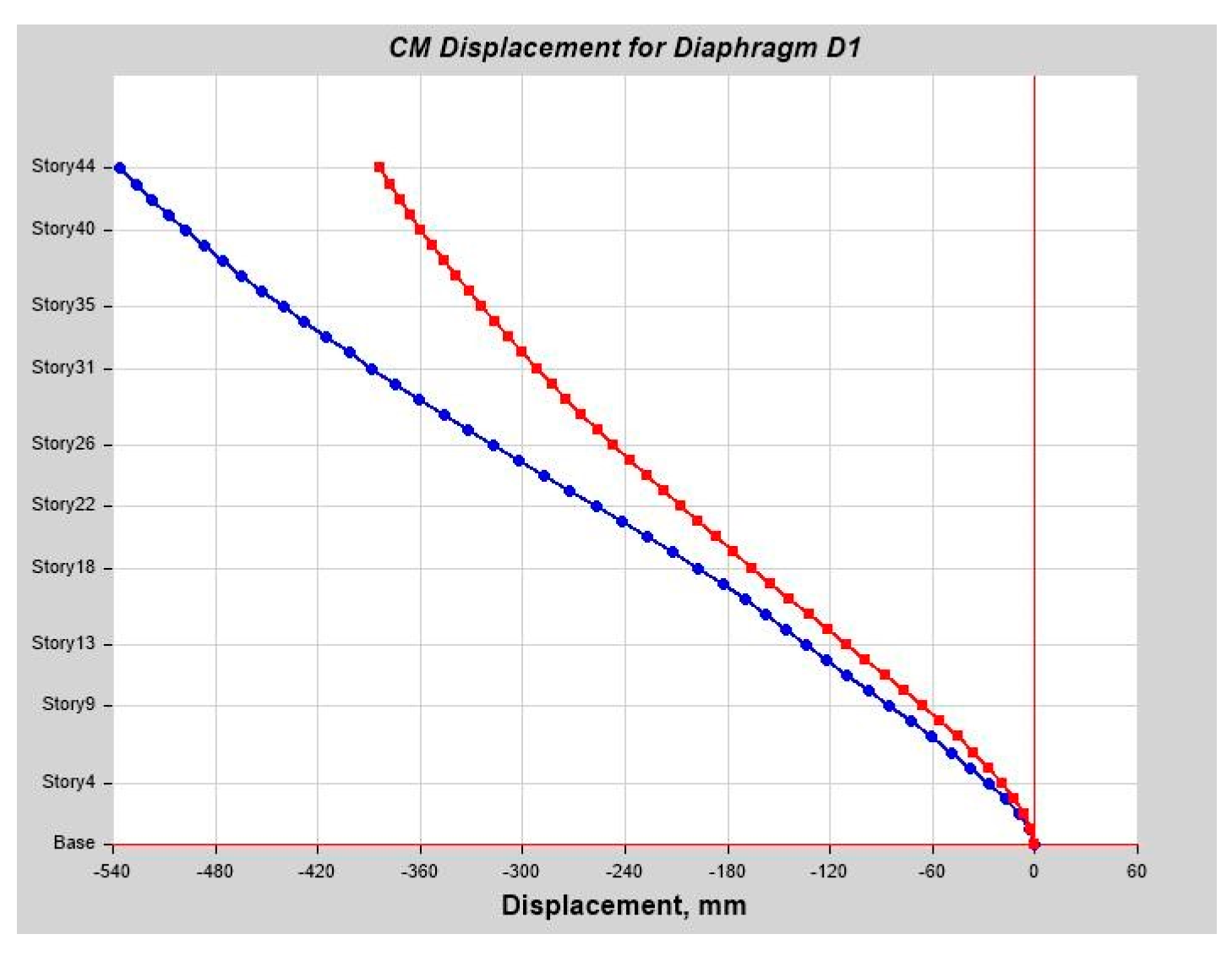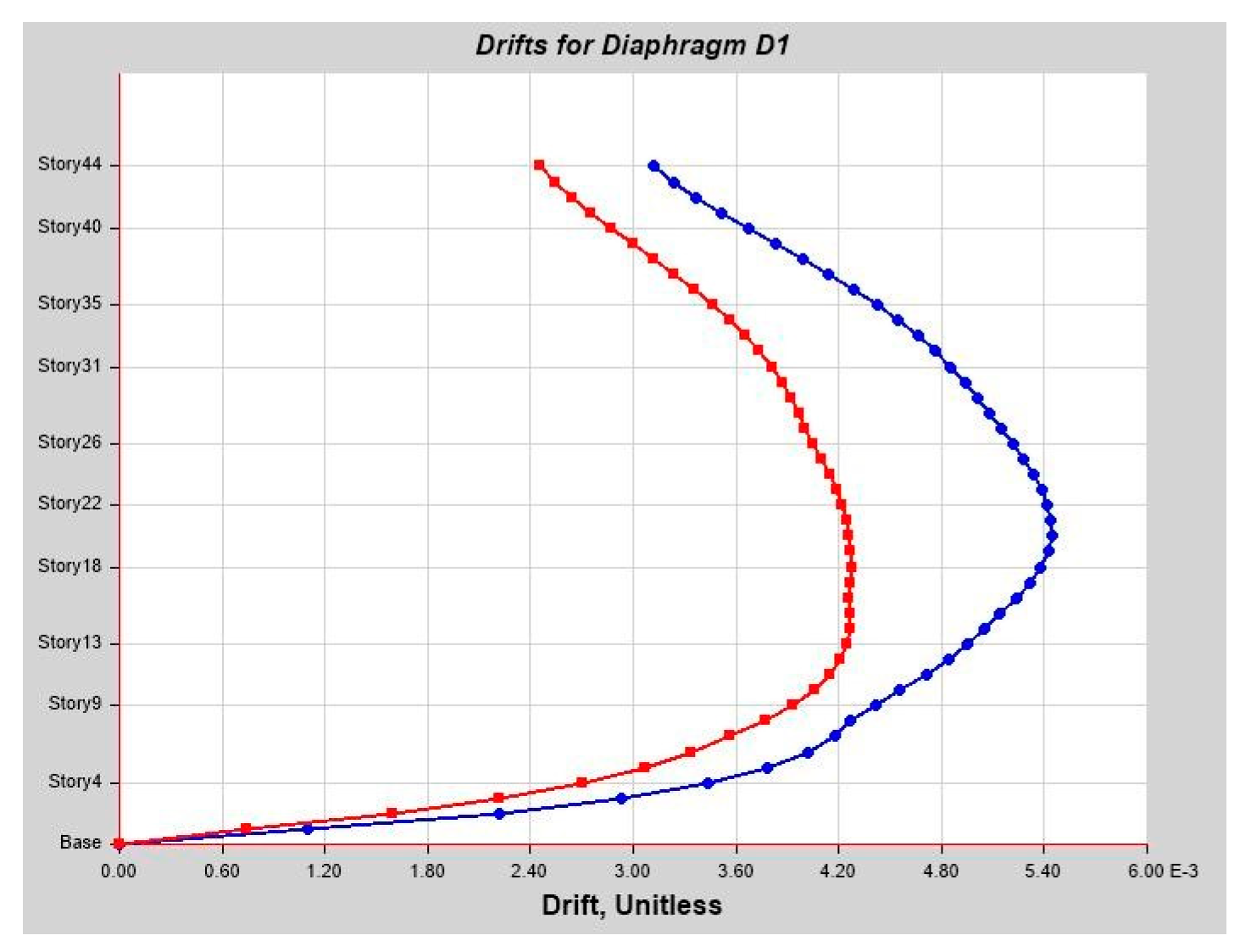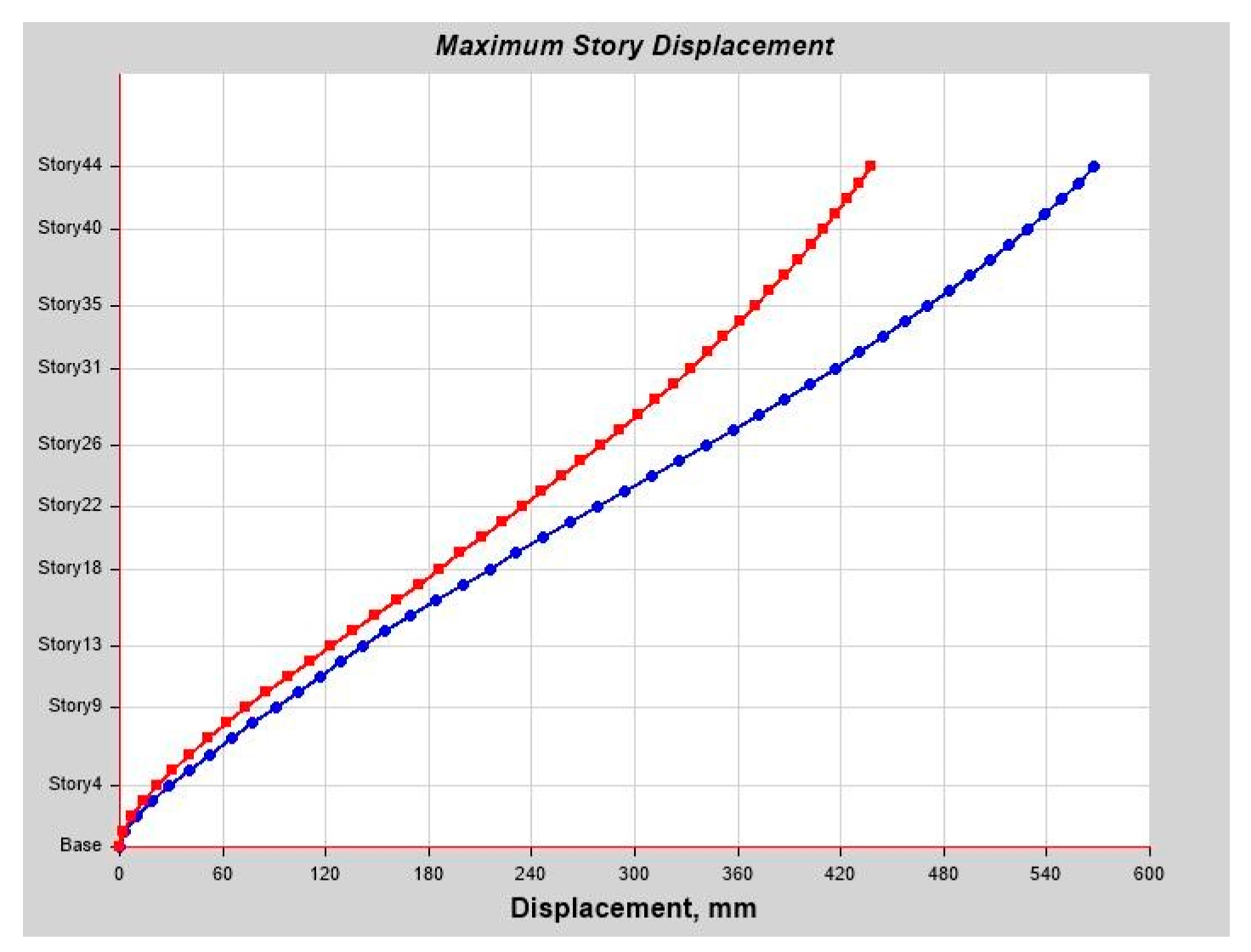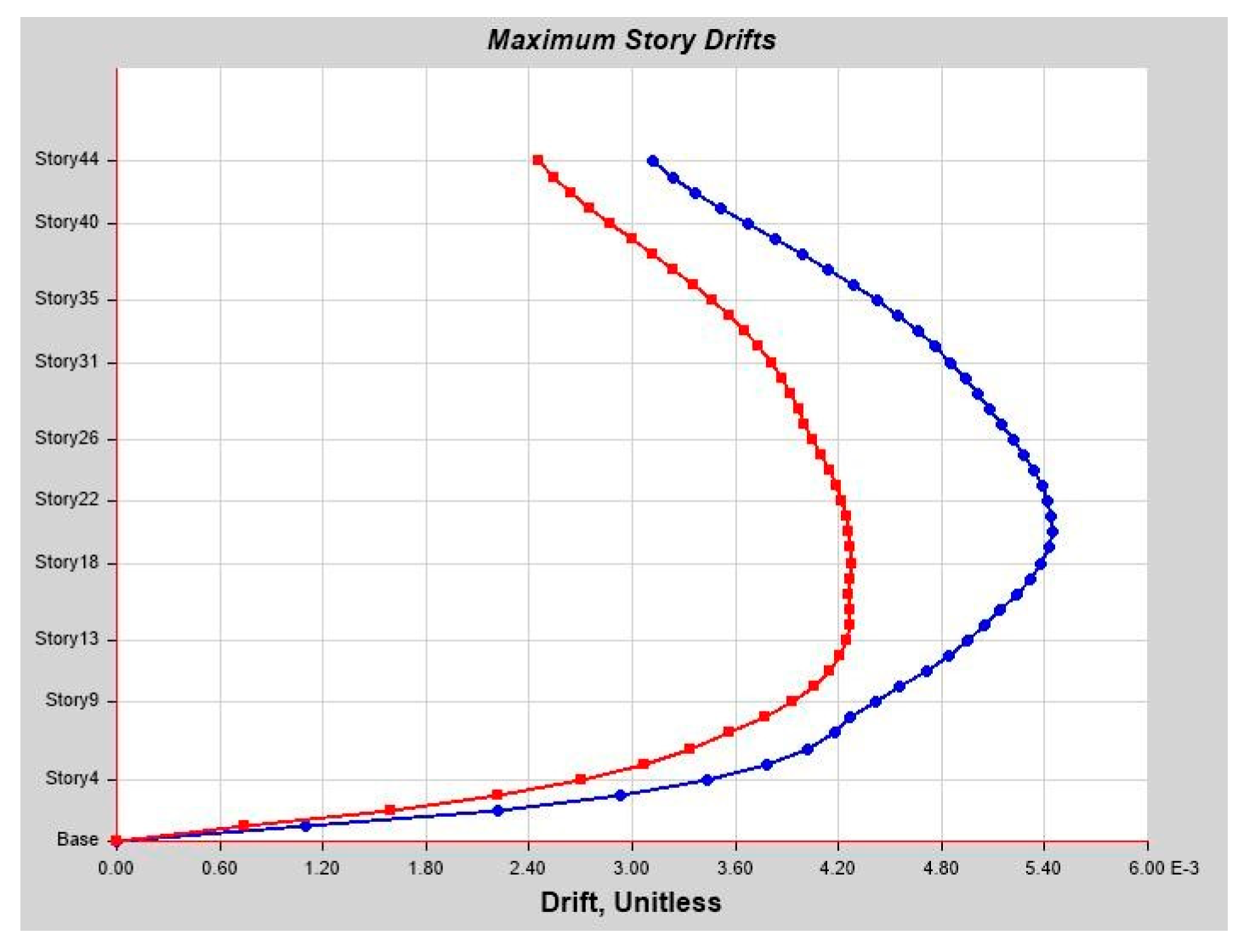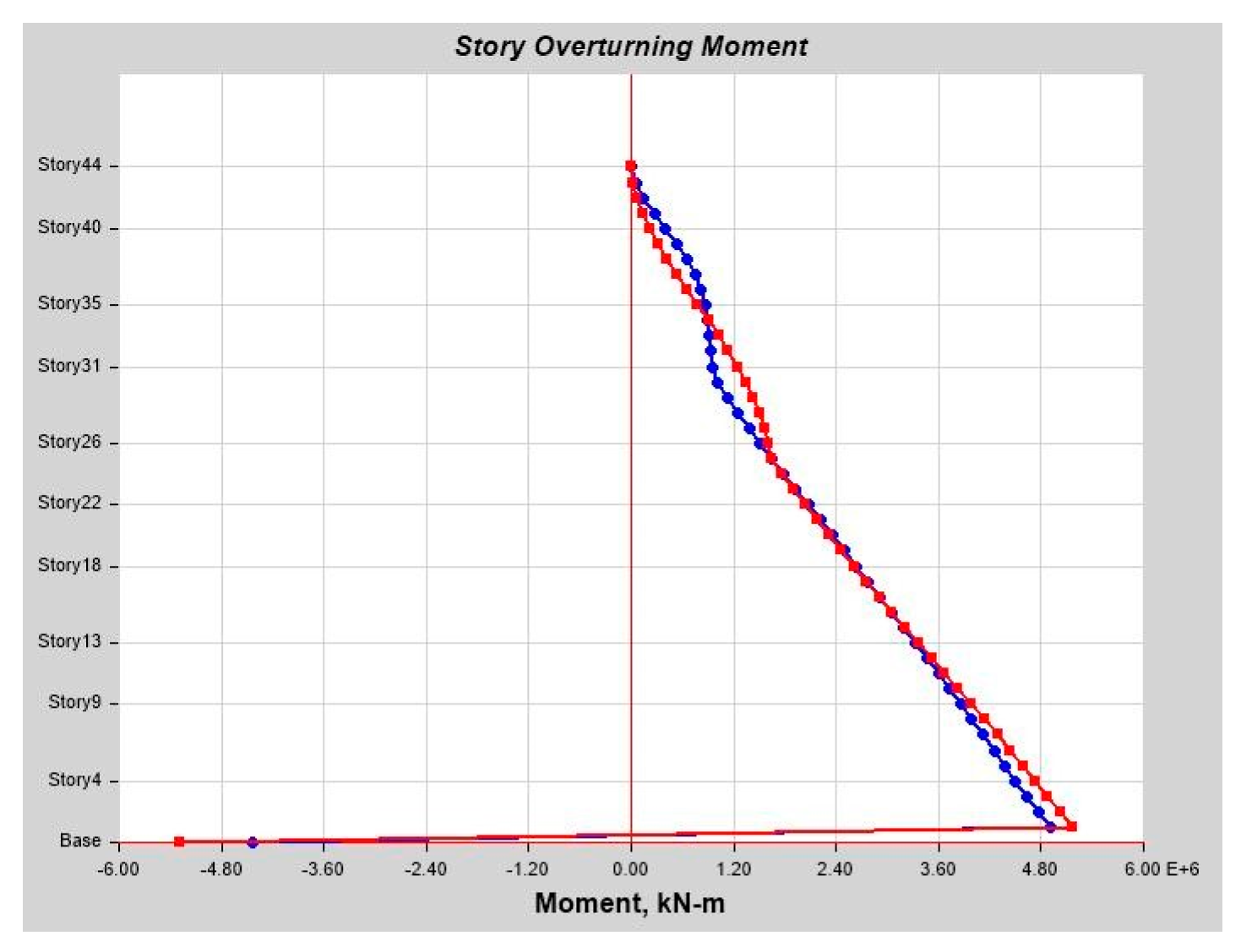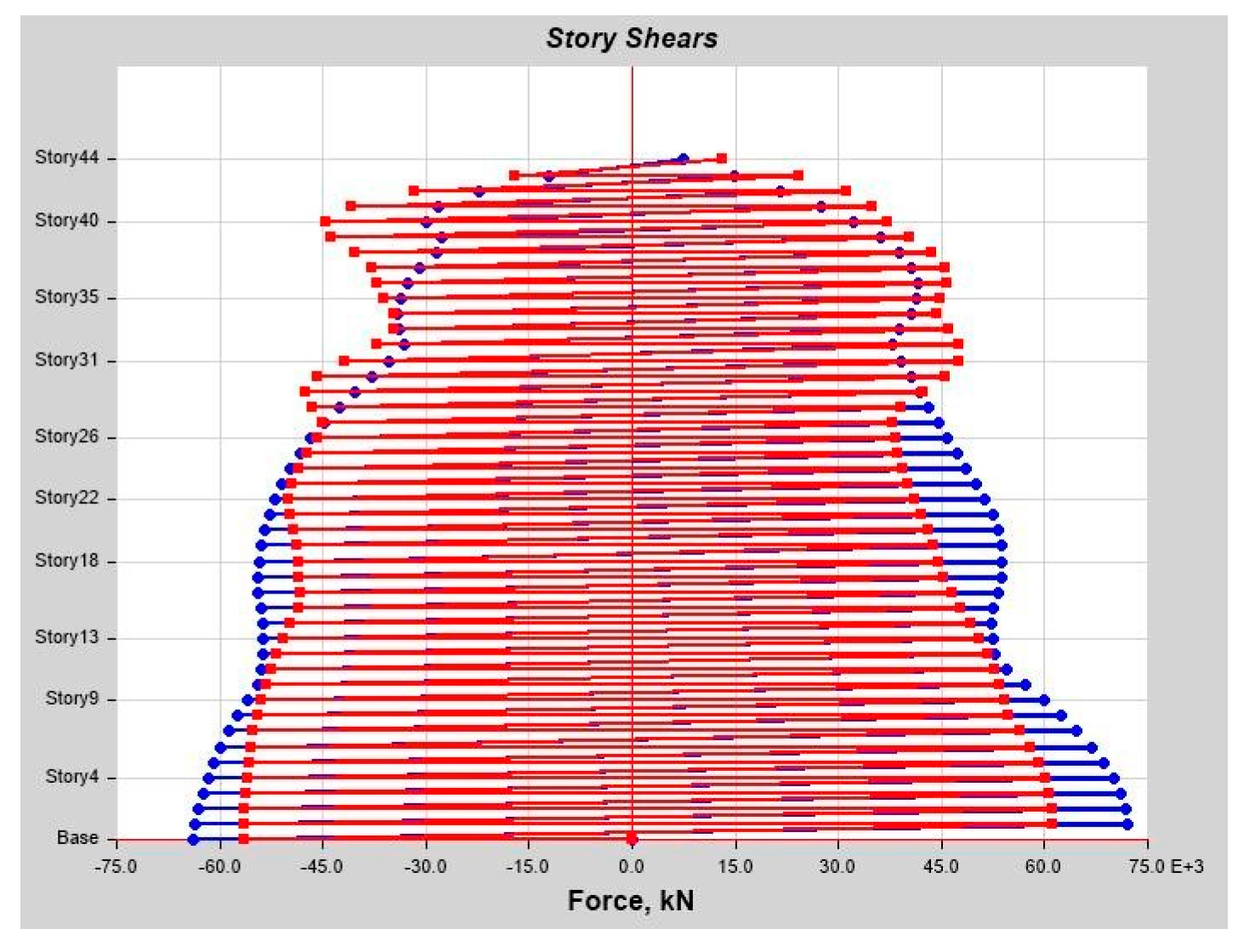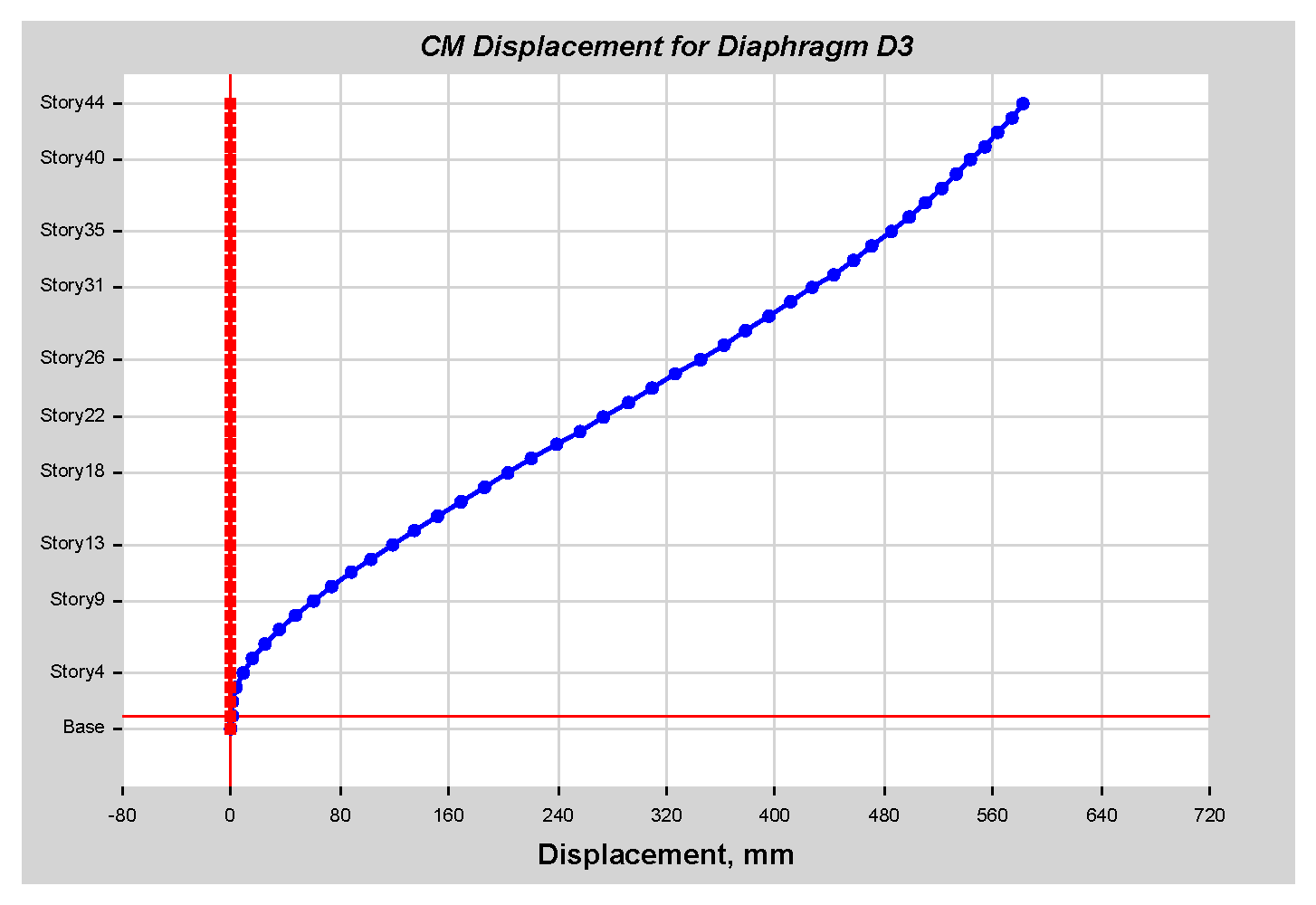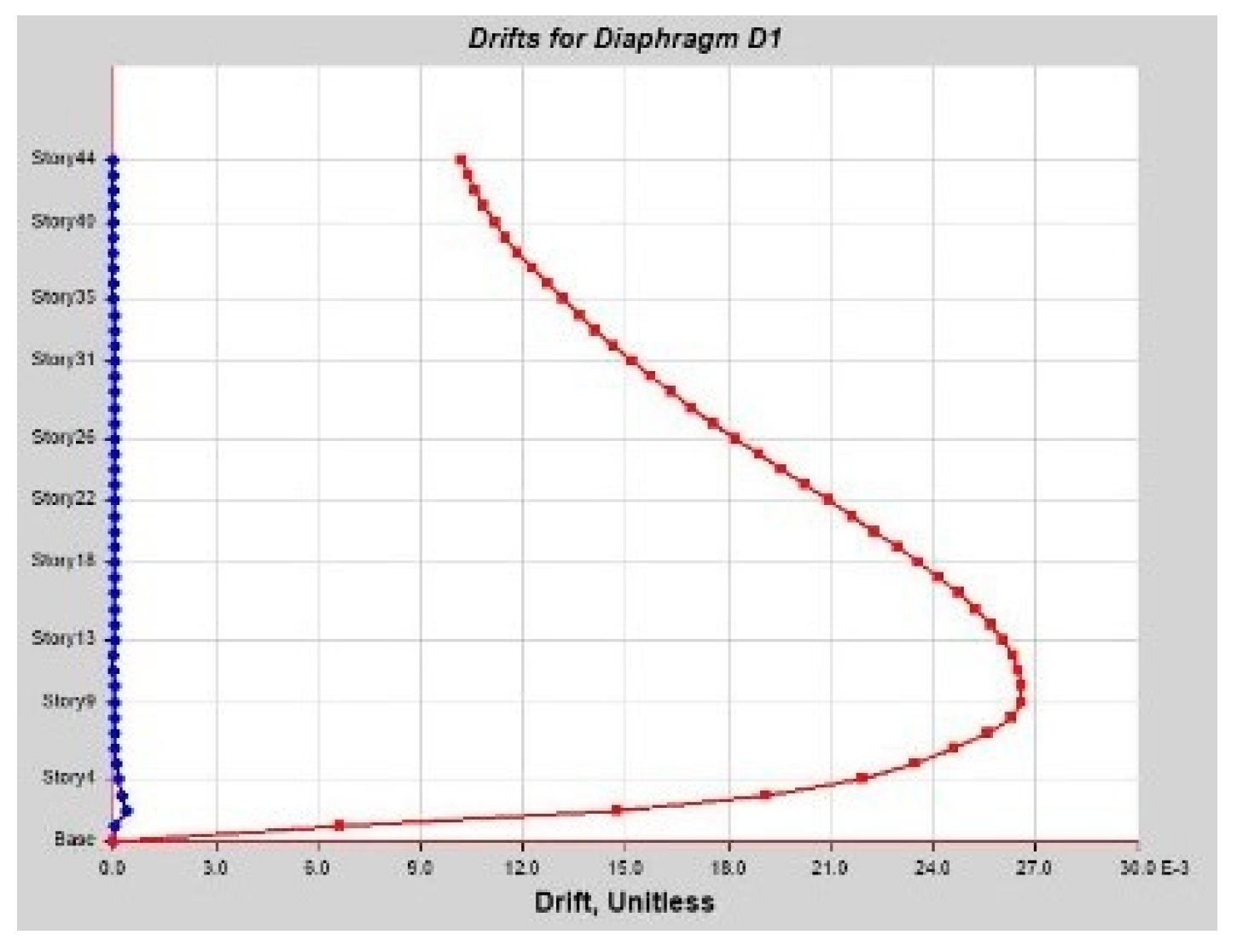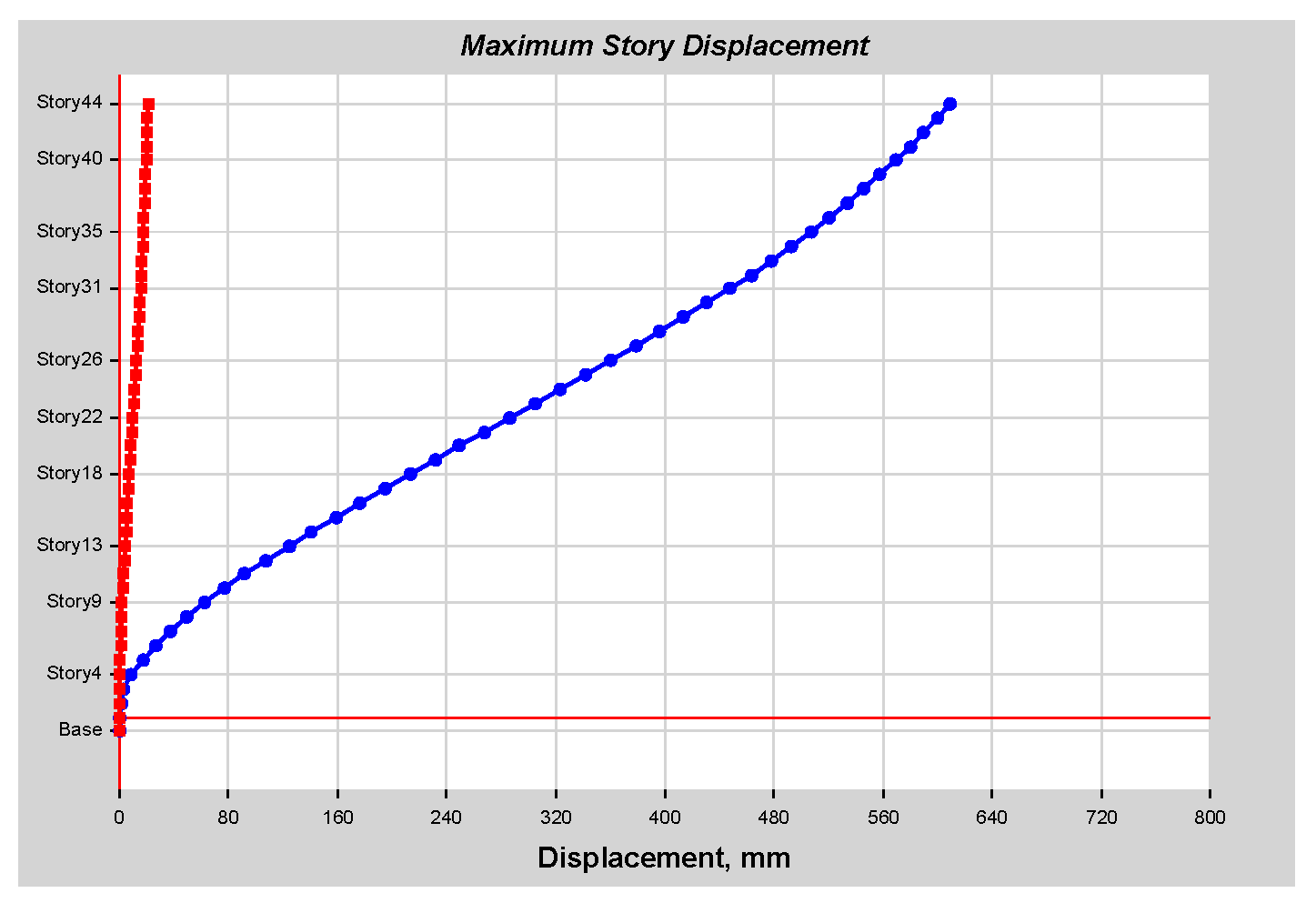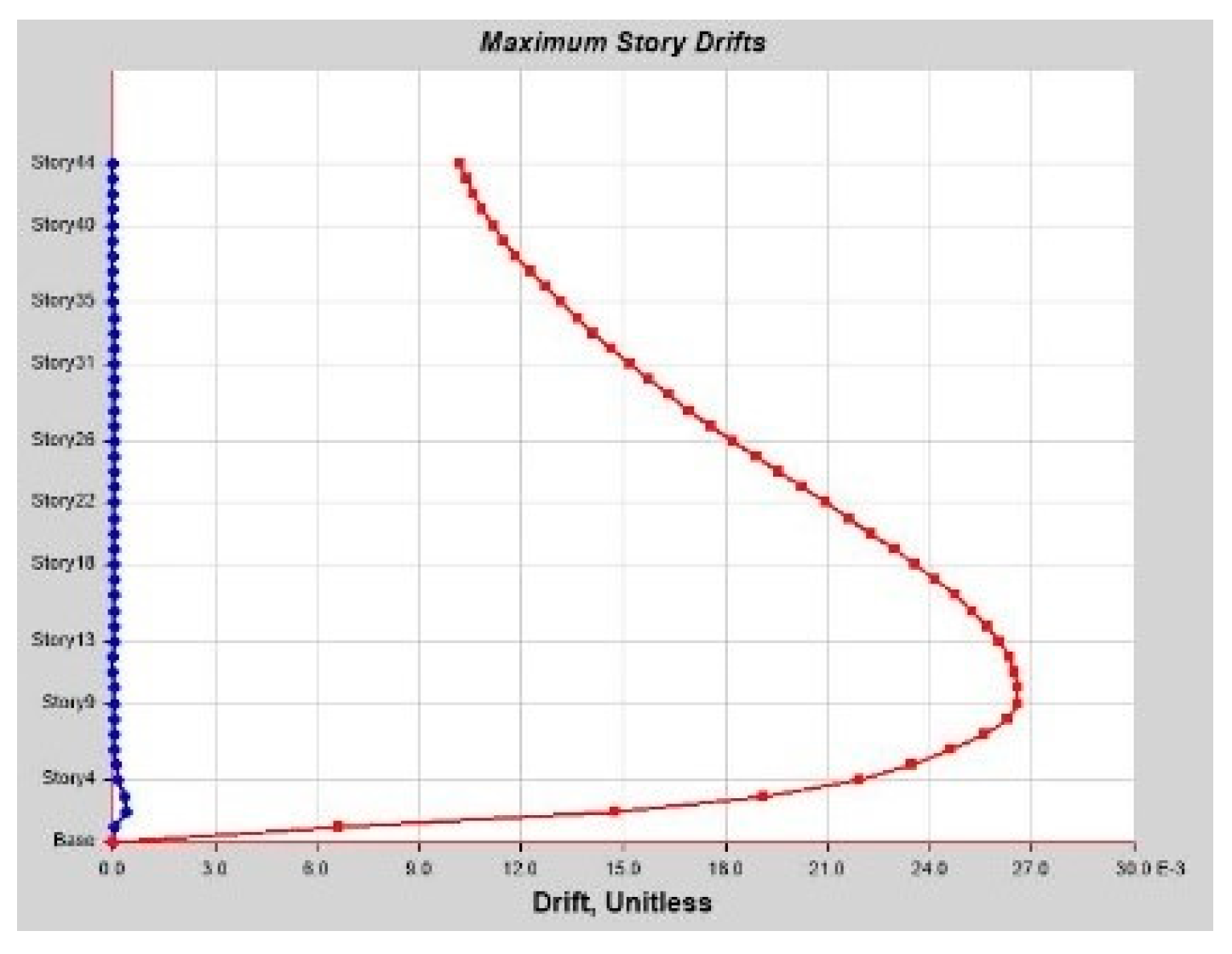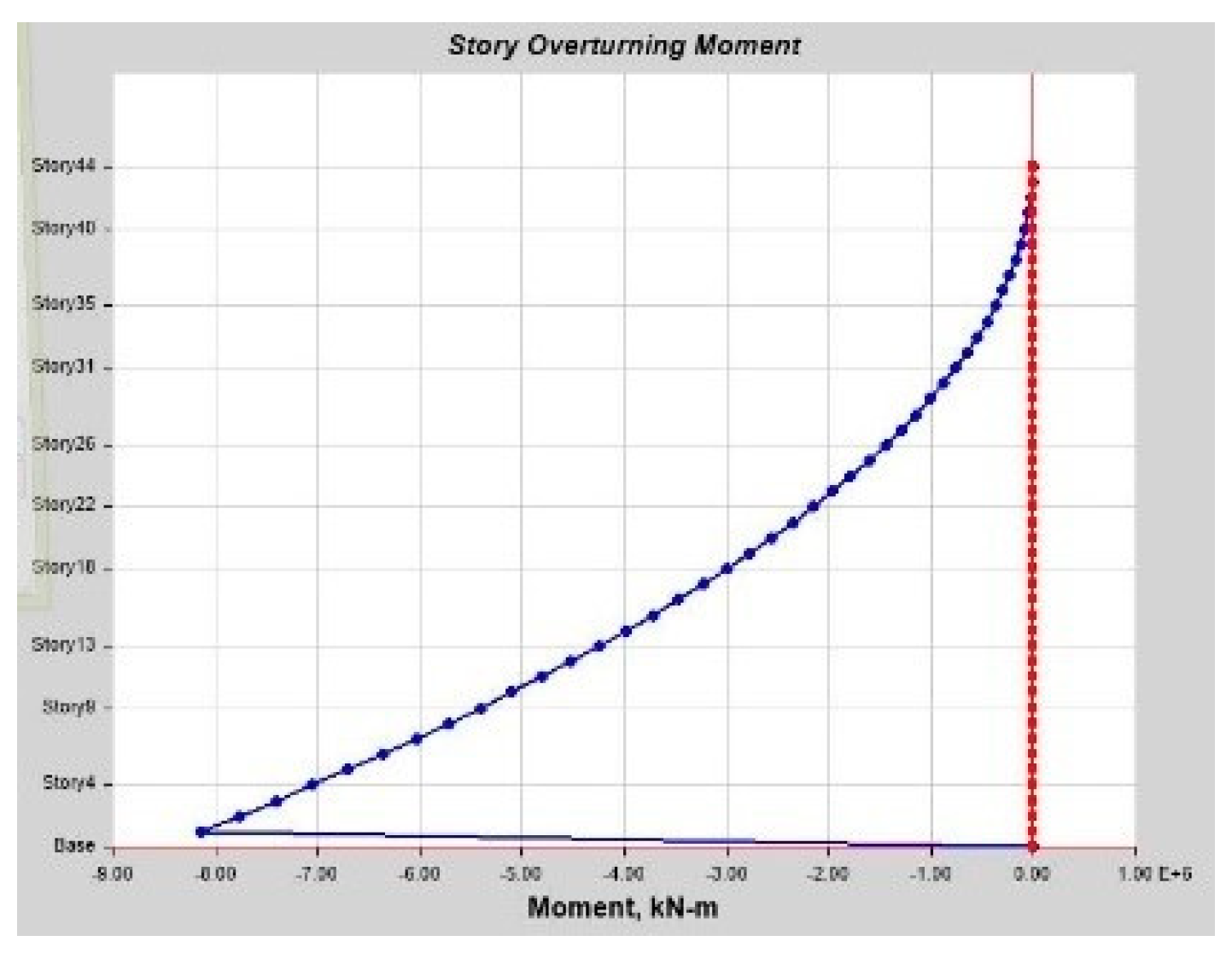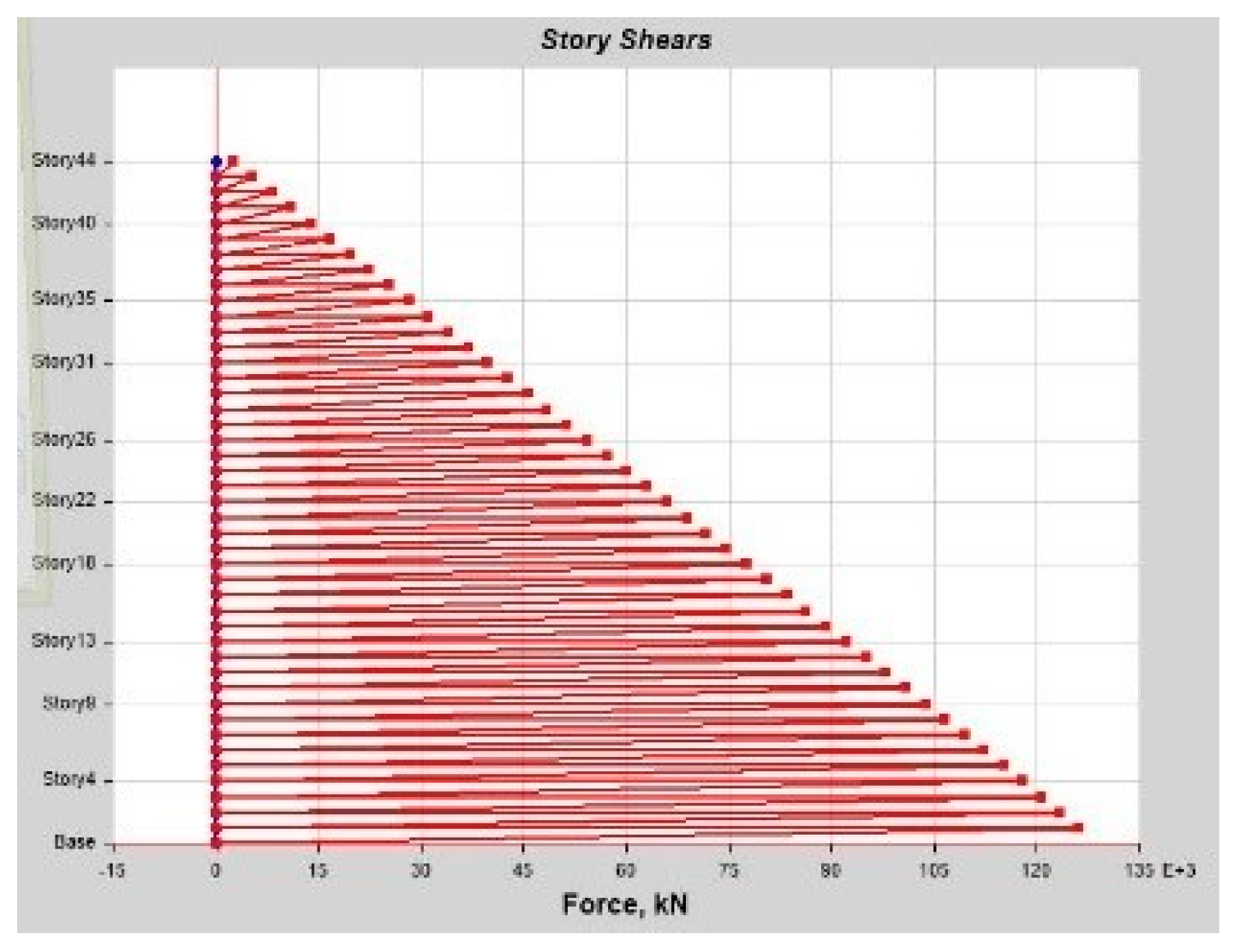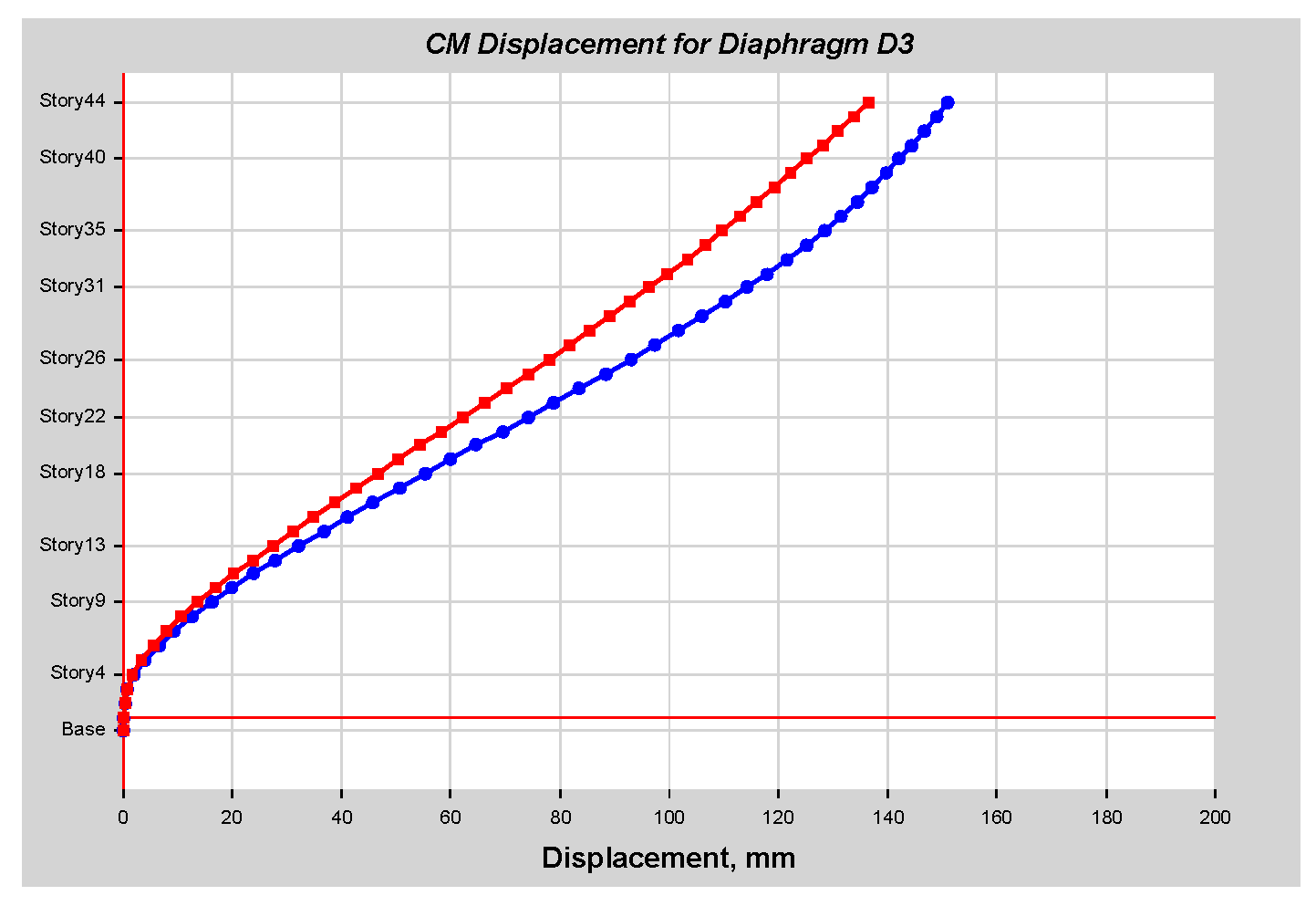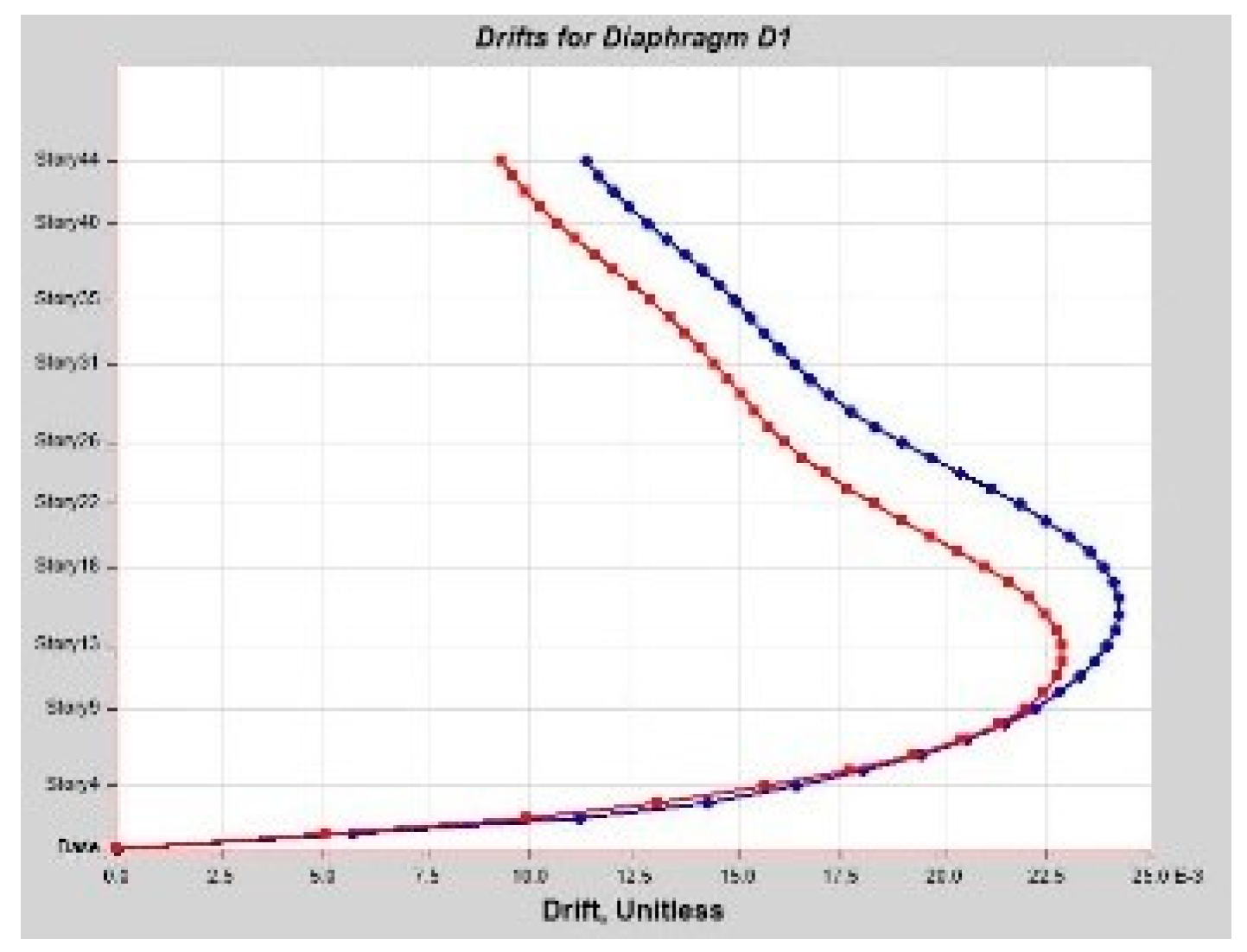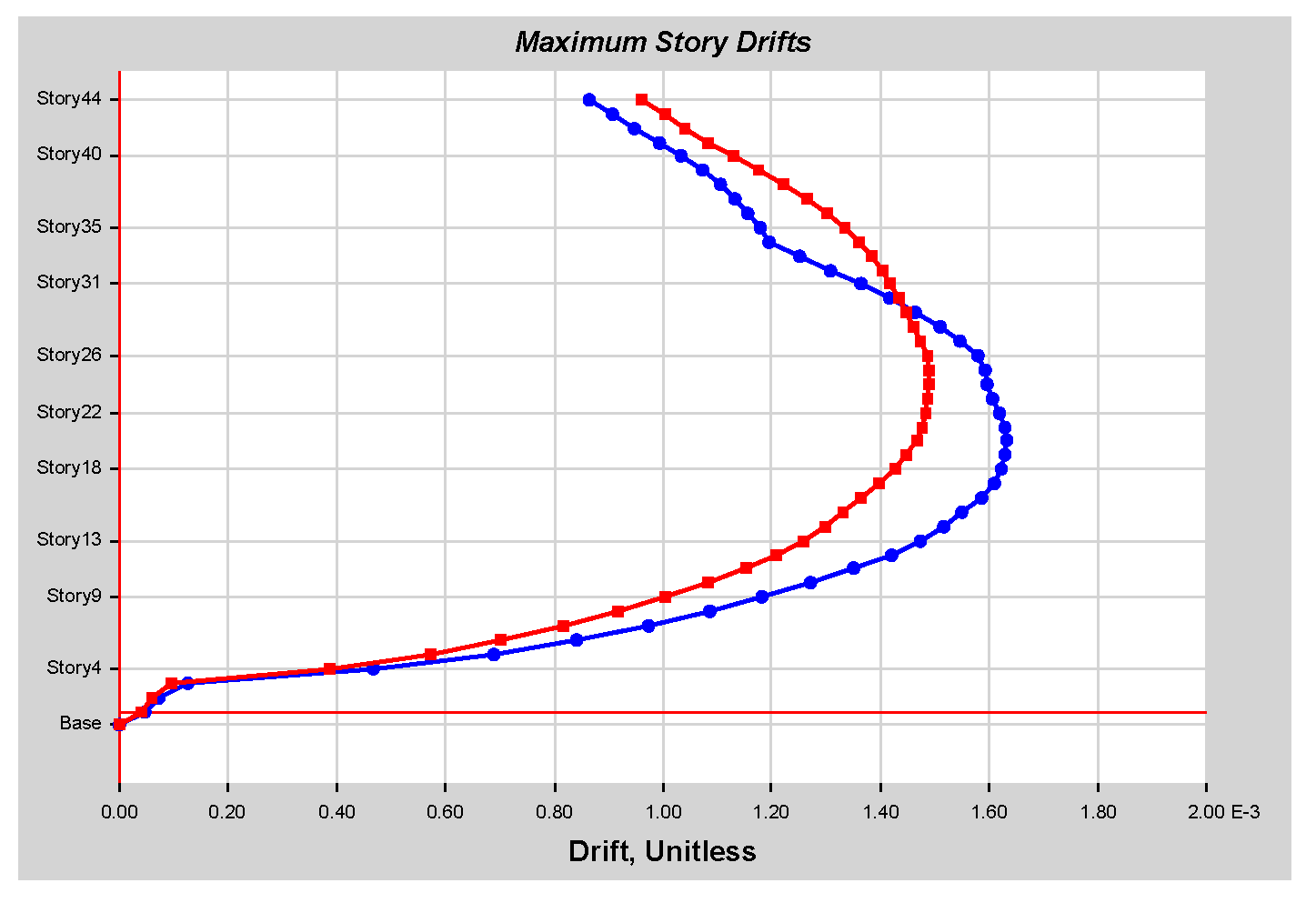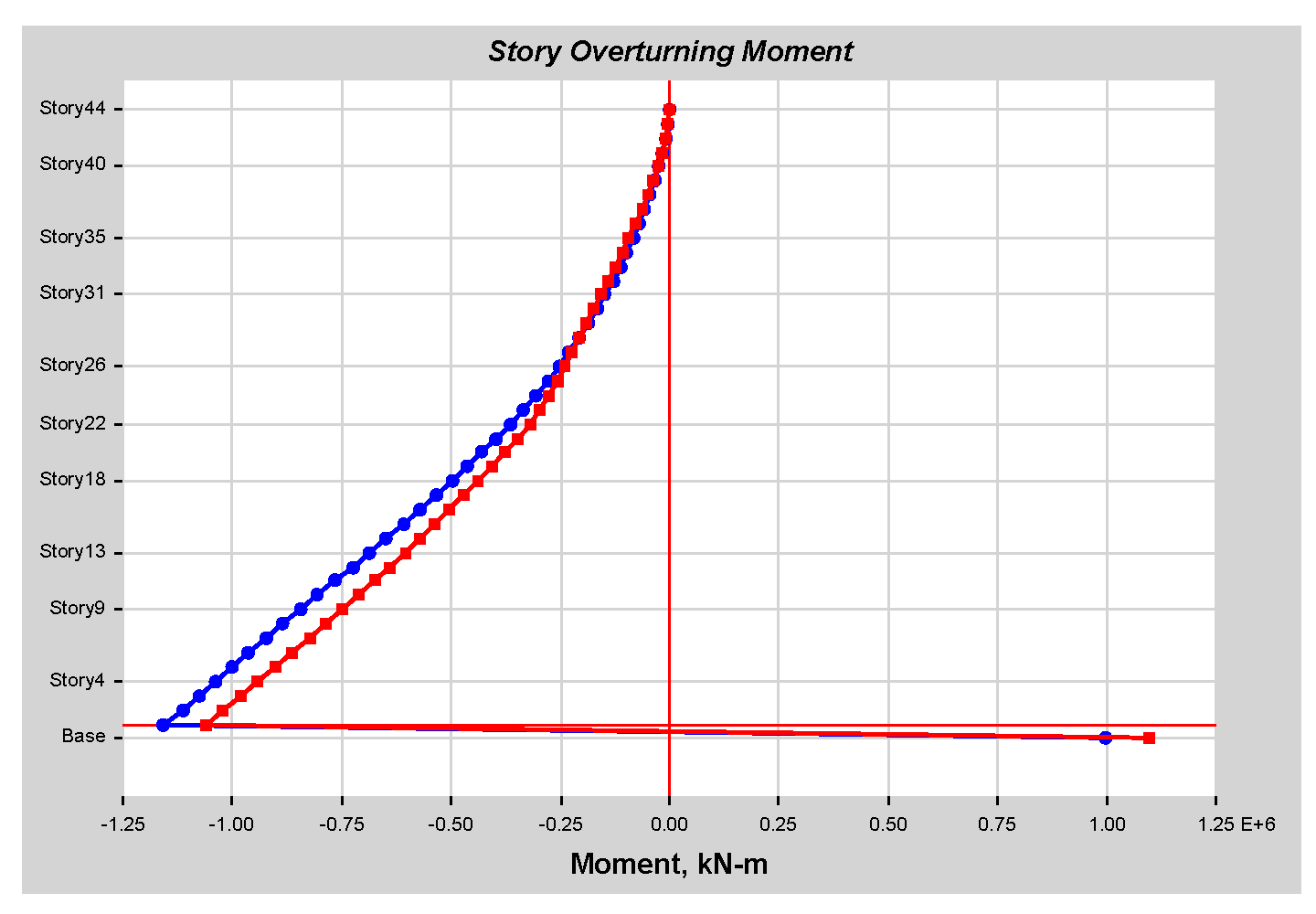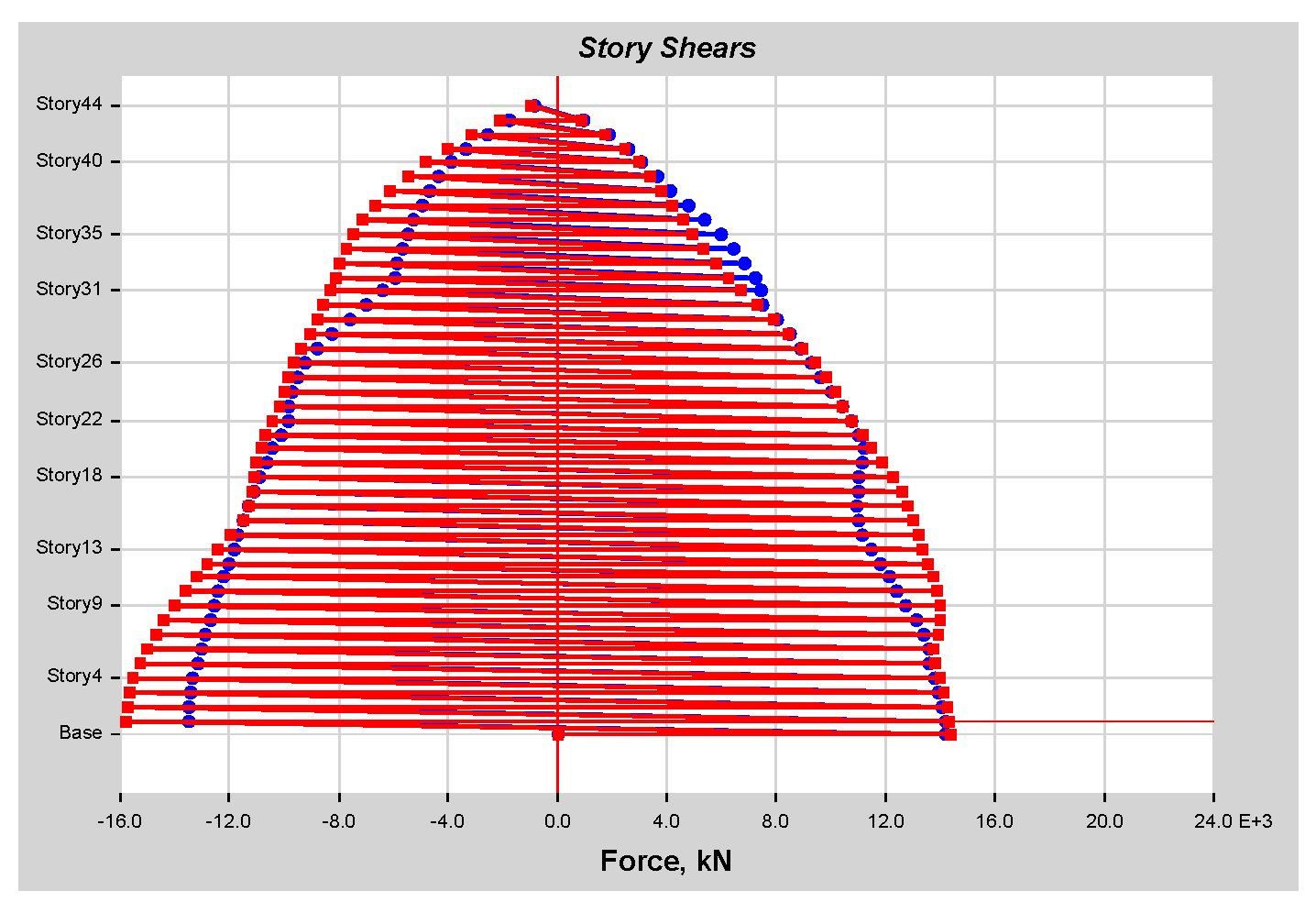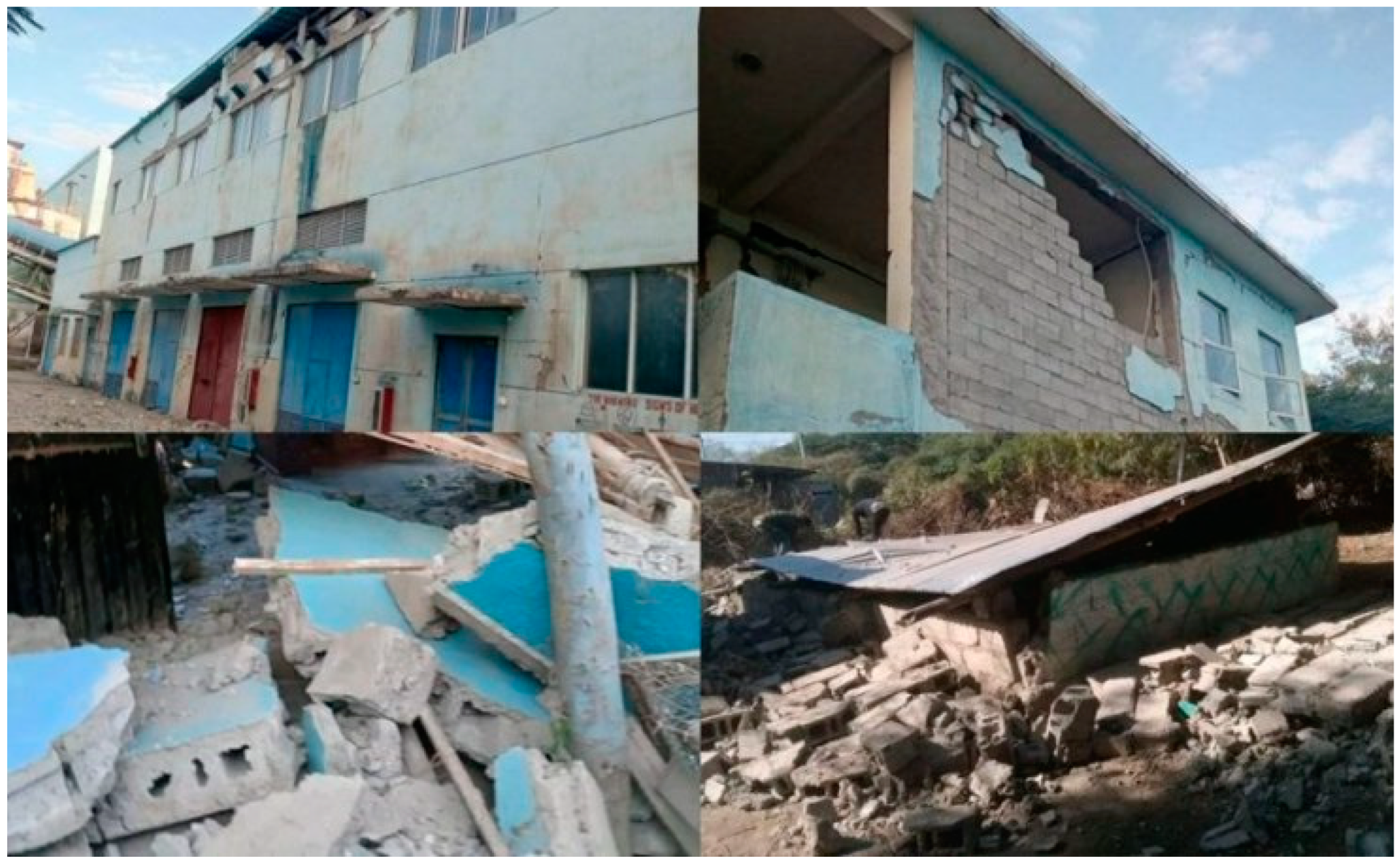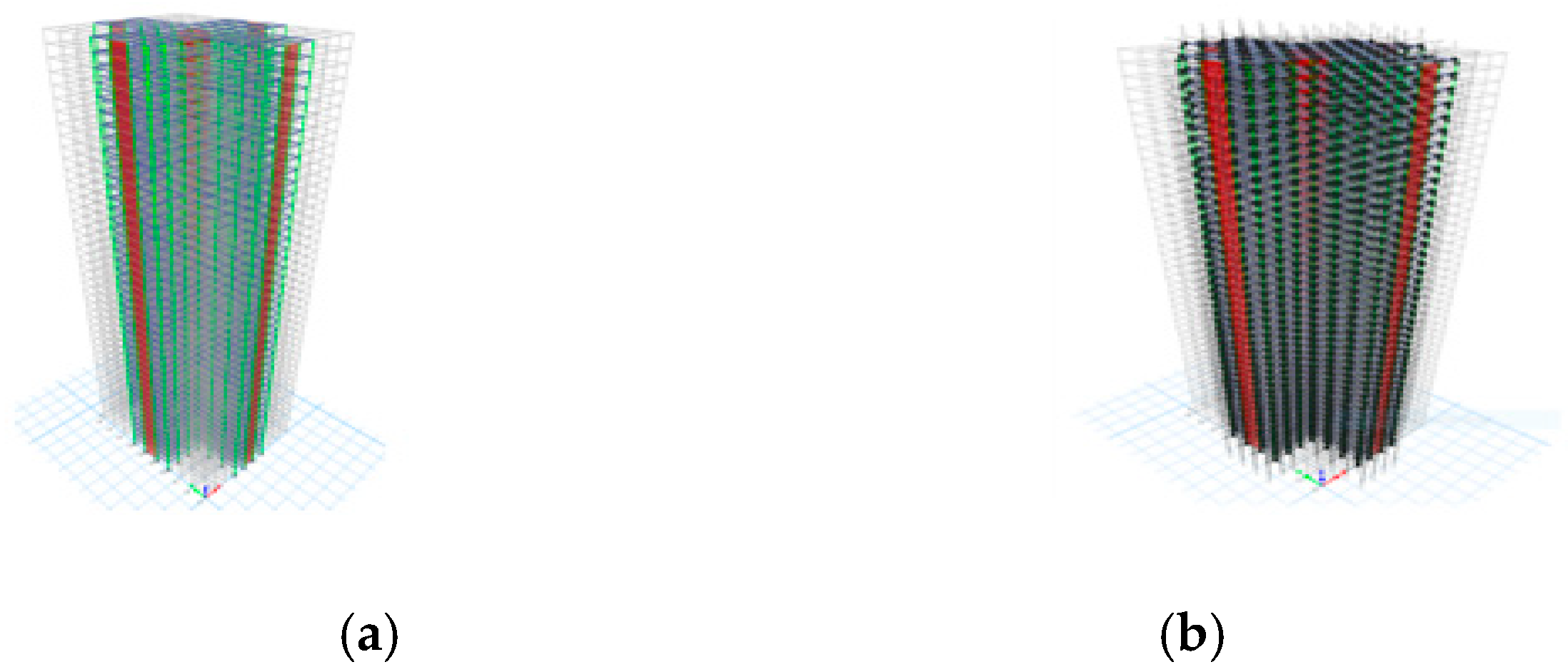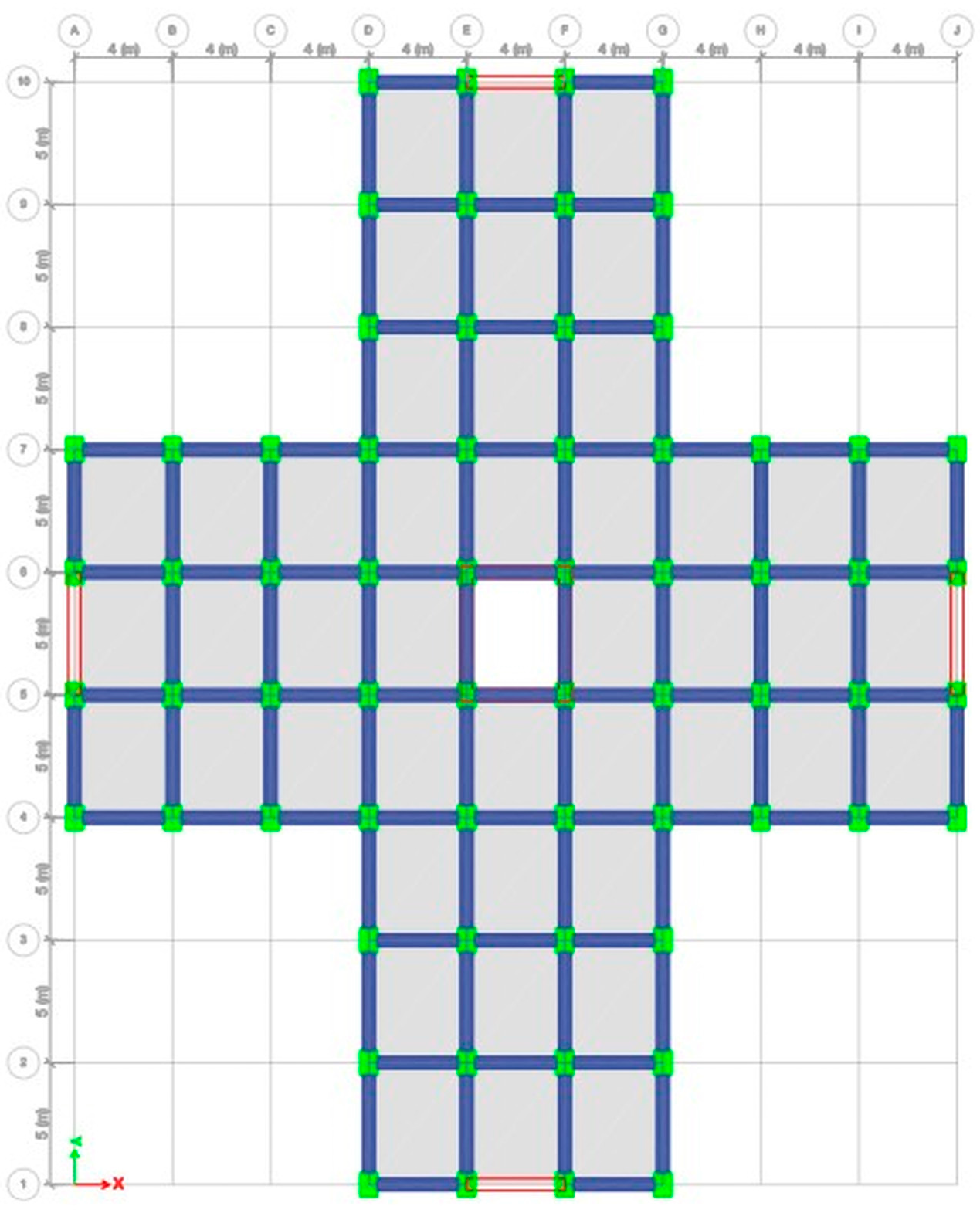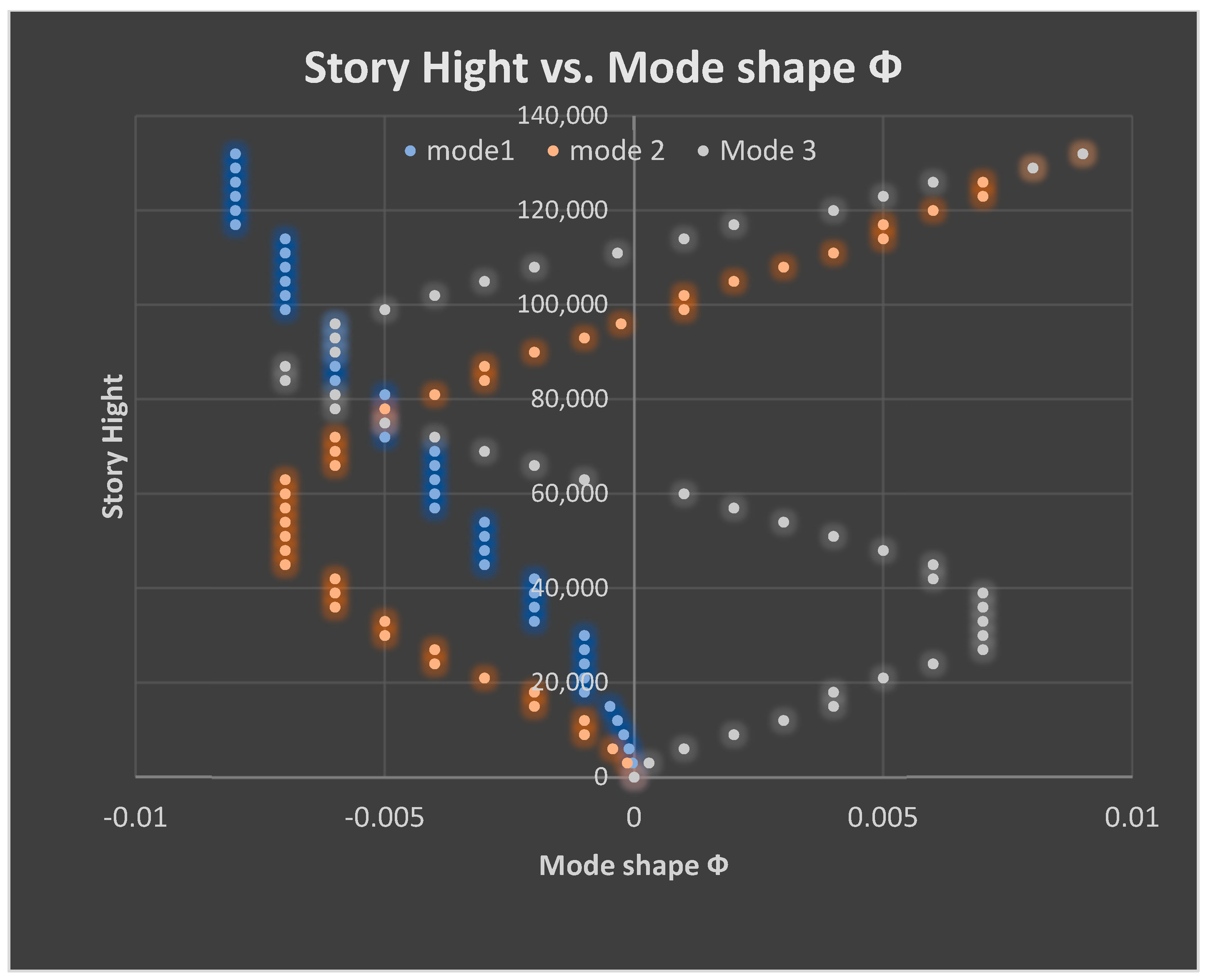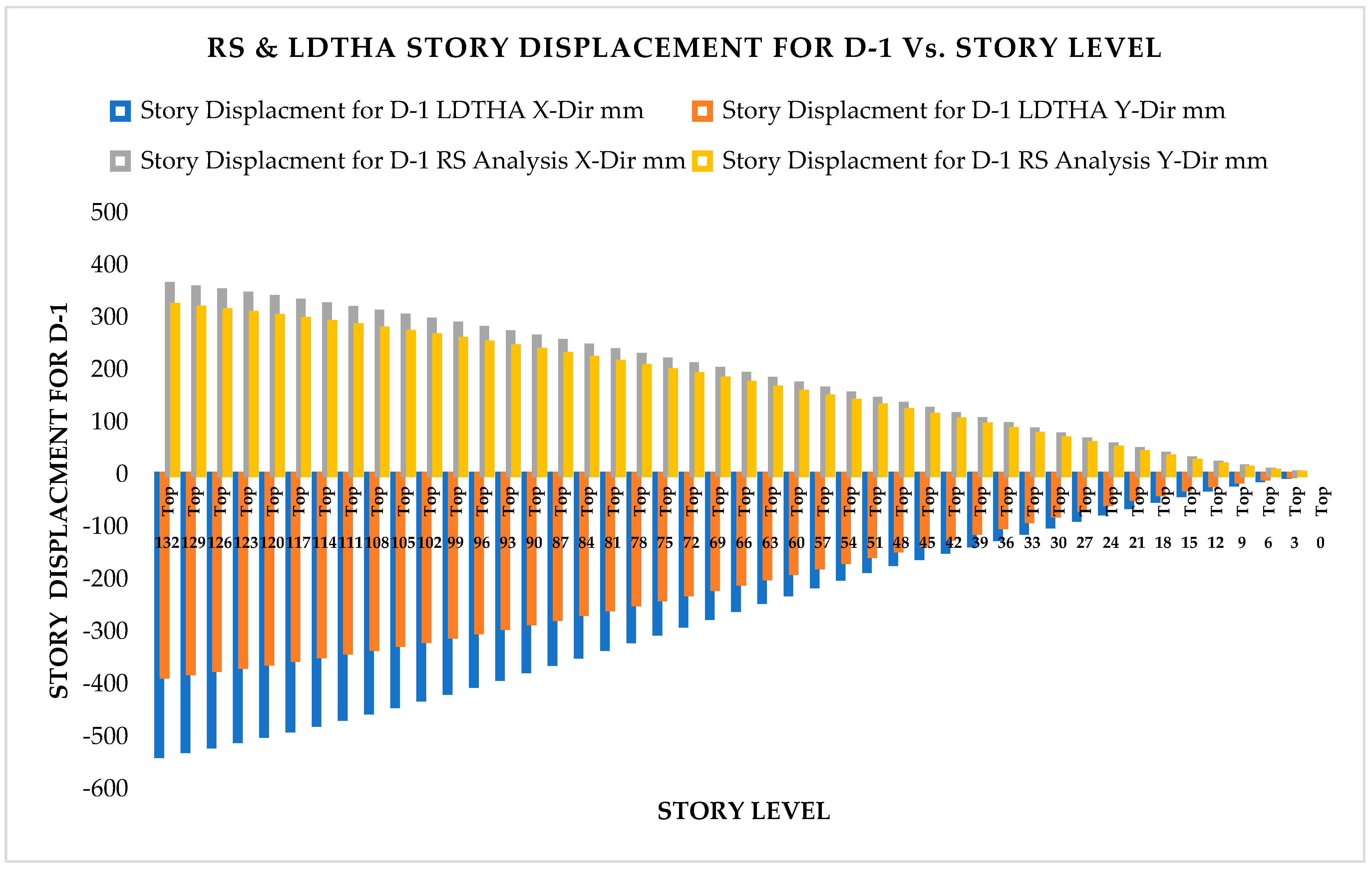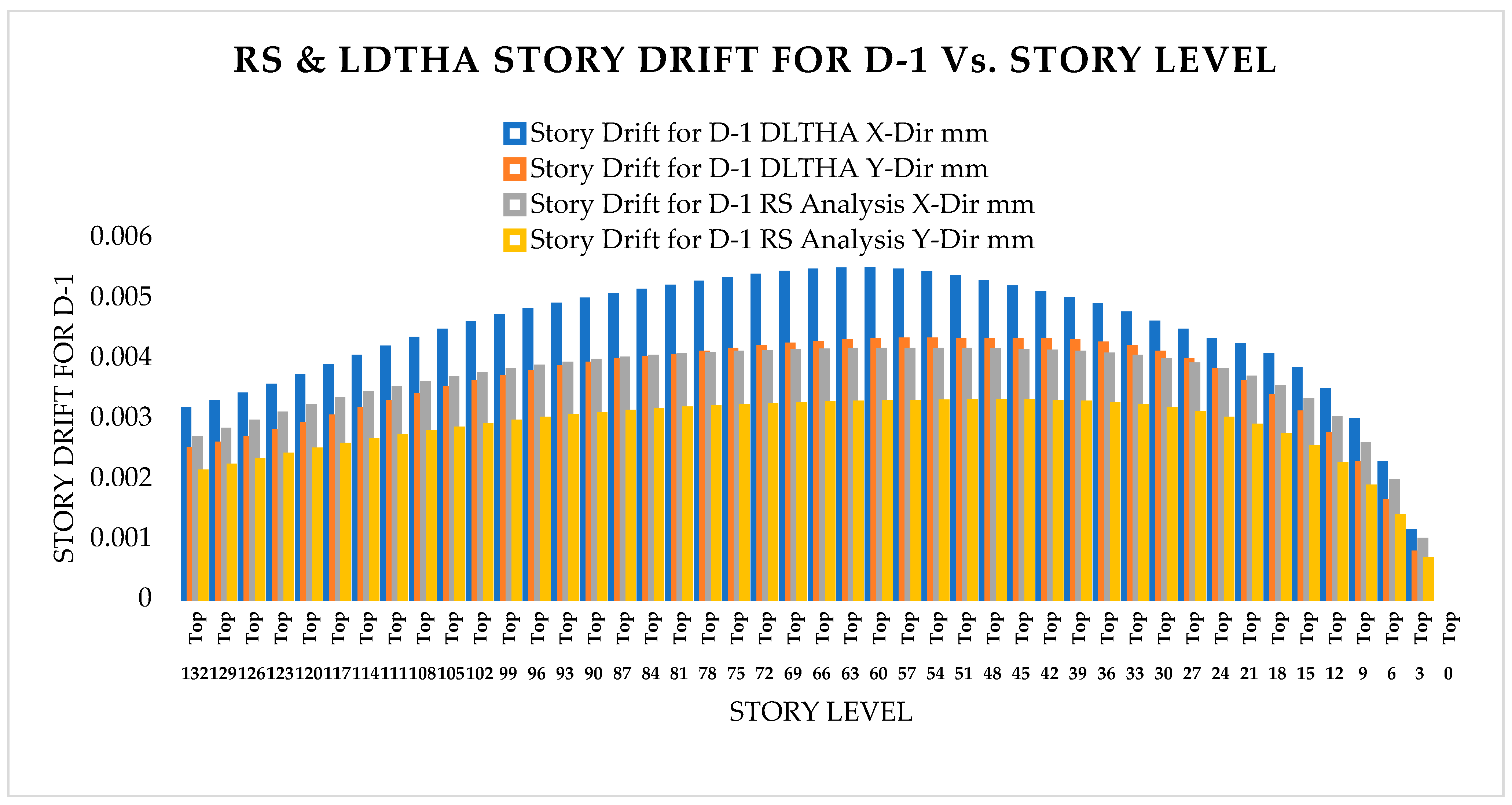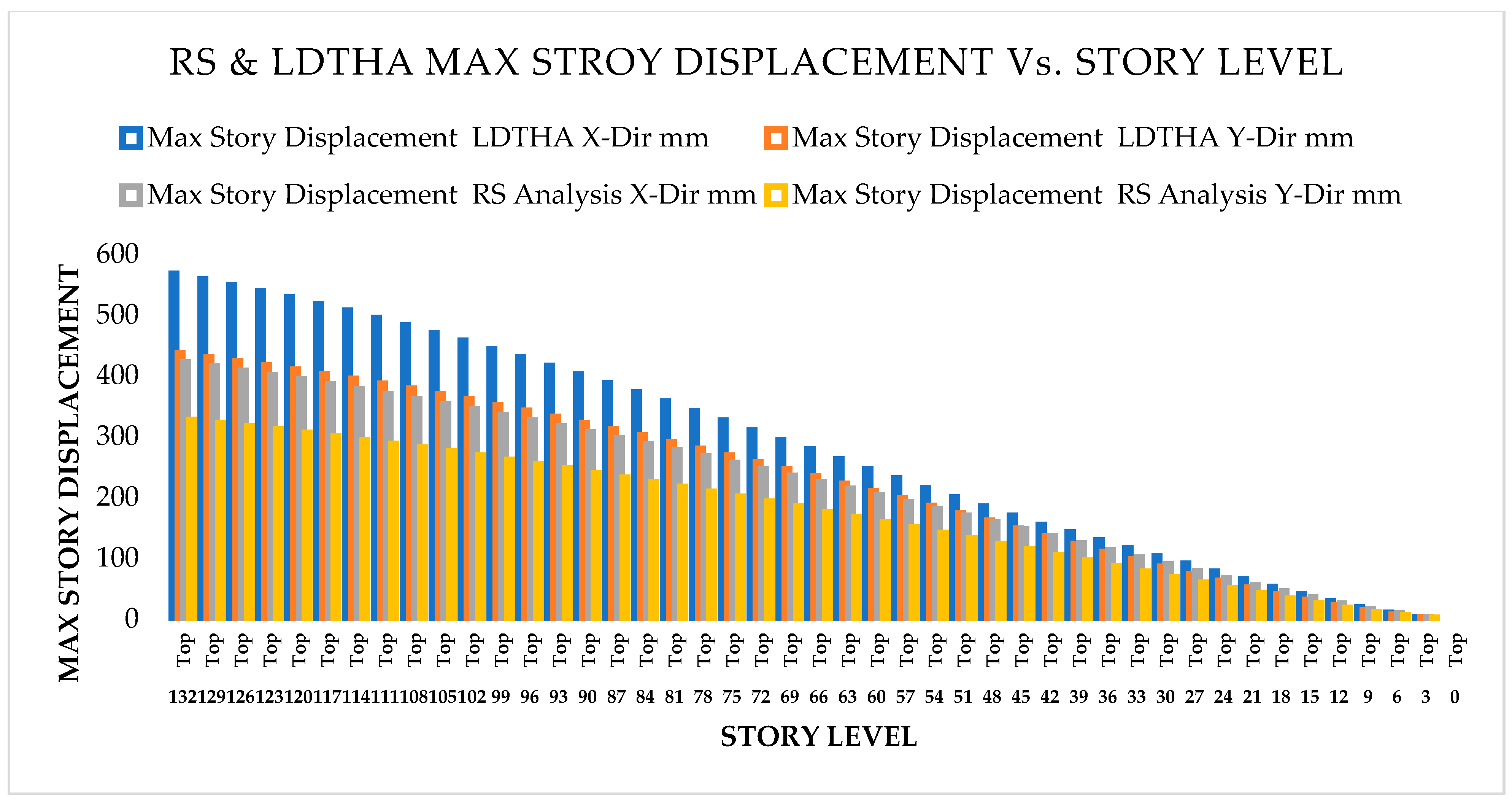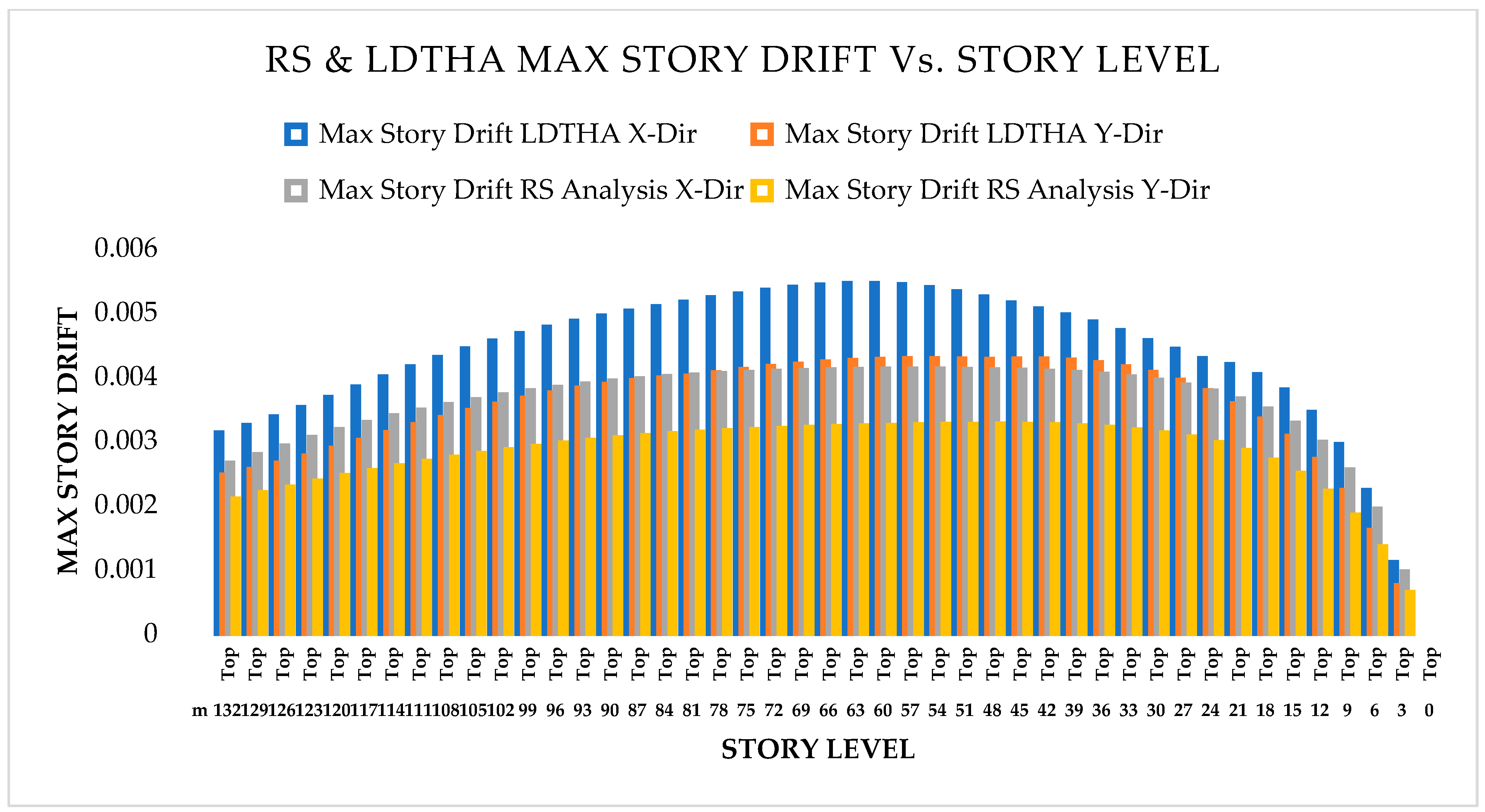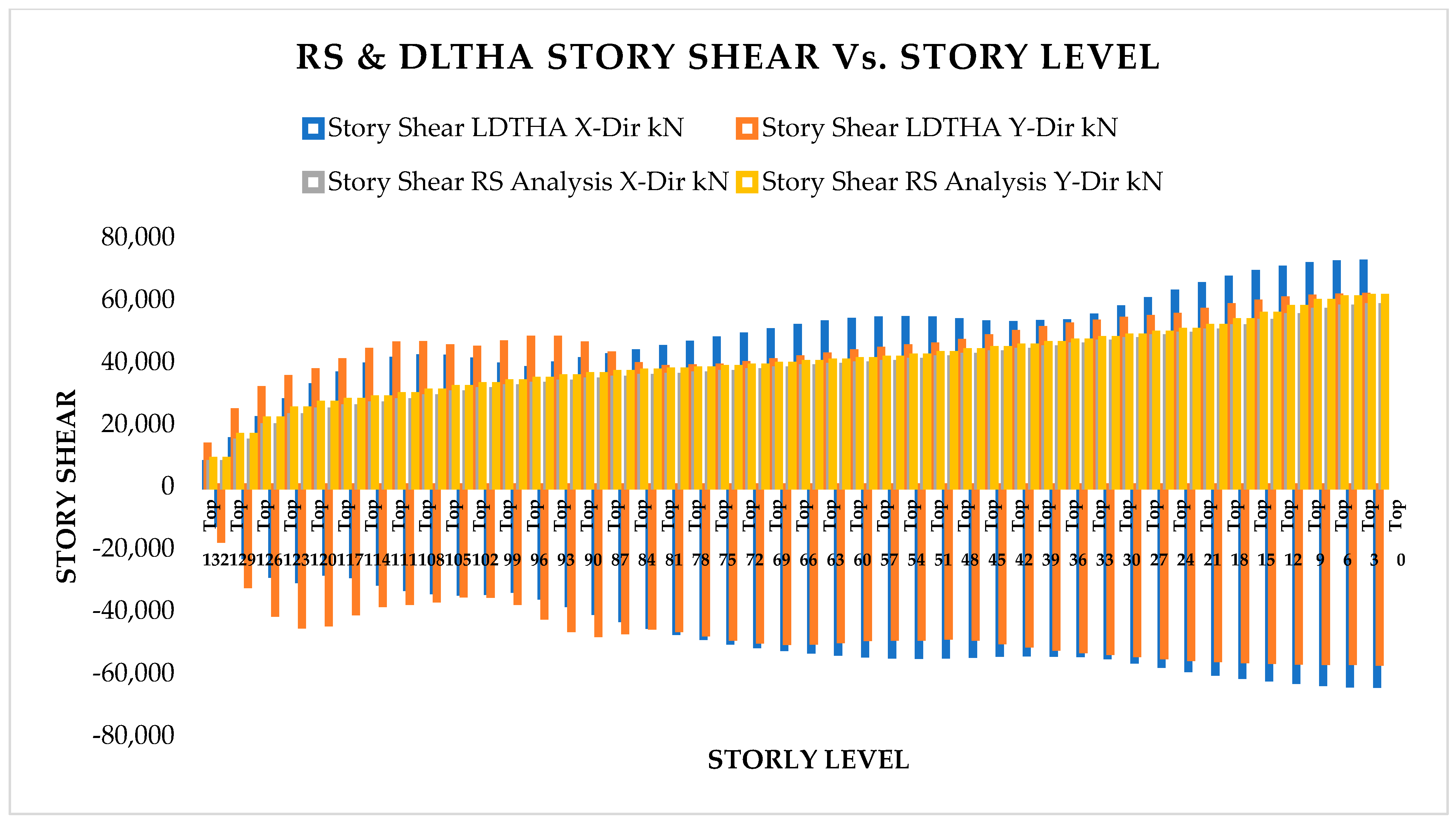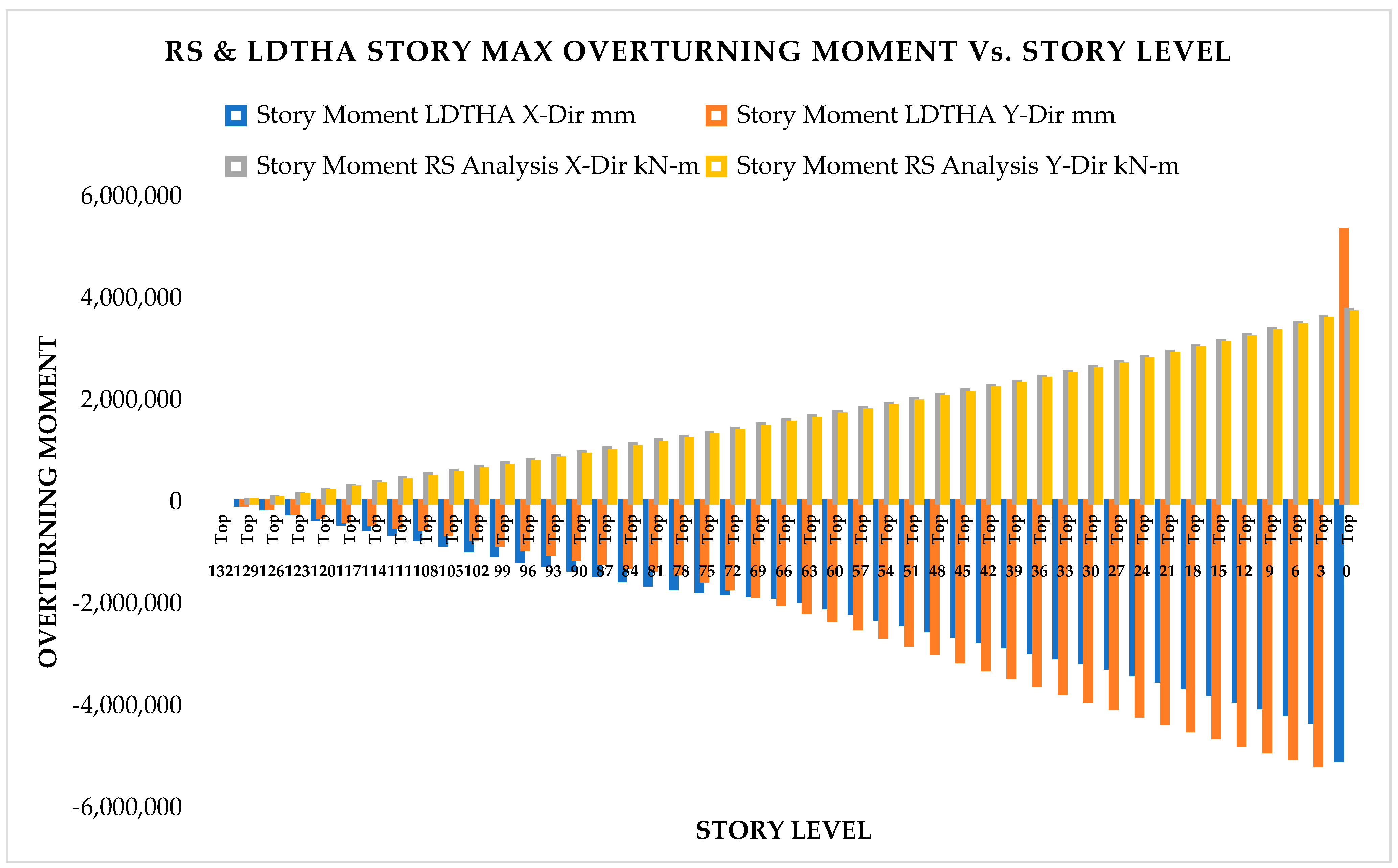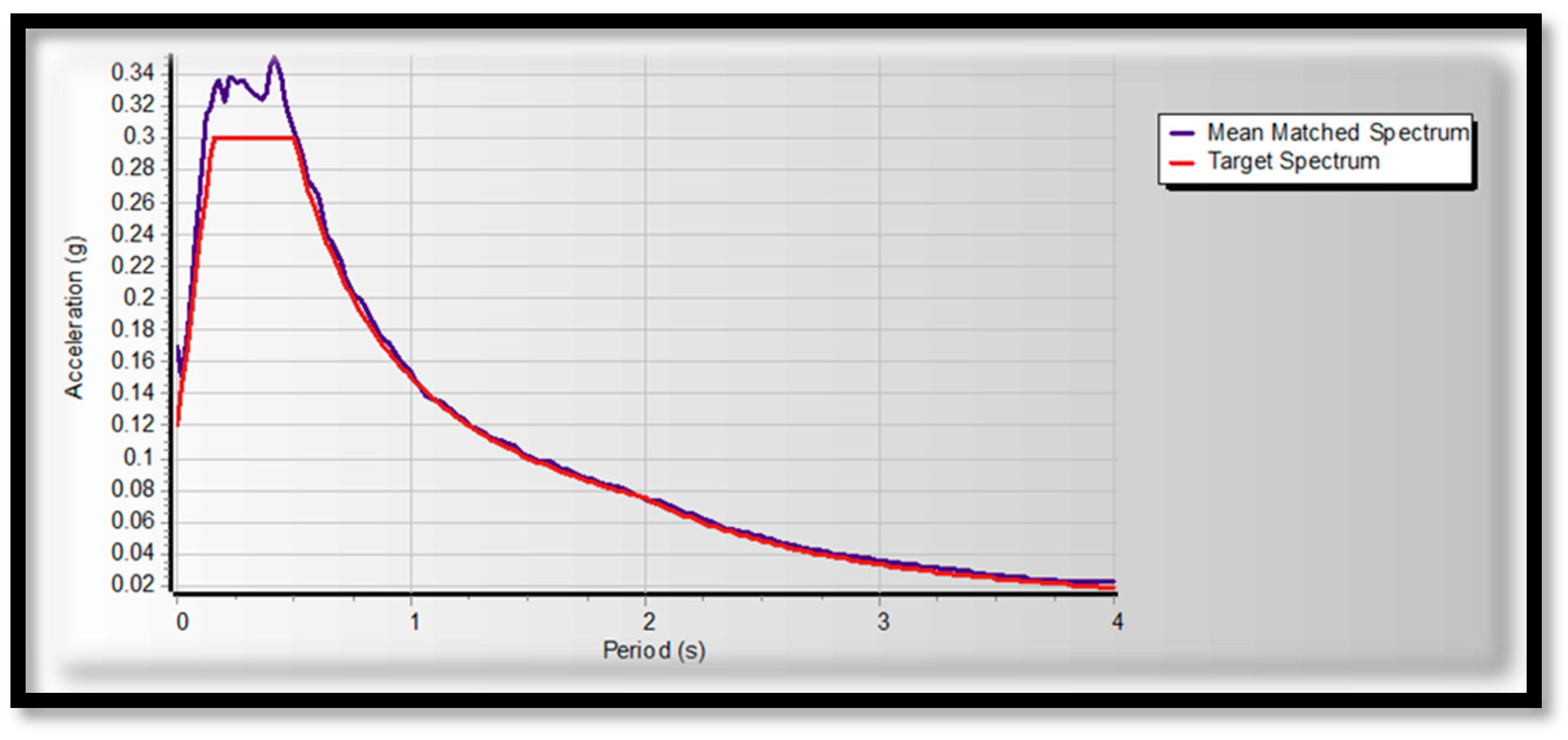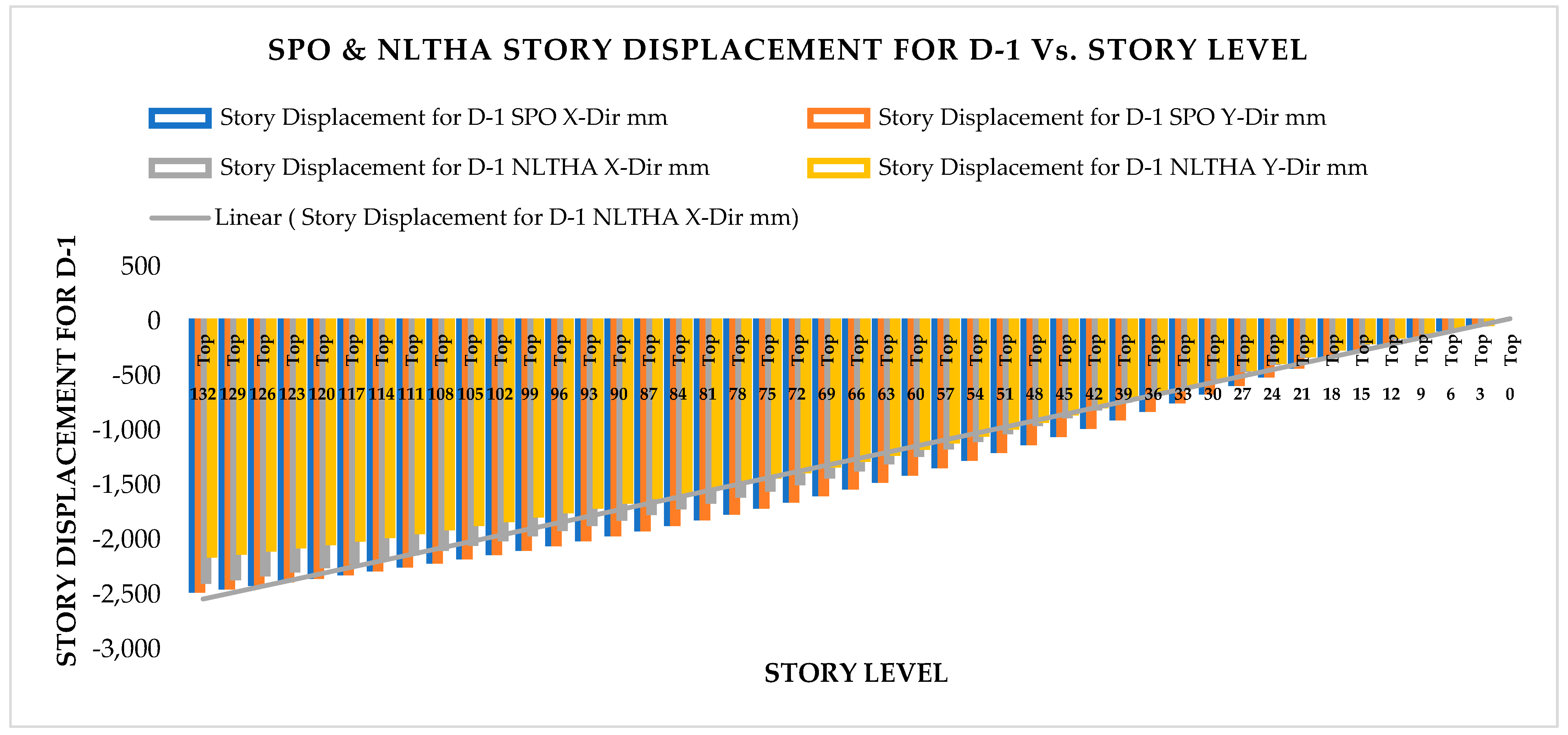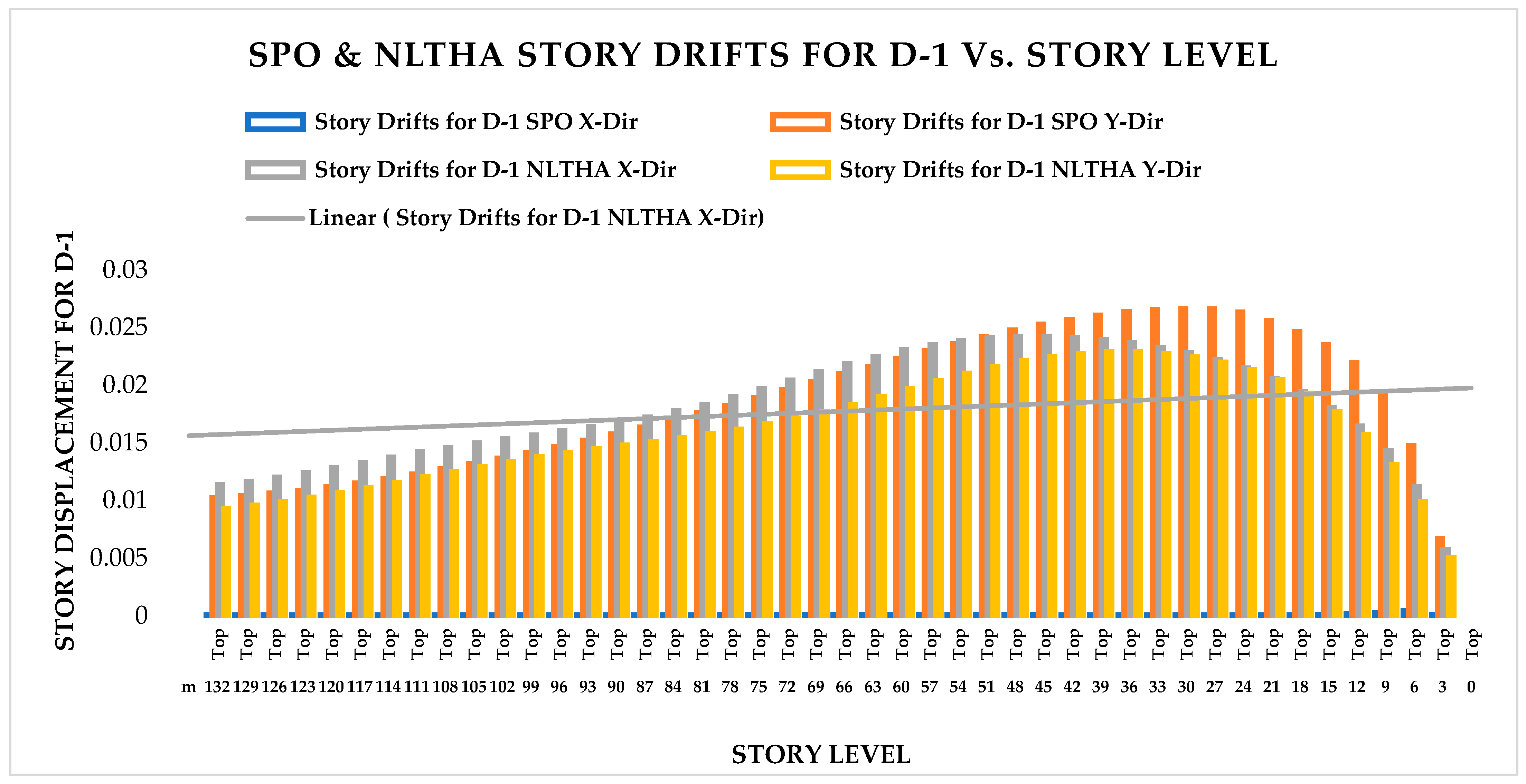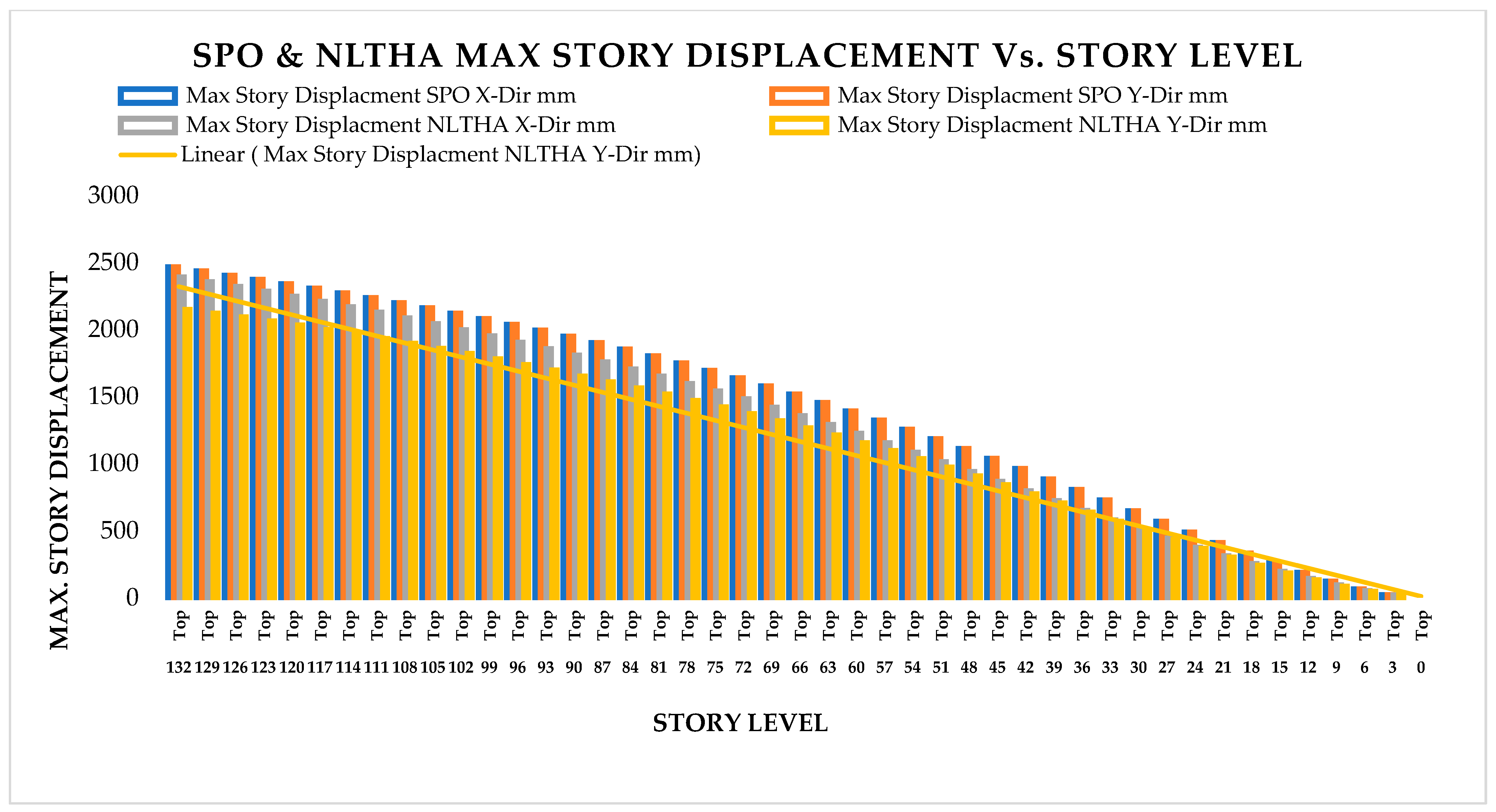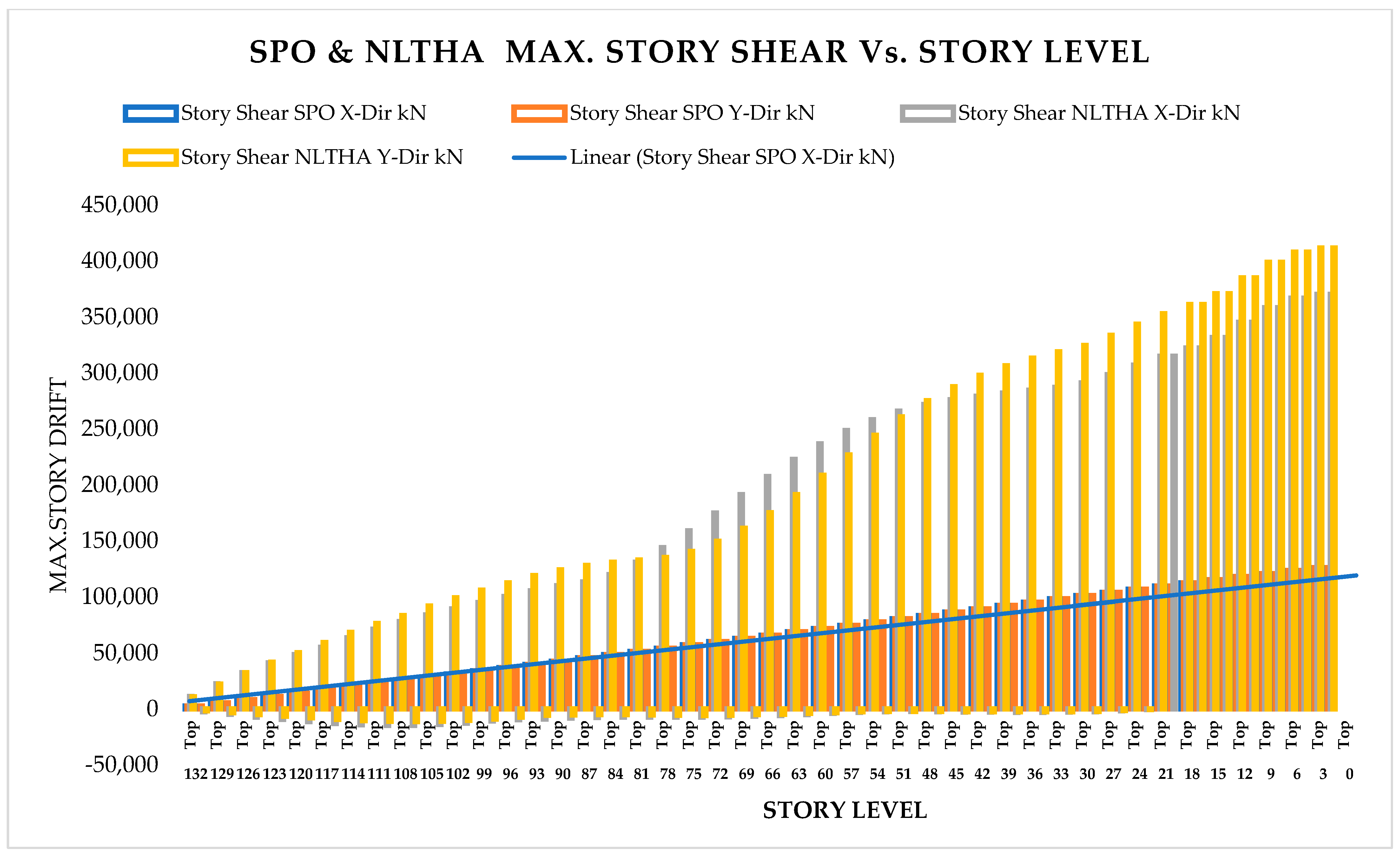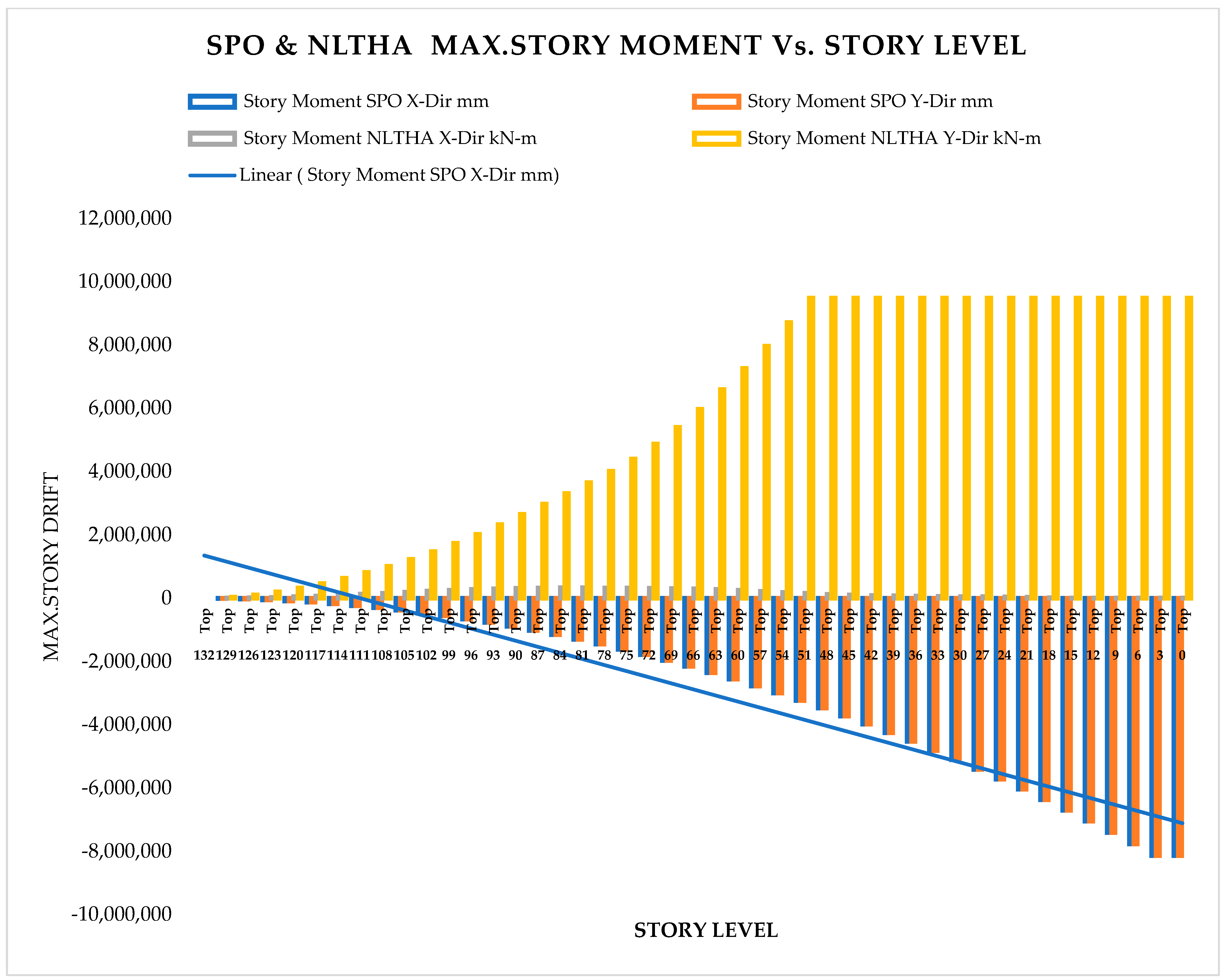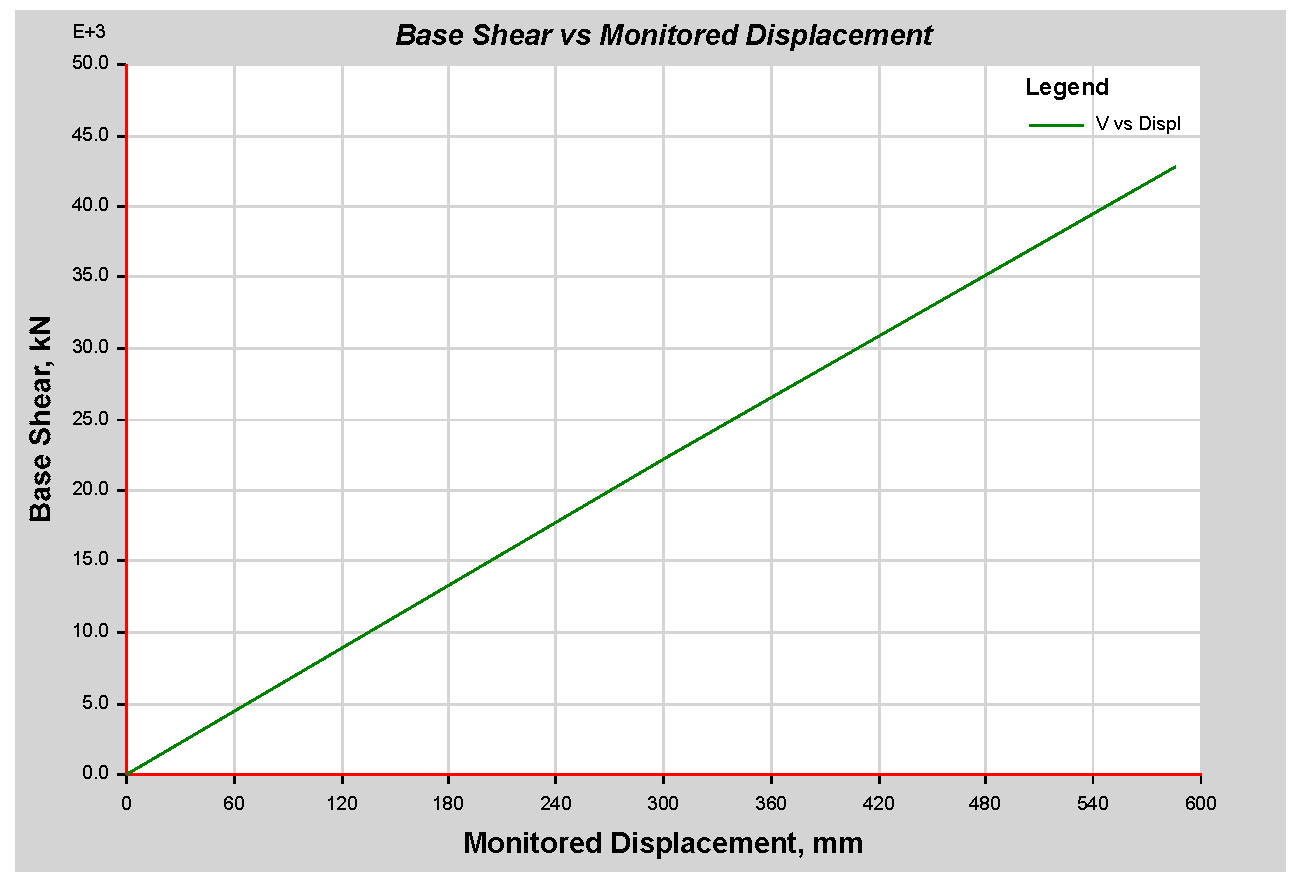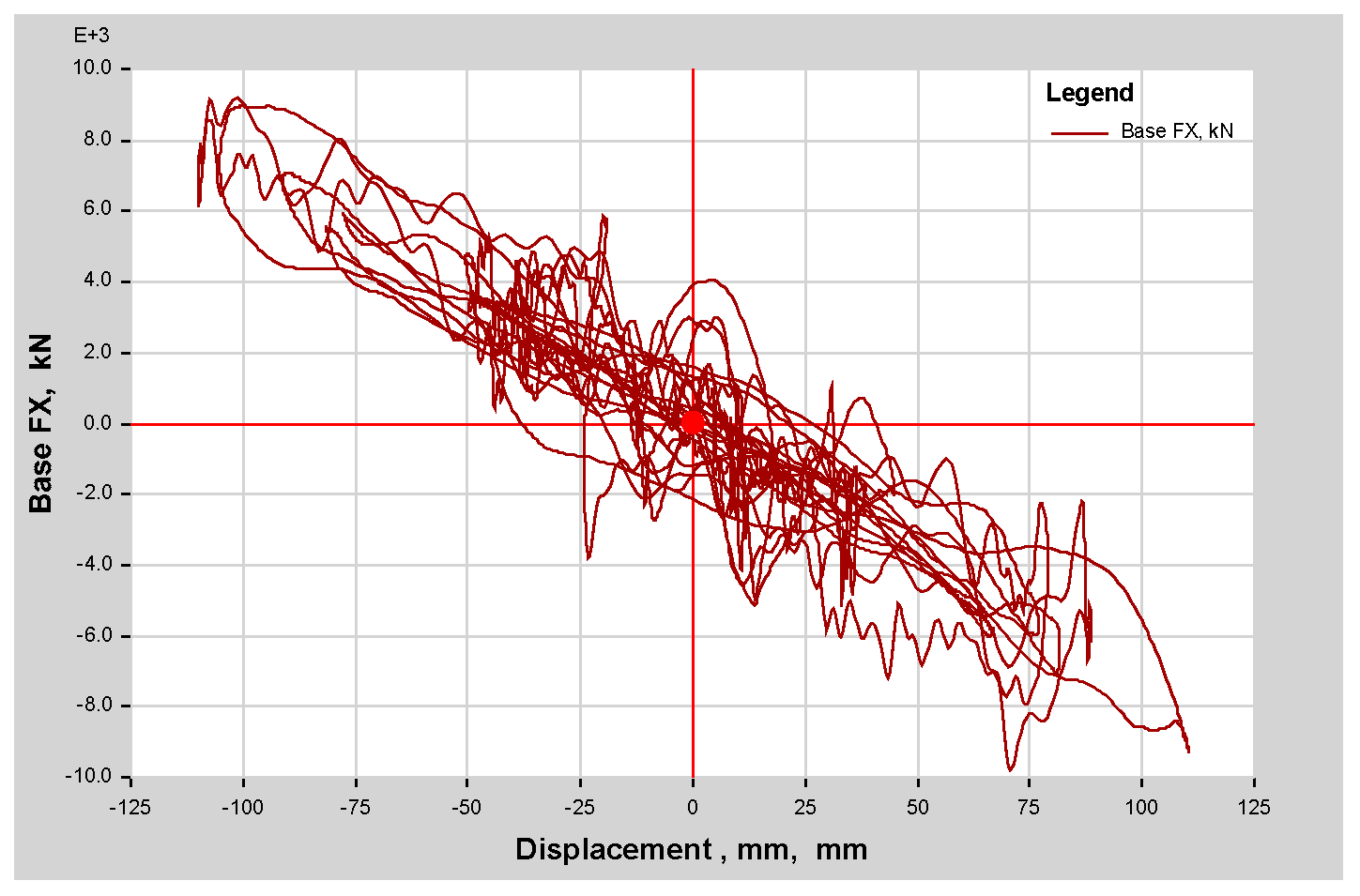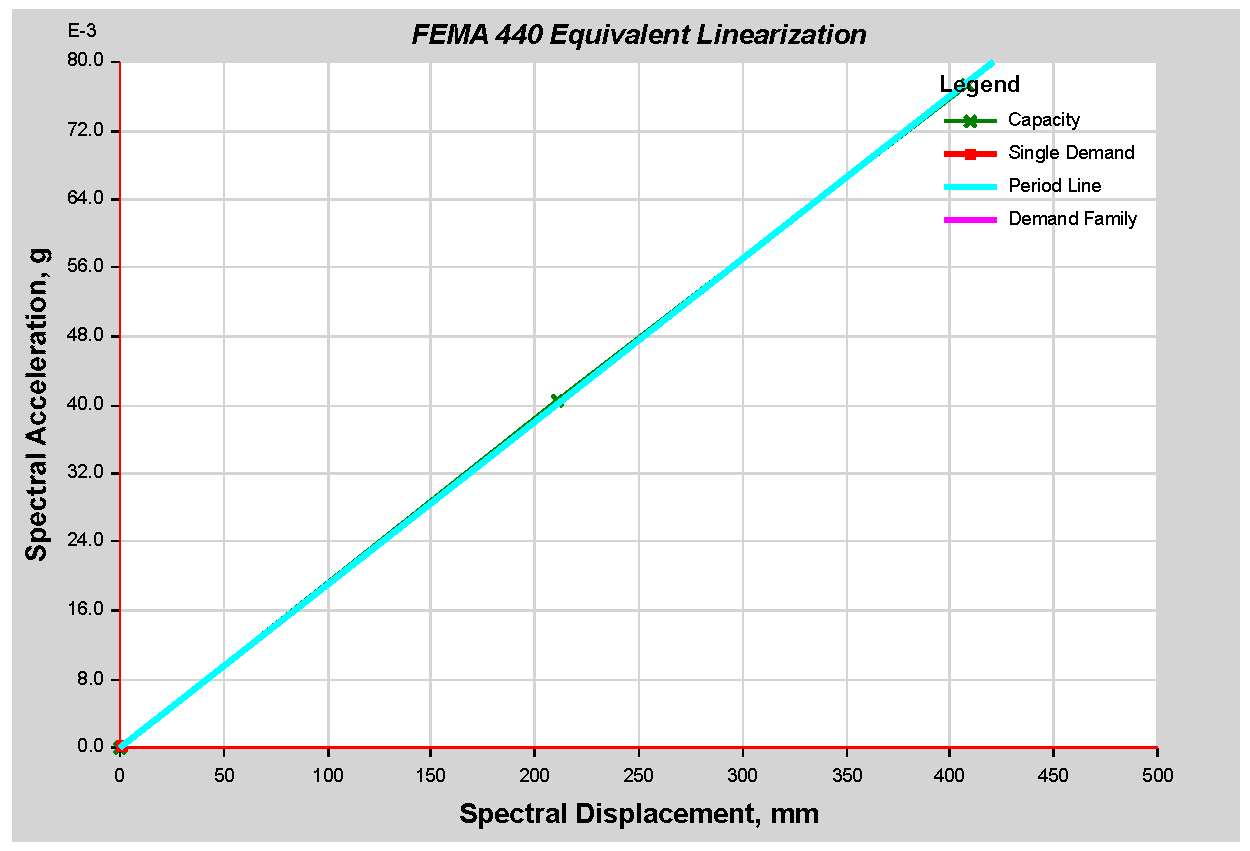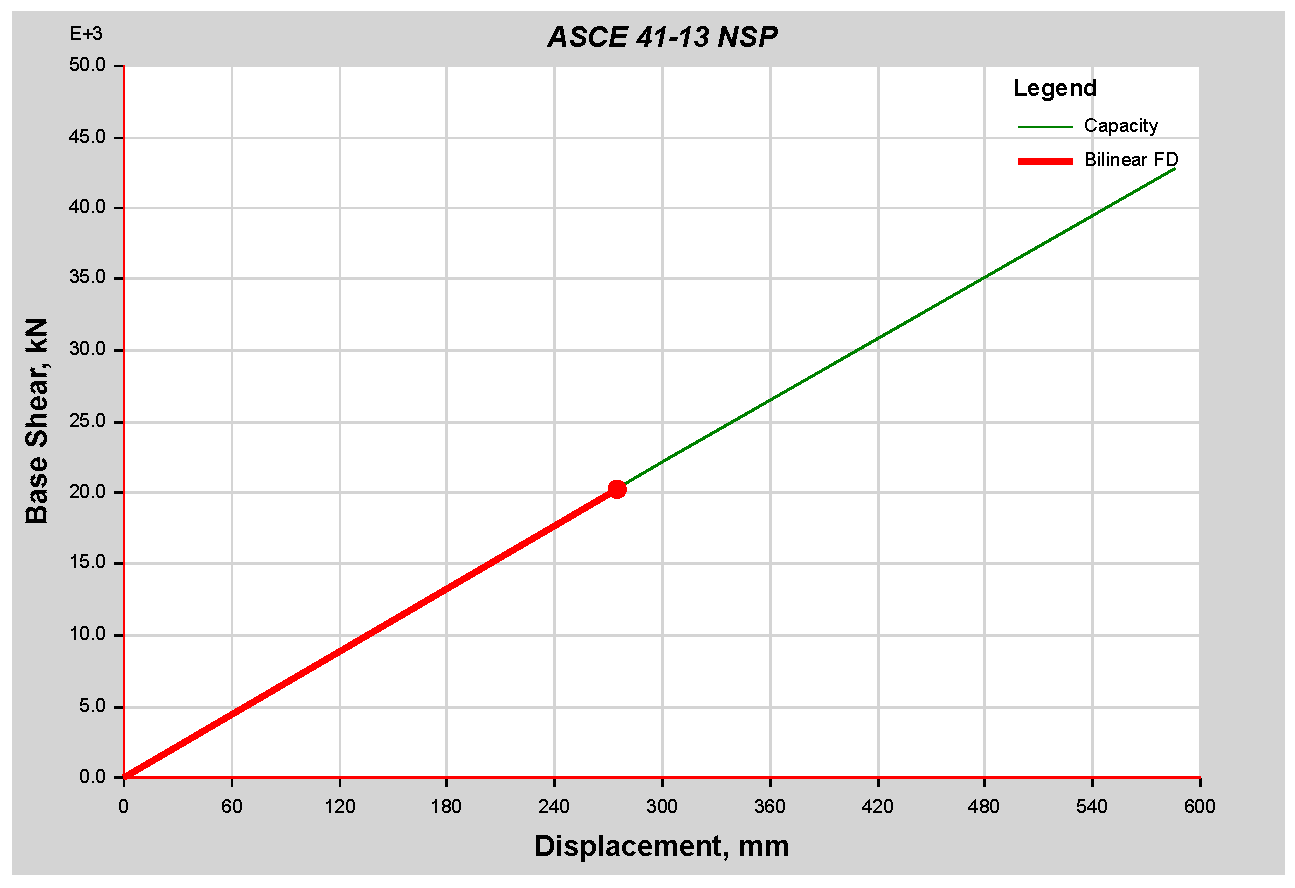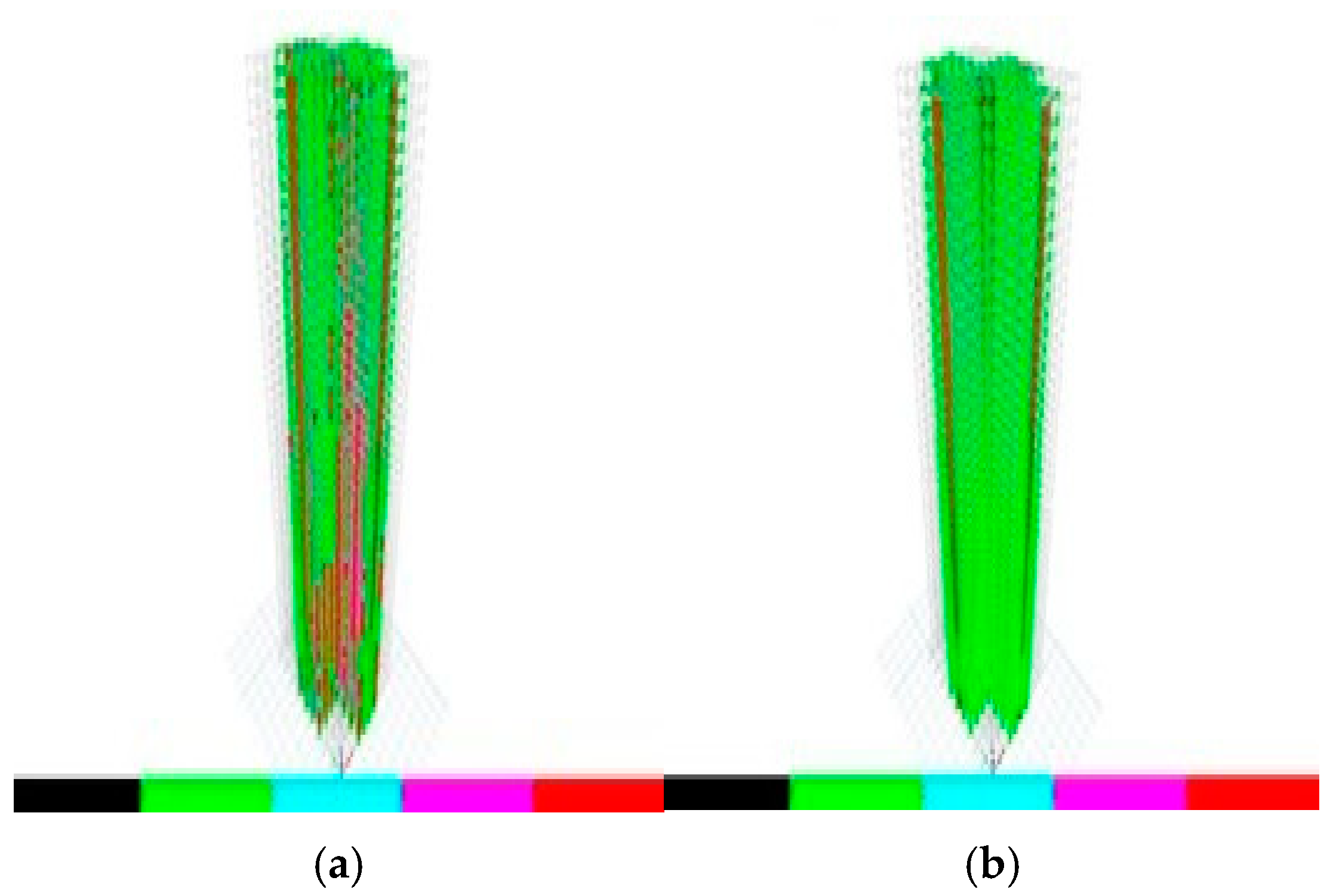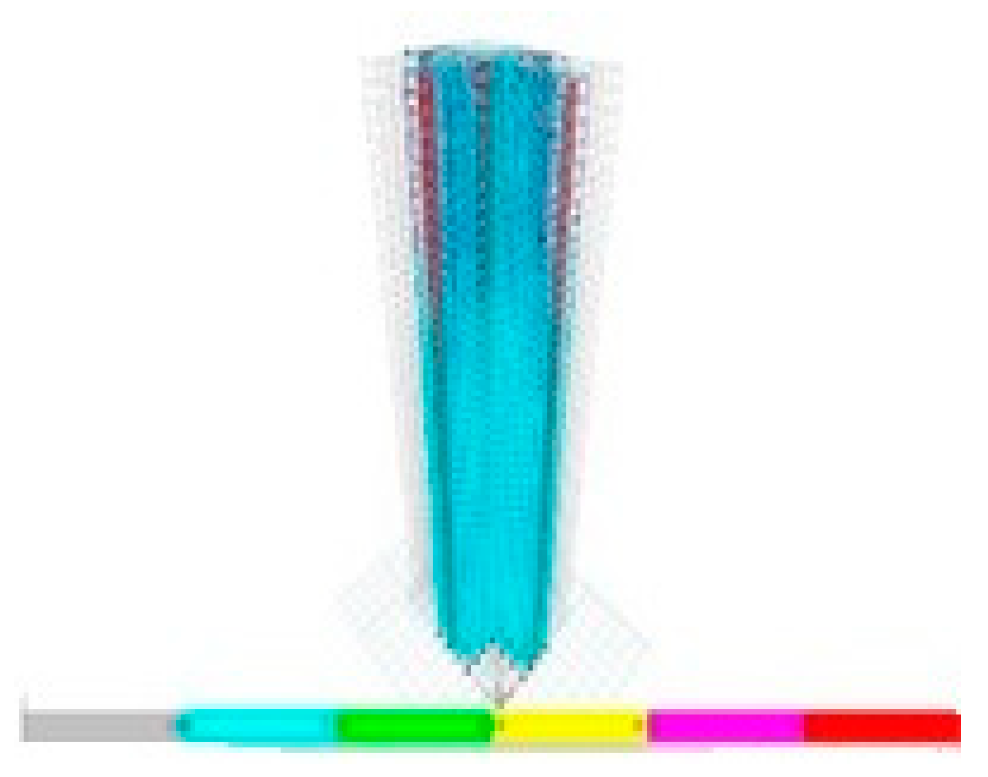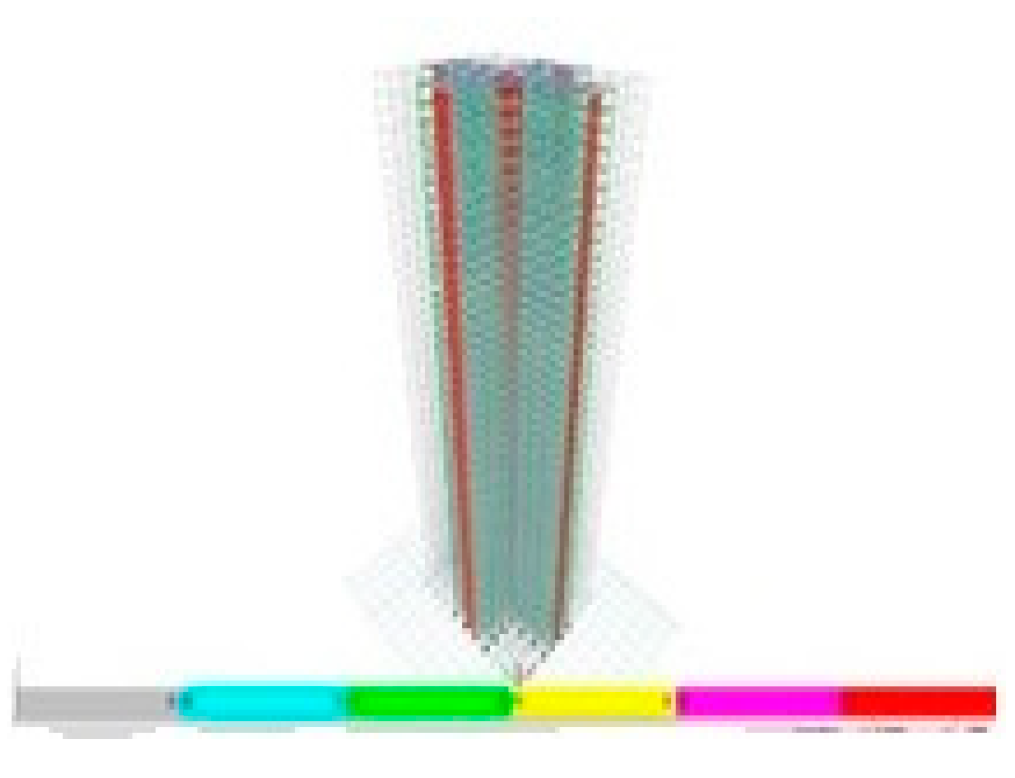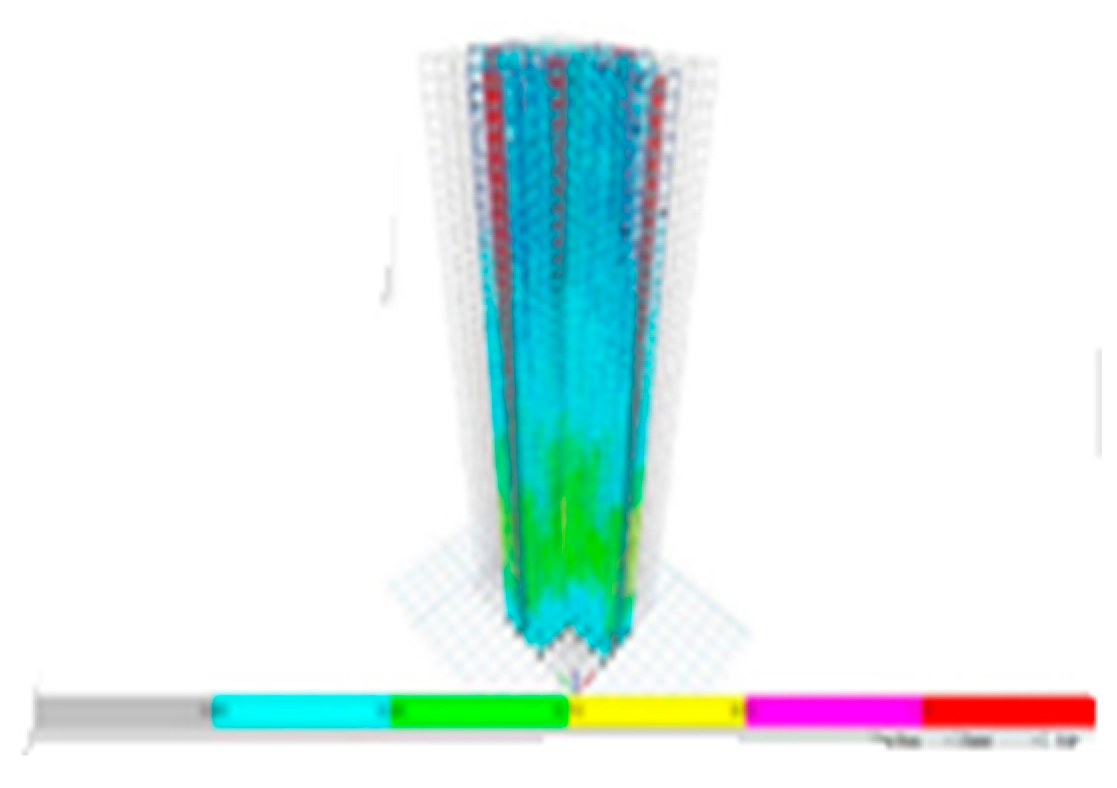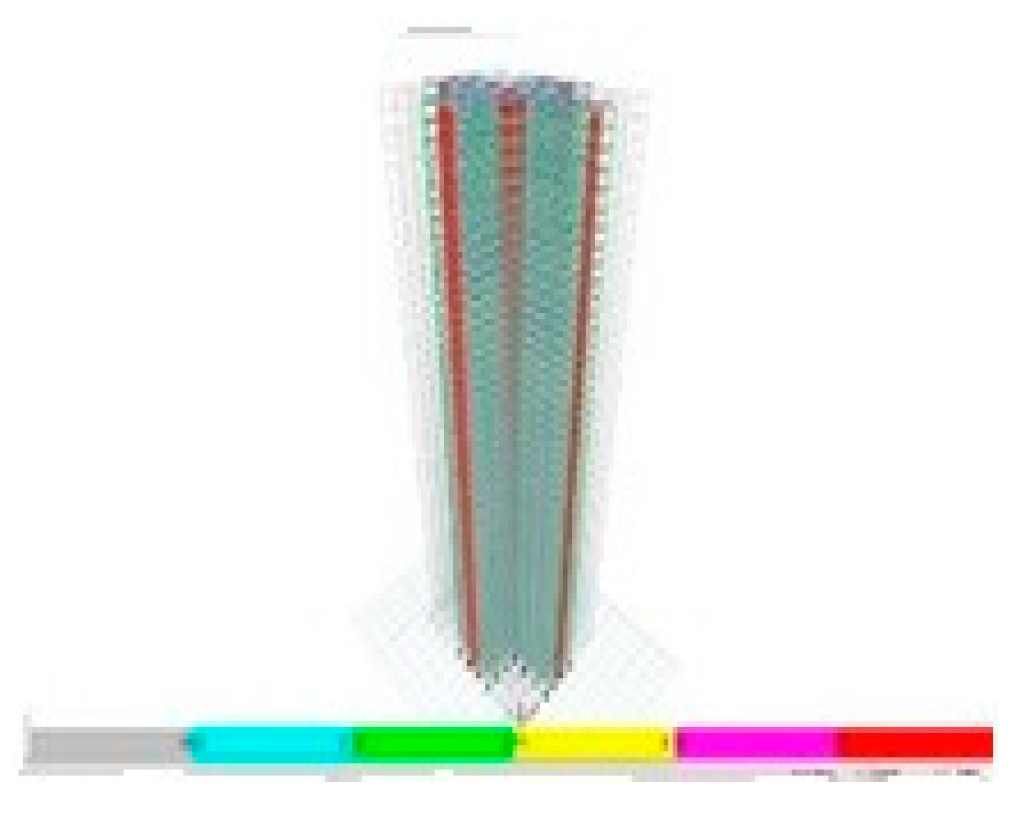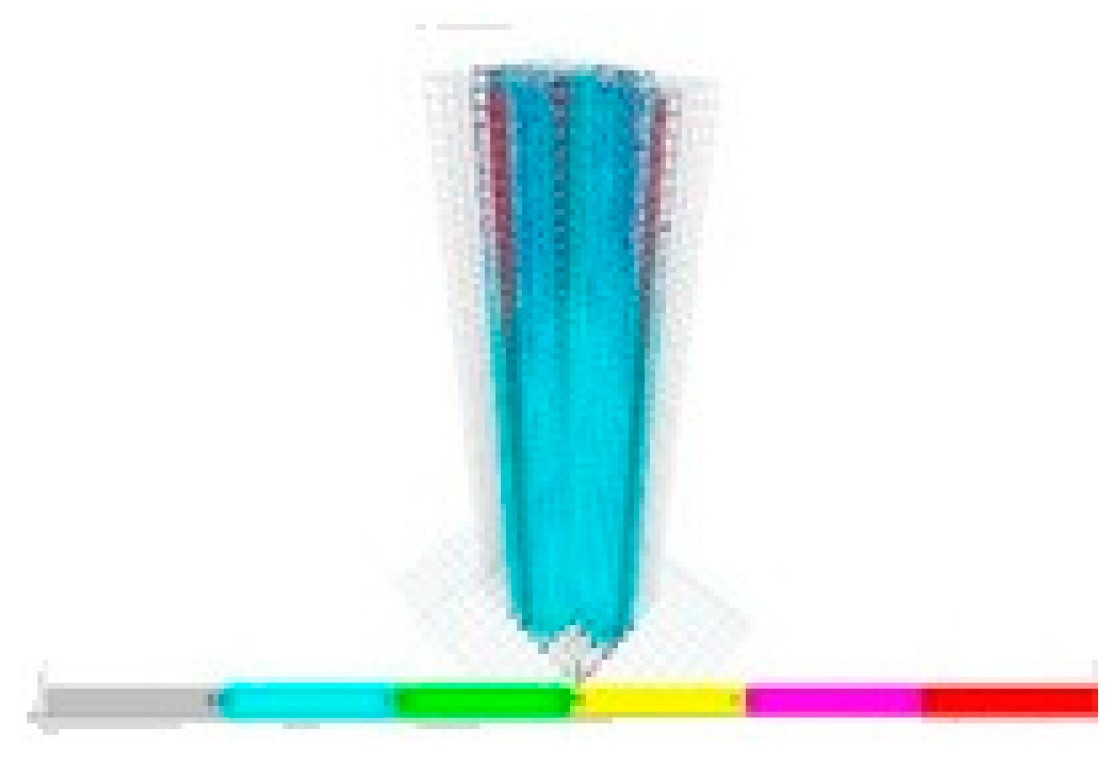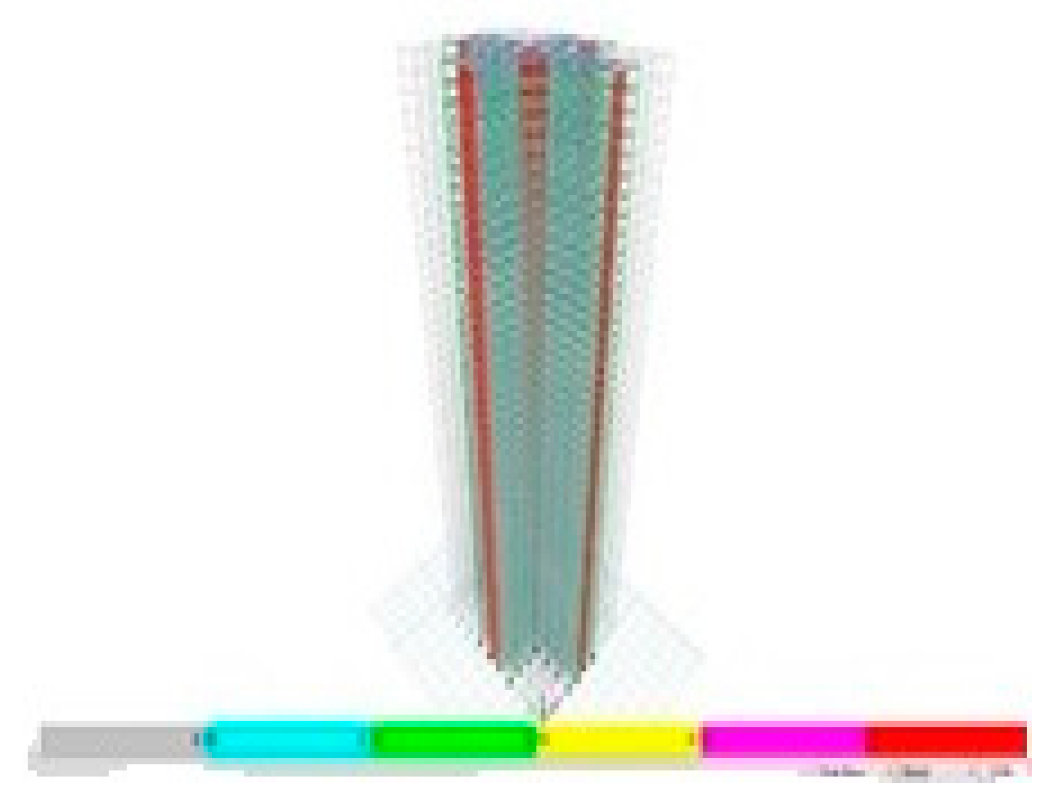1. Introduction
Ethiopia’s rapid appearance of high-rise structures raises worries about the country’s adopted reinforced concrete design code. Ethiopia lacks a seismic design code, relying instead on European standards.
Ethiopia is susceptible to earthquakes and recently the United States Geological Survey recorded an earthquake measuring a magnitude of 5.8 and Ethiopia’s government has said it is evacuating approximately 80,000 people following a series of small-scale earthquakes in the Afar, Oromia and Amhara regions as shown in
Figure 1. The eruption in the Rift Valley, which runs through the center of Ethiopia, is one of the testimonies of the country’s severe risk. Simultaneously, the region is generating increasingly significant real estate projects. This may be disastrous for developing nations like Ethiopia, which are not prepared for earthquakes like the one with a large magnitude that occurred in Haiti.
Hence, this research details the entire design of a 44-story reinforced concrete sample model based on Eurocode 8-2004 code. Classical modal analysis, RS (Response Spectrum Analysis), and LDTHA (Line Time History Analysis) were done on the 44-story sample RC building. SPO (Static Pushover Analysis) and NLTHA (Non-Linear Time History Analysis) were also done on a 44-story sample structure to determine global and local responses such as story shear, story moment, story stiffness, and story displacement. Comparable areas include the formation of plastic hinges and static and dynamic pushover curves [
1].
Additionally, the most recent Ethiopian earthquake code, ES8-2015 (hereafter referred to as “ES8-15”), as well as additional significant codes, have been adopted based on European Standards EN1998-1, which are the same as Eurocode 8-2004 [
1]. Gouin developed the first seismic hazard map in 1976 to study seismic risk assessments in limited regions of Ethiopia. This aided in creating the first Ethiopian building code, ESCP-1: 1983. Additionally, Kebede and Asfaw examined the map in 1996, and the conclusions were included in the second nation-building code, EBCS-8: 1999. Kebede and Van Eck reviewed the dangerous characteristics of Ethiopian and neighboring earthquakes in 1997 and concluded that there were no significant differences in the map and effects of the 1996 Kebede earthquake hazard map. However, it is believed that they analyzed the spectral response in other cities and industrial areas [
2].
Additionally, Ref. [
2] examined the hazard map of Ethiopia and adjacent countries in 1999, examining the influence of rock formation on a 10% exceedance over a 50-year case. Later, an examination of the potential for earthquakes in Ethiopia and neighboring countries incorporated the Poisson earthquake model and the related catalogue, which Ayele reported in 2017, and the 475-return period was used to develop Ethiopia’s third-generation building code. The current research has little regional impact or inadequate reaction regarding topography, groundwater response, or slope. As a result, the Ethiopian seismic hazard map must comprehensively examine groundwater changes or local soil conditions, climate and slope impacts, groundwater hydrology, slope, and other necessary parameters. Finally, it is concluded that further interdisciplinary study is required to enhance the Ethiopian seismic hazard map (e.g., logical tree considerations). Ethiopian high-rise building design and construction are still in their infancy, and the authorities are worried about the quality of the local consultants. Since 2005, various initiatives targeted at bolstering the domestic building sector have been implemented. However, owing to the absence of such measures, the status of the domestic building sector continues to worsen. Local contractors and managers lack the necessary skills, state-owned firms are inefficient, corruption exists, there are unsustainable employment possibilities, technology is antiquated, and supporting policies are lacking. Unfavorable economic circumstances, for any reason, are all impediments to adoption [
3].
In conclusion, it is believed that further interdisciplinary study is required to enhance the Ethiopian seismic hazard map. Hence, instead of relying on the inaccurate hazard map of Ethiopia, in this paper, to improve the seismic performance of the new and old design buildings, the adoption of the state-of-the-art design methodology, and a performance-based design approach, is necessary. Hence, in this paper, we perform the full-scale 44-story sample reinforced concrete design to demonstrate the application of a performance-based approach to real-world structural design.
1.1. Research-Specific Aims and Objectives
To explore the primary hazards of adopting foreign building codes in Ethiopia without adequate adjustments to account for the country’s unique geological conditions when designing and constructing tall structures, and to compare the two design approaches, code-based linear analysis and PBD.
To explore strategic recommendations for effectively utilizing the design findings of this paper, which employs the cutting-edge Performance-Based Design (PBD) approach, specifically nonlinear dynamic analysis (such as NLRHA).
This analysis procedure aligns with the updated ‘Tall Buildings Initiative’ and the ‘Guidelines for Performance-Based Seismic Design of Tall Buildings, 2017’, developed by the Pacific Earthquake Engineering Research Centre (PEER).
Additionally, the objective is to propose integrating the PBD approach into Ethiopian e-government policies and as a guiding framework within local consultancy and construction firms.
1.2. Problem Statement
Ethiopia’s current seismic design, adopted from European norms, is generally sound. However, adopting a code presents a challenge; some requirements need to be considered, one of which is the seismic hazard map of Ethiopia.
Unfortunately, we have lost considerable historical earthquake data due to a lack of seismic recording stations, finances, and technical personnel. As a result, Ethiopia’s current seismic hazard map remains preliminary, casting doubts on the reliability of its seismic design code.
Can we rely on structures designed using it if we cannot trust our current seismic hazard map? The answer is no. This raises the following question: how can we create structures that perform well in future unexpected earthquakes without a reliable seismic hazard map?
One option could be to rely on global seismic hazard maps. However, these maps often do not consider local geological parameters crucial for seismic design. This brings us back to the question: can we truly rely on global seismic hazard maps for our local needs?
1.3. Gap in the Literature
Lack of intensive and comprehensive RC design on 44-story RC buildings included almost all design procedures, such as Classical Modal Analysis, RSA, LTHA in linear model and SPO and NLTHA on nonlinear modelling with plastic hinge modelling. The approach is in one paper and in the design location of Ethiopia. In addition, 11 earthquake datasets extracted from the PEER website are unique to this paper. This makes this paper novel and original, opening the door for further research.
1.4. Research Questions
Does the absence of earthquake recording stations and reliable seismic data pose a significant challenge for countries without the means to generate accurate seismic hazard maps?
If we cannot trust our current seismic hazard map, can we rely on structures designed using it? The answer is no. This raises the following question: How can we design structures that perform well in future unexpected earthquakes without a reliable seismic hazard map?
Considering the absence of reliable seismic maps in certain countries, could performance-based design be a viable solution?”
Is the seismic performance of reinforced concrete structures designed according to Ethiopian ES8-15 corresponding to Eurocode 8-2004 standards (based on EN1998-1) seismic code recommendations effective or not?
Is there a consistency between Non-Linear Time History Analysis (NLTHA) and Pushover Analysis (SPO) compared to traditional linear analysis methods such as Classical Modal Analysis, Response Spectrum Analysis (RSA), and Linear Dynamic Time History Analysis (LDTHA) by the current Ethiopian building codes?
2. Literature Review
Advanced priority on decoupling structure designs from conformance to prescriptive adopted reinforced concrete design codes needs assessment, especially in the perspective of story stiffness, materials, cost, strength, and configuration, has created momentum [
1,
2,
3] toward the adoption of design paradigms that are premised on performance objectives. The efficacy of sustainable and resilient structure designs with specific performance expectations pegged on the spatial and temporal user needs and environmental dynamics has been affirmed extensively in the literature. Empirical analysis of the performance scale for the new design of structures indicates superior thermal performance [
4,
5,
6,
7,
8], improved load-carrying capacity [
9], higher durability [
10], and impressive response to seismic disturbances [
11,
12,
13,
14,
15]. Performance-based structure designs, the high structural and functional performance notwithstanding, exhibit defragmented implementation criteria due to variability in spatial and temporal performance needs across and along geographical contours [
16,
17,
18].
The resultant incompatibility of the performance-based structure designs between geographical regions introduces complexities in computing loading factors, dead load, wind load, economic value, and design analyses of structures subjected to similar performance conditions [
19,
20,
21]. Despite these challenges, the design paradigm offers a quantitative advantage in localizing reinforced concrete (RC) codes and standards, ultimately increasing their responsiveness to local conditions [
22]. The transference of the structure design codes between countries and regions can be achieved by adapting to the destination environment to create seamless conformity [
22]. Comparative analysis of ACI 318-08 and AASHTO LRFD design criteria for concrete structural designs by [
23] indicates the codes exhibit fundamental variances in moment capacity and flexural strength.
Performance-based structure designs necessitate reverse engineering, in which the nature of the desired performance results advises the design criteria. In [
24], it is noted that the shift to performance-based structure designs simplifies the mathematical modelling of the structure performance. The efficient integration of the design’s mathematical models potentially increases the accuracy of performance estimation [
25] and harmonization of the local structural designs [
26,
27]. It confers greater regulation and control of the structural performance of RC members in different applications [
28,
29,
30,
31], accurate estimation of structural failure under different load conditions [
32,
33,
34], and sustainable development [
35].
Design structures supercharged to conform to prescriptive criteria, as demonstrated in [
36], demonstrate a deficient capacity to respond to seismic disturbances. Similarly, variations in design codes affect the performance of the structures on key indicators, including the packing capacity of the materials, elastic stiffness, global lateral response, peak strength, and target displacement, among others [
37,
38]. Flexible design codes allow cost-effective temporary work designs [
39] to retain uniformity, clarity, consistency, and repeatability in structure design and analysis [
40,
41] and simplifies designs [
42]. Generally, the impressive performance parameters of the design paradigm facilitate the seismic fragility analysis of the structures [
43,
44], the temporal dynamic behavior of RC structures [
45], and the seismic function of the interactivity between structural and non-structural members [
46]. In addition to that, modular construction offers efficiency but poses unique seismic challenges due to discrete diaphragms and weak inter-module connections. A study on a 9-story RC modular building found that central RC walls induce torsional flexibility, and seismic collector rigidity impacts force response. It also highlights ASCE 7-16’s limitations, stressing the need for improved seismic design methods [
47].
Generally, the intrinsic qualities of the codes are determined by the deliberate trade-off made to achieve the desired standards and market demands. In [
48], a comparative analysis of European Structural Codes (Eurocodes) and British Standard Codes shows marked differences in effective area, cost, and structural performance. Such differences in design codes are reflective of a local need’s assessment of structural performance, such as RC ductility, longevity, sustainability, and durability in different load conditions [
49]. The fundamental principles of performance-based structure design codes provide a platform for optimizing the performance indices of the RC members, steel, components, or their combinations.
Recently, Ref. [
50] has demonstrated that the architecture of the system provides a stable platform for launching topology optimization frameworks to develop functional concrete structures, create variable friction systems with minimal hysteresis [
51], optimal use of the structure, and elimination of torsional deformability [
52], limit structural failure [
53,
54,
55,
56,
57,
58,
59,
60], alleviate the corrosion-related deformity of RC elements [
61], and increase the overall reliability of the RC structure [
62,
63]. According to [
64], transparency and continuous improvement of the design codes form the rampart of the system functionalities. In [
65], the Eurocode 8 (EC8) is evaluated to make it highly efficient in controlling and predicting the earthquake behavior of steel moment-resisting frames (MRFs) by minimizing the volume and weight of the material and enhancing consistency in the true-to-performance between design predictions and ductility response spectra of the structure to seismic waves [
66,
67,
68,
69].
A comparative analysis of the performances of different systems codes is reported extensively in the literature. In [
70,
71,
72,
73,
74,
75], the American ACI code is noted to have higher story shear and drift indices compared to AC8 and the Indian Standard (IS) code [
76,
77,
78,
79,
80,
81,
82,
83,
84]. However, the displacement index for the three systems is close to the source of the displacement force [
85]. The displace increment, along with the stories from the base story upward, is 50% for the IS and 70% to 80% for both the ACI and EU8 codes. In essence, the IS emerges as an ideal model and a standard for (PBD) performance-based design of structures on account of its sustainable performance and high level of predictability and controllability [
86,
87,
88,
89,
90,
91,
92,
93,
94,
95]. The efficacy of the IS code is investigated in detail in [
96,
97,
98,
99,
100] with significant findings point excellent seismic performance and spectral displacement. In [
101,
102,
103] a comparative analysis of the Chinese Code (GB) and the ACI shows the latter code has a material density inefficiency ranging between 8 and 10% compared to the former code [
104].
The anomaly in the performance indices of the modern codes is primarily a function of differences in their efficacy in assessing structural components [
105] assessment methods and approaches [
106,
107,
108] seismic design methods [
109,
110] and the seismic vulnerability of the structures [
111,
112,
113]. Other influencing factors include the component-level seismic performance of the structure [
114,
115] seismic zoning [
116,
117] level of seismic code enforcement [
118,
119] projected or anticipated member capacity [
120,
121] risk-inconsistencies and code conservativeness [
122,
123] and the ductility factor of the structure [
124,
125] also influences the efficiency of the codes. The level codes’ flexibility influences their performances with variances ranging from ductility for highly flexible codes to rigidity for lesser flexible codes [
126,
127,
128]. Optimal design considerations for structure components offer better control over the code shear and seismic failure performance [
129,
130,
131] energy dissipation performance [
132,
133] torsional effect [
134] and structure component performance [
135,
136,
137].
The development and adoption of performance-based structure design are still in their infancy. Regular reviews of the codes are critical to improving their efficacy [
138,
139] changing environmental dynamics, design philosophy, and market demand [
140,
141,
142,
143,
144]. Continuous improvement of the codes demonstrates a marked reduction in their performance discrepancies in the assessment of key parameters [
145,
146] strengthening of building safety [
147] better performance against seismic loads [
148] implementation and training [
149] and cross-compatibility [
150]. The evolution of the codes is energized by innovative designs [
151] models [
152] greater control and adaptation environmental dynamics [
153] and pegging their design on targeted performance. The technology provides a better alternative to the classic linear elastic techniques [
154].
3. Materials and Methods
Reinforced concrete 44-story multi-storied buildings are analyzed and designed according to the specifications described in the Ethiopian earthquake design standard ES8-2015, based on the building code Eurocode 8-2004, and PBD with the same local condition as shown in
Table 1,
Figure 2 and
Figure 3. Both linear and nonlinear models are analyzed and built under similar loads and design conditions. Thereafter, seismic assessments were performed using a pushover based on ASCE 41-17 requirements, FEMA 356, and ATC 40. Pushover analysis is a practical way to perform seismic analyses in buildings. Compared to conventional elastic analysis, it gives valuable information about future structural reactions and provides an understanding of the structural features that influence capacity during major future earthquakes. Additionally, it exposes design flaws that the elastic analysis process cannot capture; for example, it can detect the most critical portions of a structure regardless of its limits. It is suggested as the benchmark for typical models examined, particularly in the first dominant mode. Additionally, nonlinear dynamic analysis was used to validate the pushover static analysis findings. These are important components of performance-based design research conducted using the ETABS 2019 software. In this work, we used SeismoMatch 2016 and ETABS 2019 to select and modify different earth quicks, as shown in
Table 2, which is extracted from the PEER Ground Motion Database. The extracted earthquake data was used to analyze linear and nonlinear time history as shown in
Figure 2,
Figure 3,
Figure A1,
Figure A2,
Figure A3,
Figure A4,
Figure A5,
Figure A6,
Figure A7,
Figure A8,
Figure A9,
Figure A10,
Figure A11,
Figure A12,
Figure A13,
Figure A14 and
Figure A15, scaled and matched into our target response spectrum Type-I as shown in
Table A1 and
Table A2. As per the procedure, the first linear elastic design using the code-based design processes is performed with DBE level (10 per cent chance of being over 50 years, i.e., a return period of 475 years), and then the performance of the building is assessed under MCE level The chances of falling under an earthquake are very rare (2 per cent chance of being over 50 years, i.e., a return period of 2475 years). The study used models of a specific weight factor and development in various analyses, such as SPO, NLTHA, RS, and LTHA, and compared seismic performance results.
This section discusses designing a model building used in the study by building code ES8-15 (EN1998-1). Later, the project findings will be used to evaluate the seismic performance of nonlinear models. Functional structures, loads, and geometric models are very similar in comparing earthquakes’ design and distribution methods between linear and nonlinear types of analysis. With the design of the beam and column connecting parts, the concrete is almost identical, and the strength of the reinforcing steel is used as described in the Ethiopian ES2-2015 code. Twenty-eight-day compressive strength, as shown in
Table 1, the stress–stress relationship of concrete in Ethiopian Code ES2-2015 is calculated using the same H-Rusch calculation as a member design. Gravity and lateral seismic loads are included in the design load. Gravity load consists of two parts: the dead load, which does not include the self-weight of the building, and was kept at 3.0 kN/m
2. In addition to the dead load of the filling walls, the load distributed in standard beams is set as 15 kN/m. Additionally, 2.0 kN/m
2 live load was used as specified in ES1-2015. Additionally, as defined in ES8-15 for dynamic analysis, 30% of the LL, in addition to the DL, was used when calculating the seismic weigh.
The ESEN 2015 code complies with the requirements of Eurocode 8-2004 by dividing the soil into five critical categories, A to E.
Table A1 and
Table A2 show each with its soil importance factor (S), soil type (B), and shear wave velocity (V30) used in this investigation. PGA is determined in Ethiopia using rock ground type A. In addition, 0.1 g Addis Ababa (Zone 2) in ES8-15 is used in this study to develop structural models. Therefore, ES8-15 uses a design RS (inelastic response spectrum) in addition to the linear response spectrum, as shown in
Figure A16 and
Figure A17. Additionally, the algorithm uses a response spectrum in various ways to measure the magnitude of seismic input into building models.
It is obtained by modifying the elastic spectrum of the structure by ductility, as well as the characteristic factor, q, and calculating the indirect influences present in the structure members. The behavioral factor q measures a building system’s ability to withstand nonlinear earthquake activity.
This is an approximate amount of seismic force that a building would face if its response were fully elastic and seismic forces decreased by 5% viscous damping. It can be used with an elastic analysis model to ensure the structural response is acceptable. The structural system determines the value of a behavioral factor, q. According to ESEN 2015, the q value of RC structures varies between 1.5 and 6.75. The value varies depending on the ductility and design standard, and finding the correct number requires nonlinear analysis and the response frameworks of the code ES8-15. The graph shown in
Figure A16 and
Figure A17 is constructed using the same design as for an earthquake risk level of 10% over 50 years and 5% damping. It is equivalent to soil B (PGA = 0.1 g, compared to soil type A), with a soil importance factor S = 1.35. ES8-15 design response spectrum serves as the basis for model frames and gravity loads and is used to test the design of structural components. Earthquake demand is reduced by about 1/5.85 in ES8-15.
5. Conclusions
The seismic performance of the 44-story linear and nonlinear RC sample building was designed according to the ES8-15, FEMA 356, ASCE 41-17, and ATC 40 recommendations. This study investigated the SPO and NLTHA techniques. In both of these design processes using nonlinear and linear sample models, the study used the same 44-story RC model frame developed using a capacity design approach.
Following SPO design processes mentioned in FEMA 356, ASCE 41-17, ATC 40, and the provisions in the relevant ES8-15 codes for verification purposes, NLTHA was used to evaluate the result obtained from SPO analysis. A comprehensive analysis of the nonlinear timeline history with 11 selected EQ was performed on a 44-story RC structure, which ensures good agreement with SPO analysis results. Overall, from linear and nonlinear analysis results, significant conclusions were identified and presented as new scientific knowledge about the issues of designing earthquake-resistant reinforced concrete structures, engineering application of the obtained results, and the development of scientific research on this topic in the future as follows:
As per Classical Modal Analysis, the RSA and LDTHA analyses of the sample linear 44-story buildings show that the structure’s four global responses are higher for LDTHA than for the RSA analysis result.
As per linear analysis results for 44-story buildings, LDTHA shows maximum story displacement of 25.68%, maximum inter-story drift ratio of 25.68%, story shear of 15.35%, story overturning moment of 27.5%, fundamental period 2% higher than RSA results of observed.
As per the linear elastic analysis result the fundamental period first mode found from classical modal analysis for 44 stories was 3.956 s. From RSA analysis, the 1st mode period was 3.806 s. Similarly, the fundamental period for DLTHA was found to be 3.883 s, which indicates that the 44-story model used in the study was correctly implemented. In addition, for all three analyses, it has been observed that the first two modes are translational, and the third mode is torsional as required by different coda and guidelines.
As per the Pushover Analysis result of roof displacement of up to 2% by the ATC 40 recommendation, the output generated was a smaller capacity curve than NLTHA. This demonstrated that NLTHA analysis is superior to SPO analysis and it also justifies the claim that SPO analysis is an approximate analysis type.
As per the analysis result following ES8-15, FEMA 356, ASCE 41-17, and ATC 40 recommendations, more plastic hinges and energy dissipation first appear on the beams rather than on the columns. This shows the excellent scenario of a weak beam and strong column case, and they are evenly distributed along the length of the structure. The result also shows that for the 44-story RC sample building as per ASCE 41-13 SPO performance assessment graph, the target Displacement and Base Shear results are 114.751 mm and 16,694.9227 (kN). In addition,, the performance point result found as per FEMA 440 EL is target displacement 120.294 mm and Shear 17,455.2248 kN, with a slighter difference from the ASCE41-13 result. The result was verified with NLTHA and the dynamic pushover curve gives the exact target displacement at 2% of the height of the building, which was around 2358 mm for a maximum shear force of 0.411445 × 106 KN. The nonlinear static result gives 2464.3 mm for a maximum shear force of 0.126002 × 106 KN. This demonstrates that the performance of the sample building result was verified with NLTHA and it gives a satisfactory result. Hence, this result shows the use of SPO is adequate in a situation where finding real ground acceleration is difficult. Thus, until the performance point evaluation study is completed, it may be impossible to determine whether ES8-15 adheres to the Eurocode 8-2004 intended structure or is no longer favorable for future seismic force in the nonlinear range. The roof drift of 2% may exceed the design limit. It is also worth noting that one of the primary goals of seismic performance analysis is to identify any design flaws. Nonetheless, the ductility factor used in ES8-15 appears to be overestimated.
In general, we concluded the performance evaluation of all components created using the two analytical techniques. According to the code requirements, several fully flexible plastic hinge levels are available depending on the amount of earthquake force exerted on the structure. In addition, it demonstrates how the total number of hinges in the structure increased as the model was gradually pushed to achieve the 2% roof drift. For example, part of the hinge development is greater in IO than in LS and CP limits. Although all frames designed by ES8-15 using SPO and NLTHA techniques are below CP limits, more than 3% of frames exceed these limits in both tests. In general, hinges formed with a uniform load pattern are more important than Mode-1 hinges.
From the nonlinear analysis result it has been also concluded that in both NLTHA and SPO assessments, the inter-story drift of a 44-story RC building yields a greater SPO value, which is 15% higher than the NLTHA result. Similar to the inter-story drift result, the maximum story displacement is 3% higher. The story shear is 30.62% lower than NLTHA findings once more. Similar to the shear force finding, the story overturning moment is 7.6% lower than NLTHA results. In addition to the nonlinear analysis result, it has also been concluded that the SPO and NLTHA studies were used to compare the quality of plastic hinge formation in both models. As per the result in the NLTHA study, plastic hinges are evenly distributed over the frame length, but in the SPO analysis, additional hinges are available at lower levels. Qualitative analysis shows that the structure of the SPO result of the lower story column hinge is approximately the same as that of the NLTHA, but there are differences in the number of hinges observed. In all NLTHA research cases, the upper part of the structure of the beam hinge is observed to be at the IO level (immediate occupancy). Still, the formation of column hinges is slightly higher in SPO columns than in the NLTHA column result. This shows the differences in power dissipation methods between the two model analysis types. Nonetheless, the small sample example of SPO and NLTHA findings above for RC buildings gives important information, since the SPO results are compatible with the NLTHA results, suggesting that SPO analysis is practical for the investigated model.
Future research could explore how the study highlights that until the performance point evaluation study is completed, it may be impossible to determine whether ES8-15 adheres to Eurocode 8-2004 intended structure or is no longer favorable for future seismic force in the nonlinear range. The roof drift of 2% may exceed the design limit.
For future research it is also worth noting that one of the primary goals of seismic performance analysis is to identify any design flaws. Nonetheless, the ductility factor used in ES8-15 appears to be overestimated.
Future research could explore improved modeling techniques to refine SPO and NLTHA comparisons, particularly in identifying cases where SPO could be a practical alternative when real ground acceleration data is difficult to obtain.
Further studies could analyze different load patterns and their effects on hinge formation and energy dissipation across varying high-rise building configurations.
Additional research should focus on optimizing weak beam–strong column design strategies to enhance structural performance under extreme seismic loads.
